Resources
General Documents
SEAM ECG Electrode Test Platform
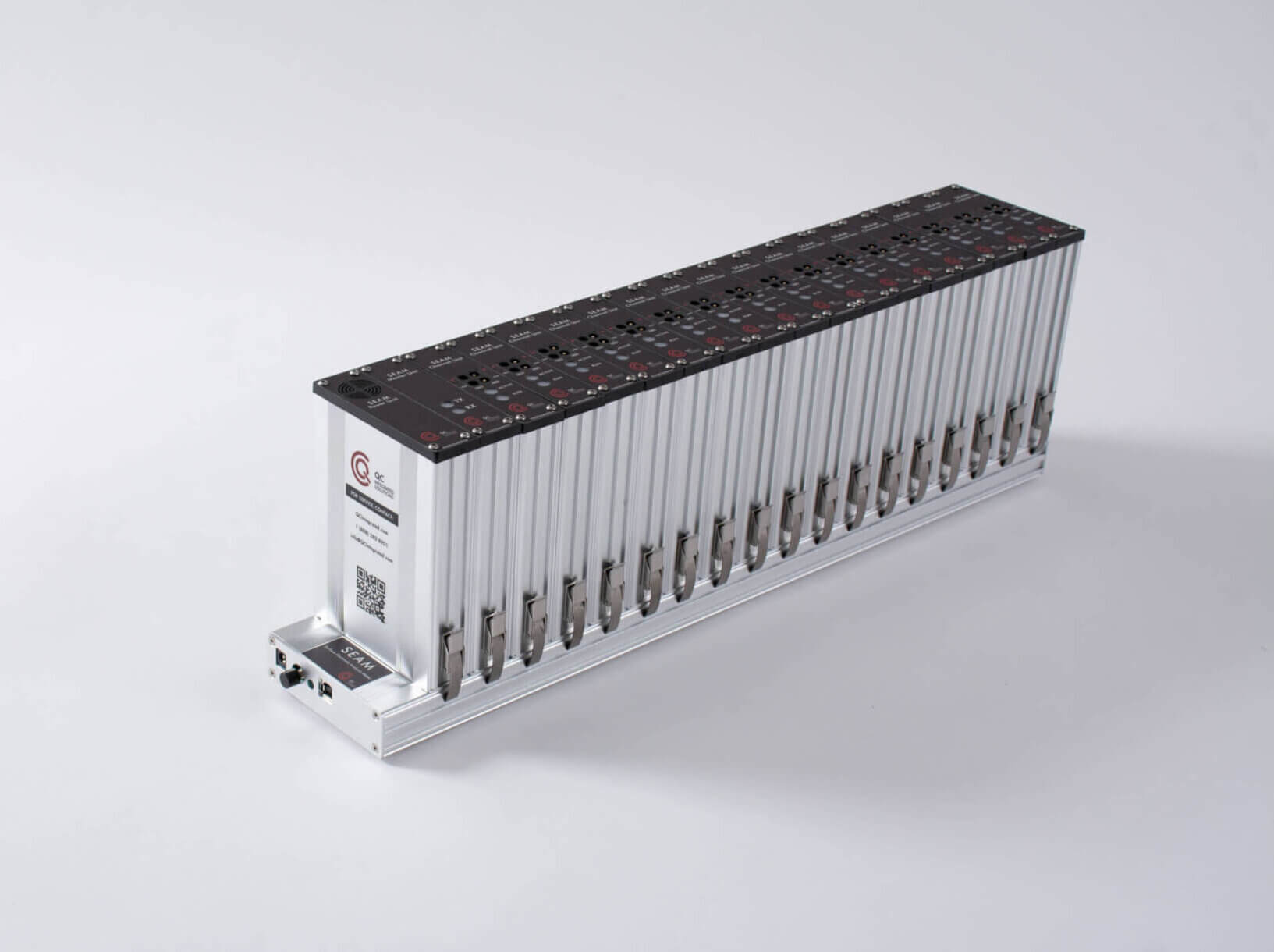
Resources
- SEAM ECG Application - v2.7.7
-
Software Installation
Software Installation for the SEAM ECG Test Platform
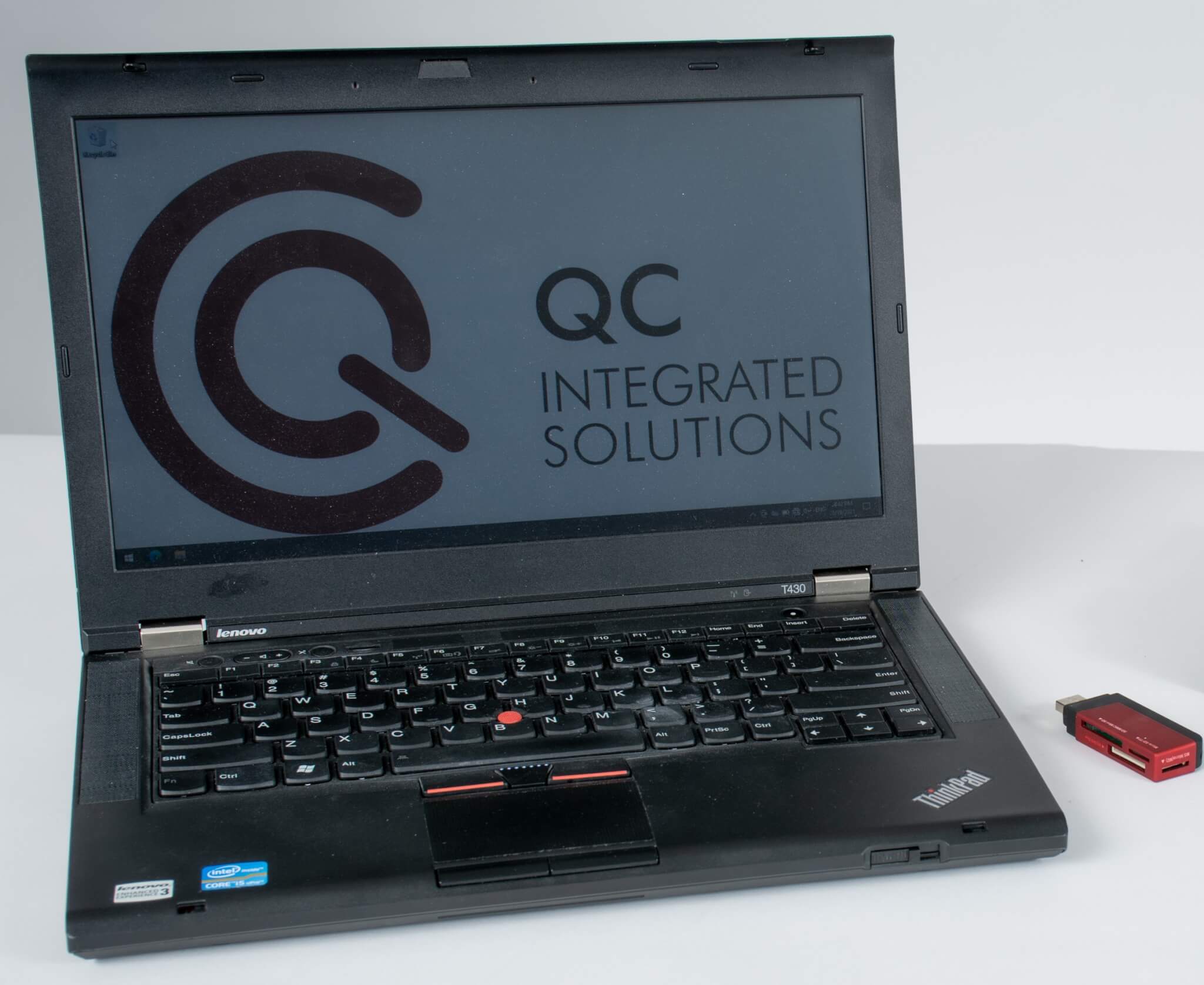 Step 1
Step 1Obtain a Windows PC with administrator rights.
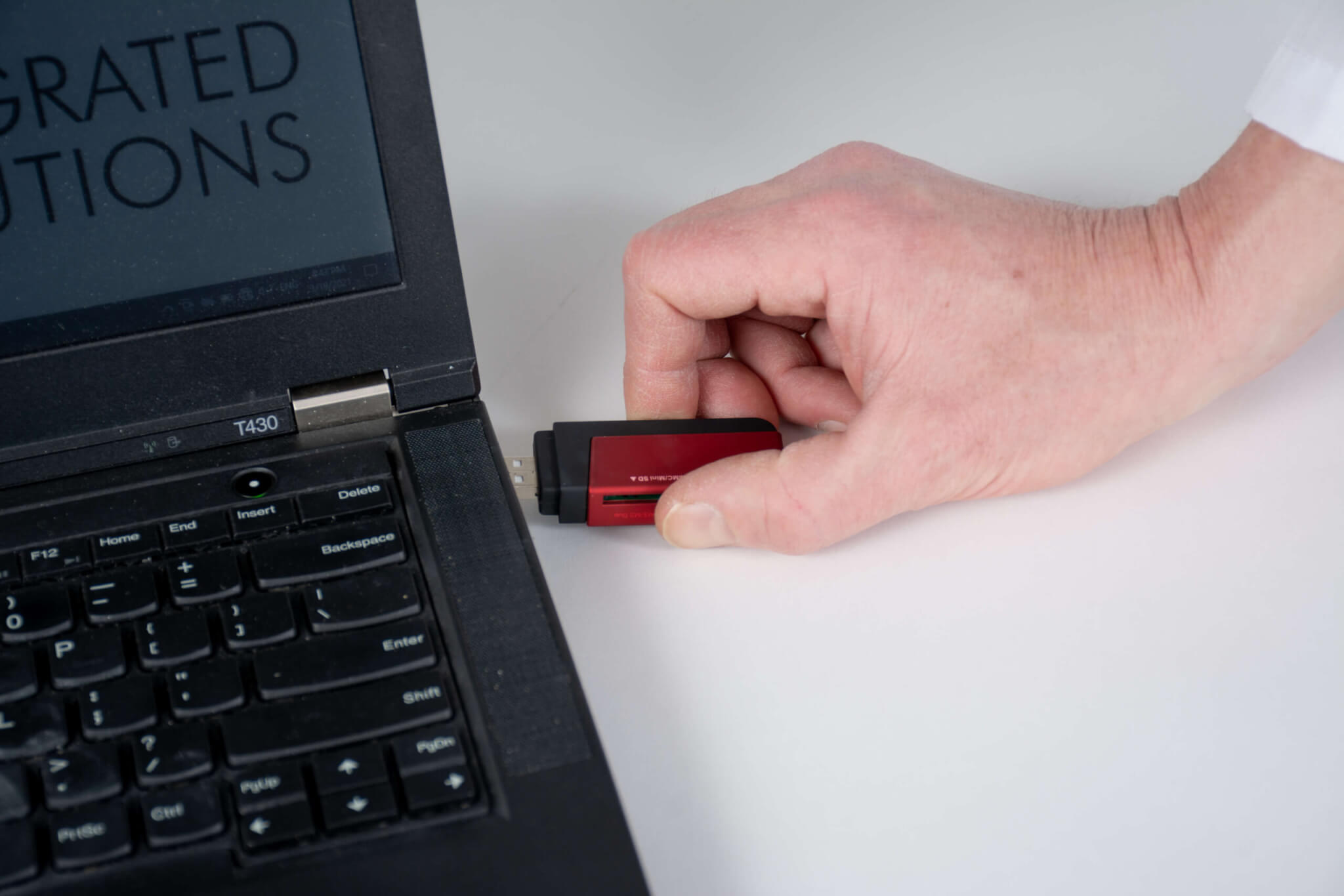 Step 2
Step 2Install USB drive included with SEAM hardware.
 Step 3
Step 3Navigate to "QC SEAM v* Setup" on the USB drive and double-click on it.
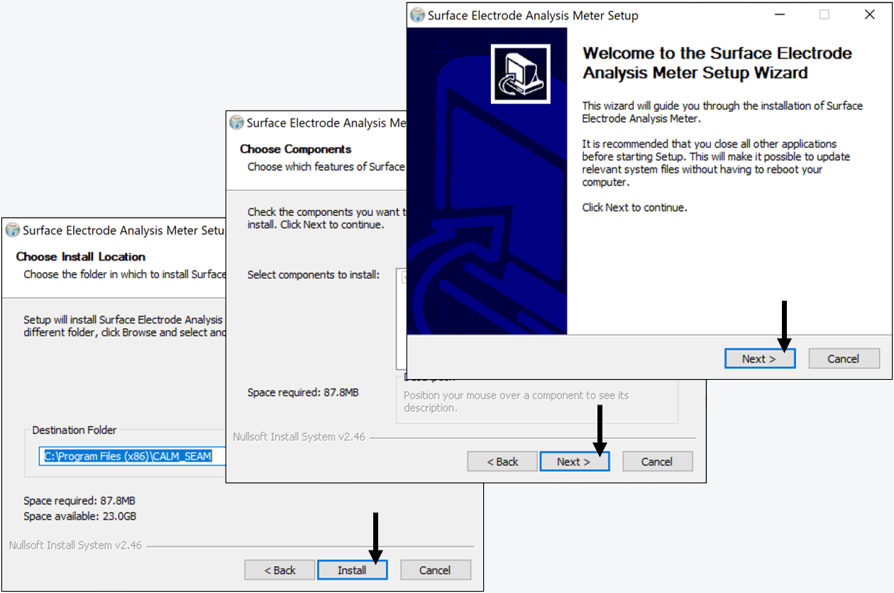 Step 4
Step 4Click "Next" twice and then click "Install".
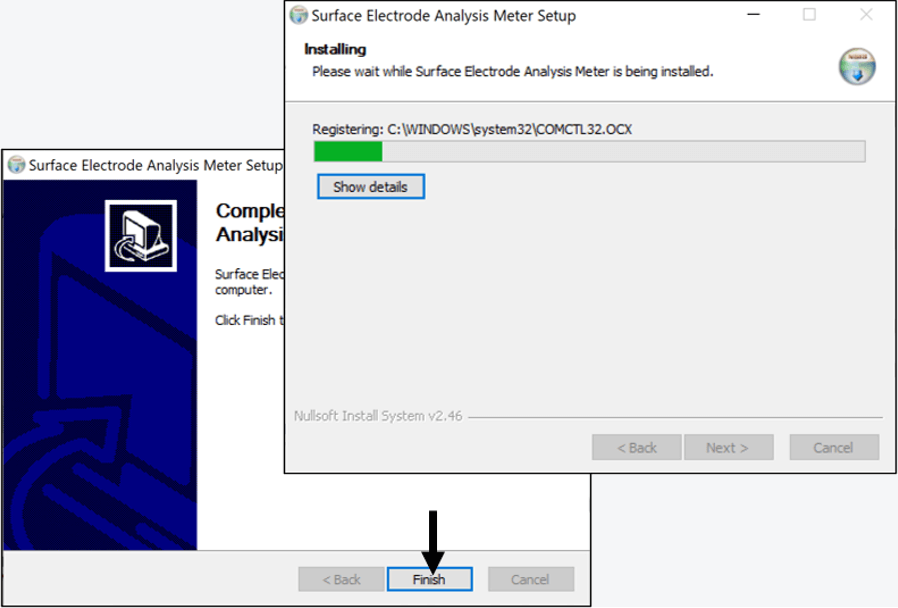 Step 5
Step 5Wait for the installation to complete and then click "Finish".
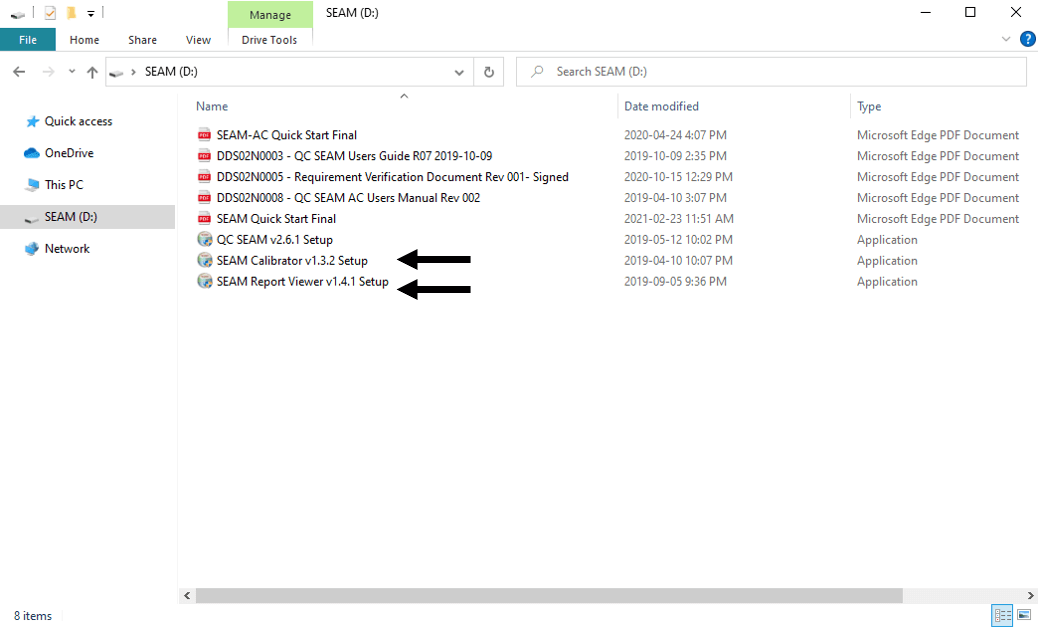 Step 6
Step 6Repeat this procedure with the other applications on the USB drive.
Step 7End of Procedure
-
Hardware Setup
Hardware Setup for the SEAM ECG Test Platform
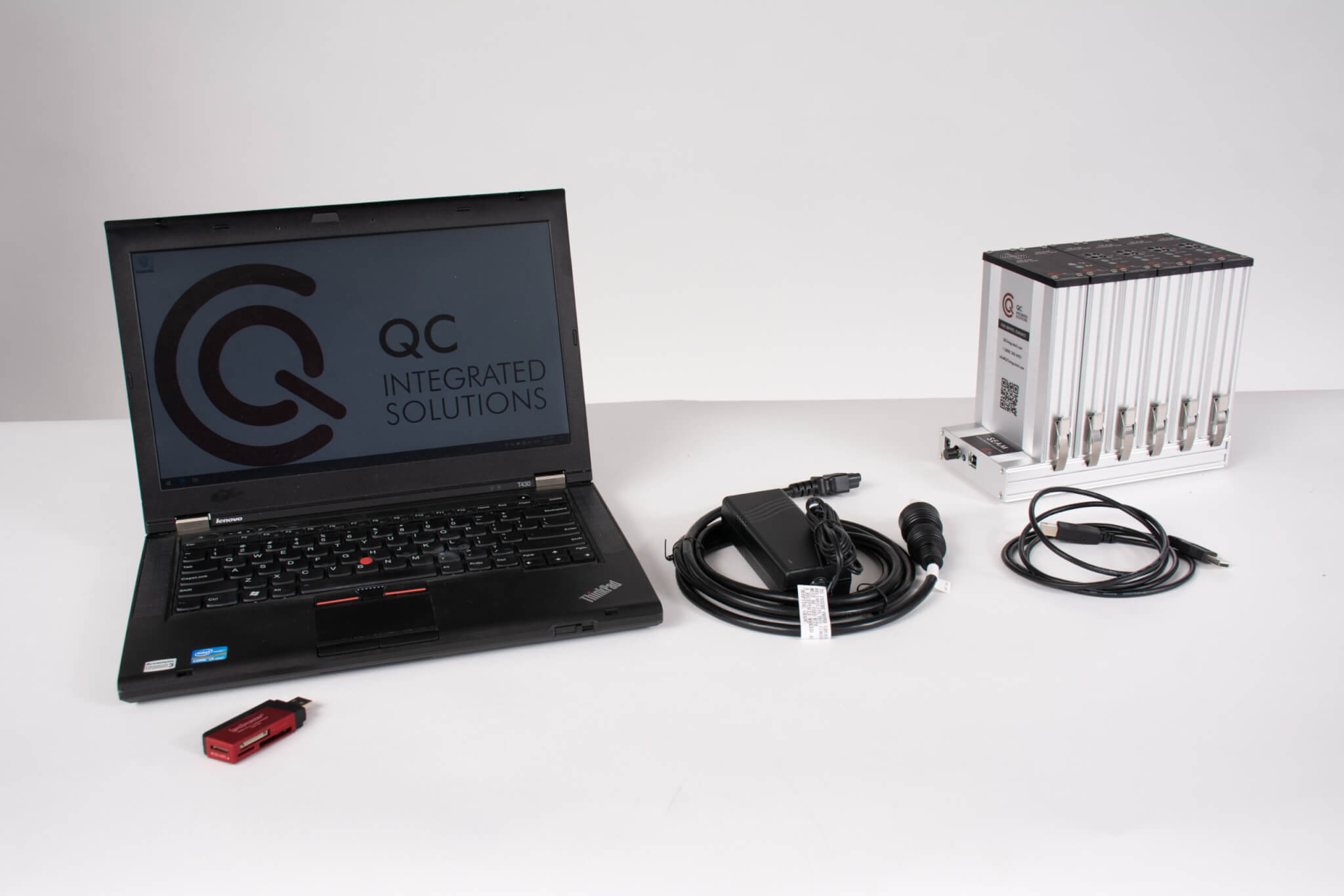 Step 1
Step 1Place laptop, SEAM tester and cables on table.
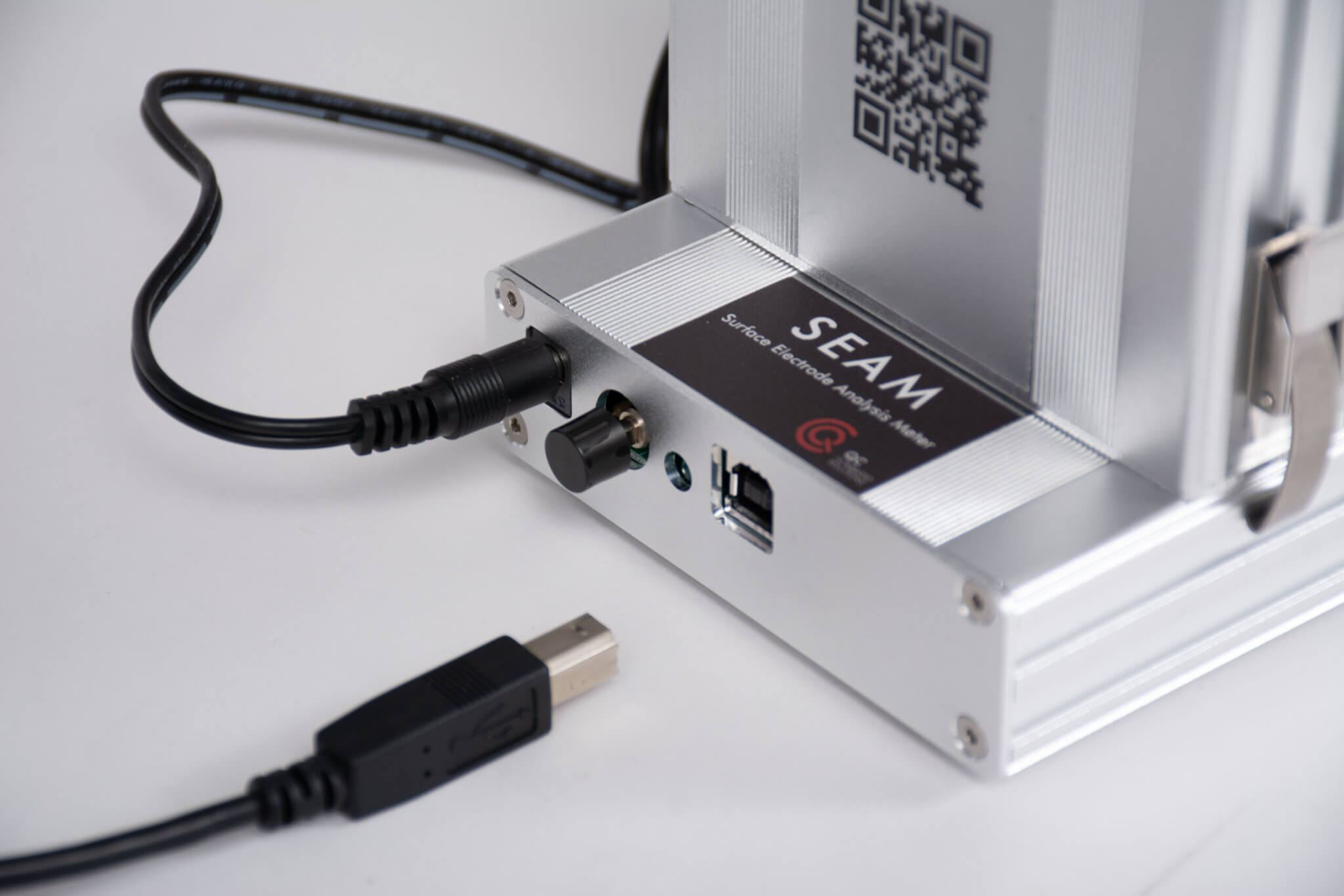 Step 2
Step 2Connect SEAM Tester to a wall outlet using the power cable.
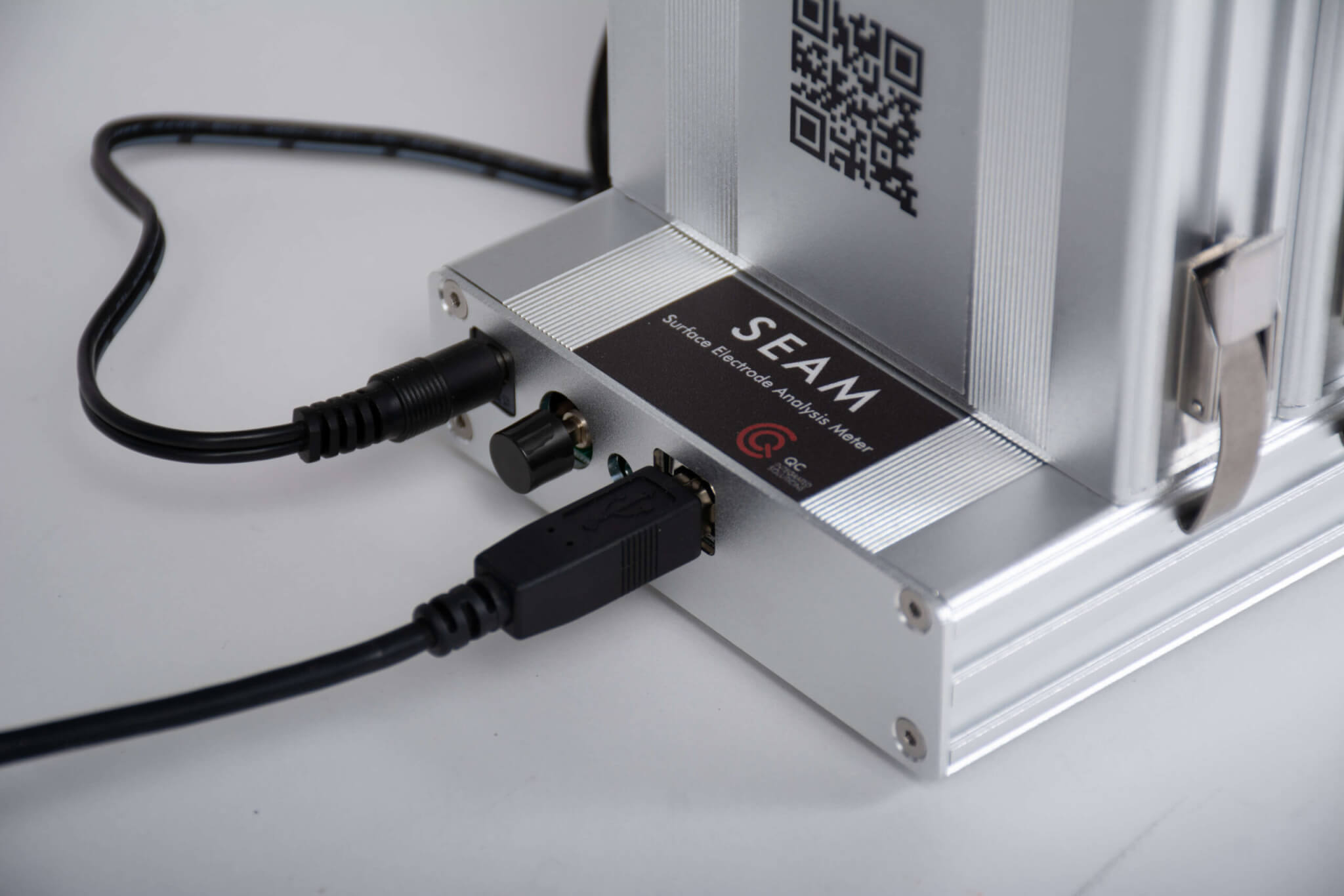 Step 3
Step 3Connect the SEAM Tester to the computer using the communications cable.
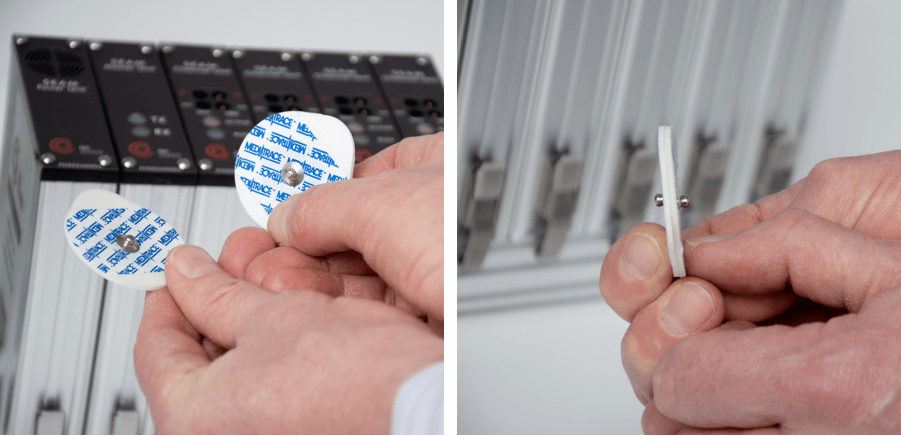 Step 4
Step 4Connect to ECG electrodes gel-to-gel.
Make sure there are no air bubbles trapped between gels. This can result in inaccurate readings
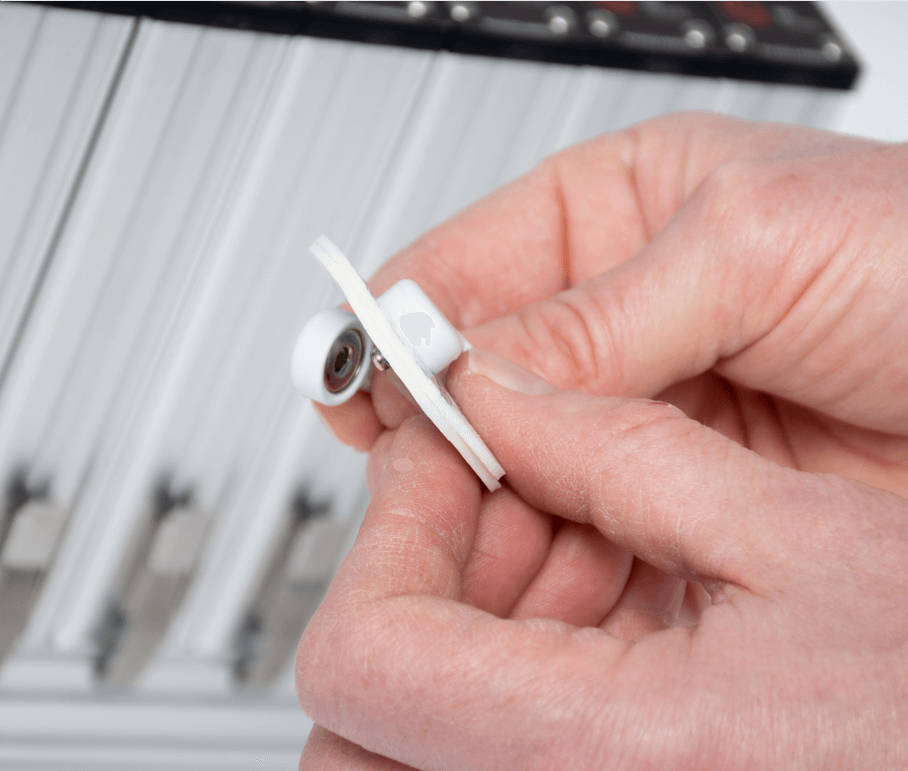 Step 5
Step 5Connect leadwires to electrode pair.
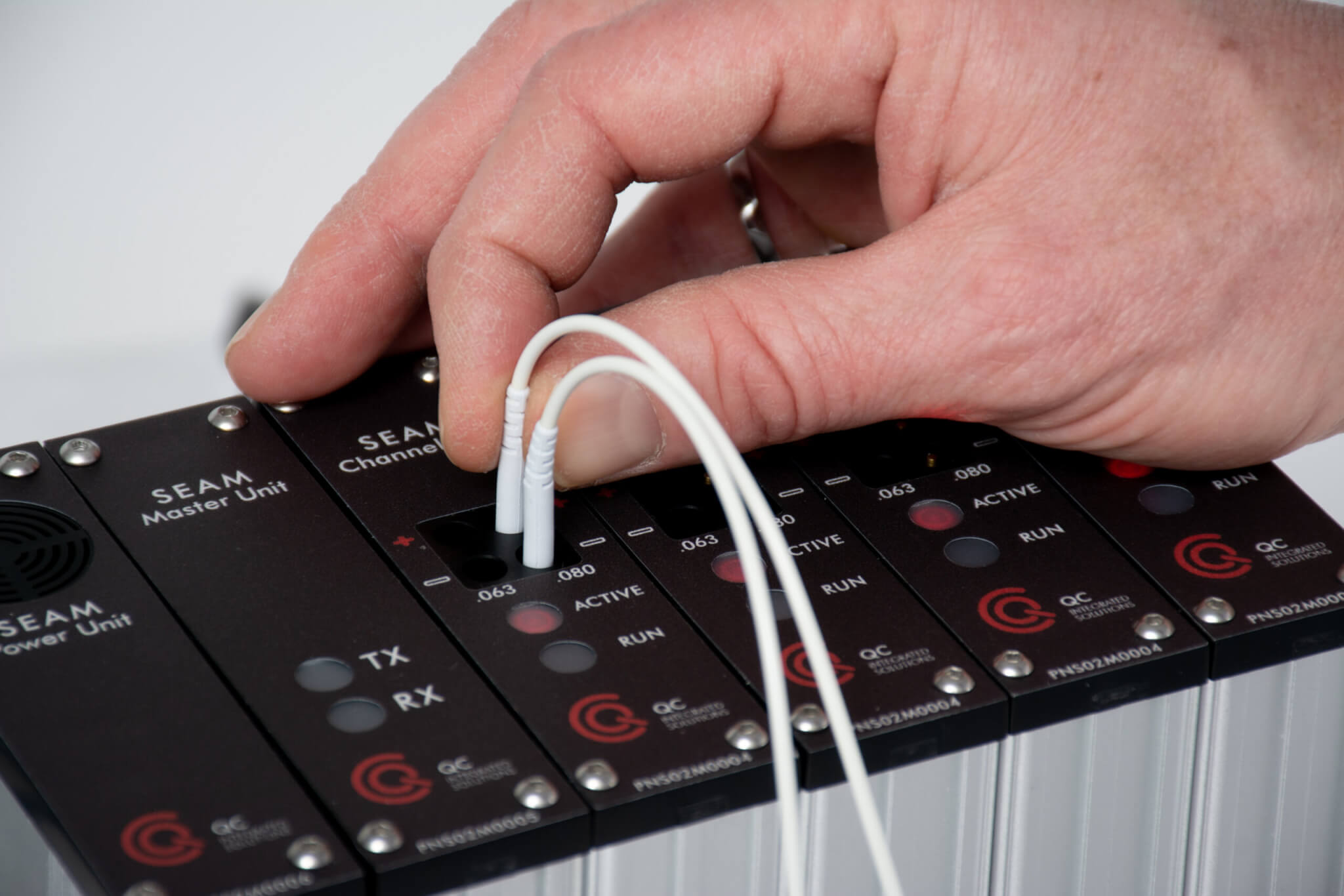 Step 6
Step 6Install leadwires in SEAM channel.
 Step 7
Step 7Repeat process with remaining electrodes and SEAM channels.
Not all SEAM channels need to be populated to run a test.
Step 8End of Procedure
-
Creating and Running a Test Sequence
Creating and Running a Test Sequence with the SEAM ECG Test Platform
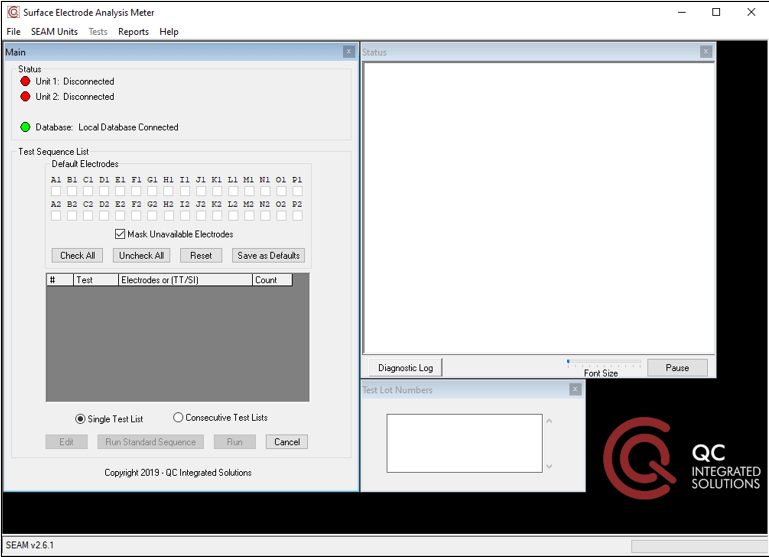 Step 1
Step 1Start the SEAM application.
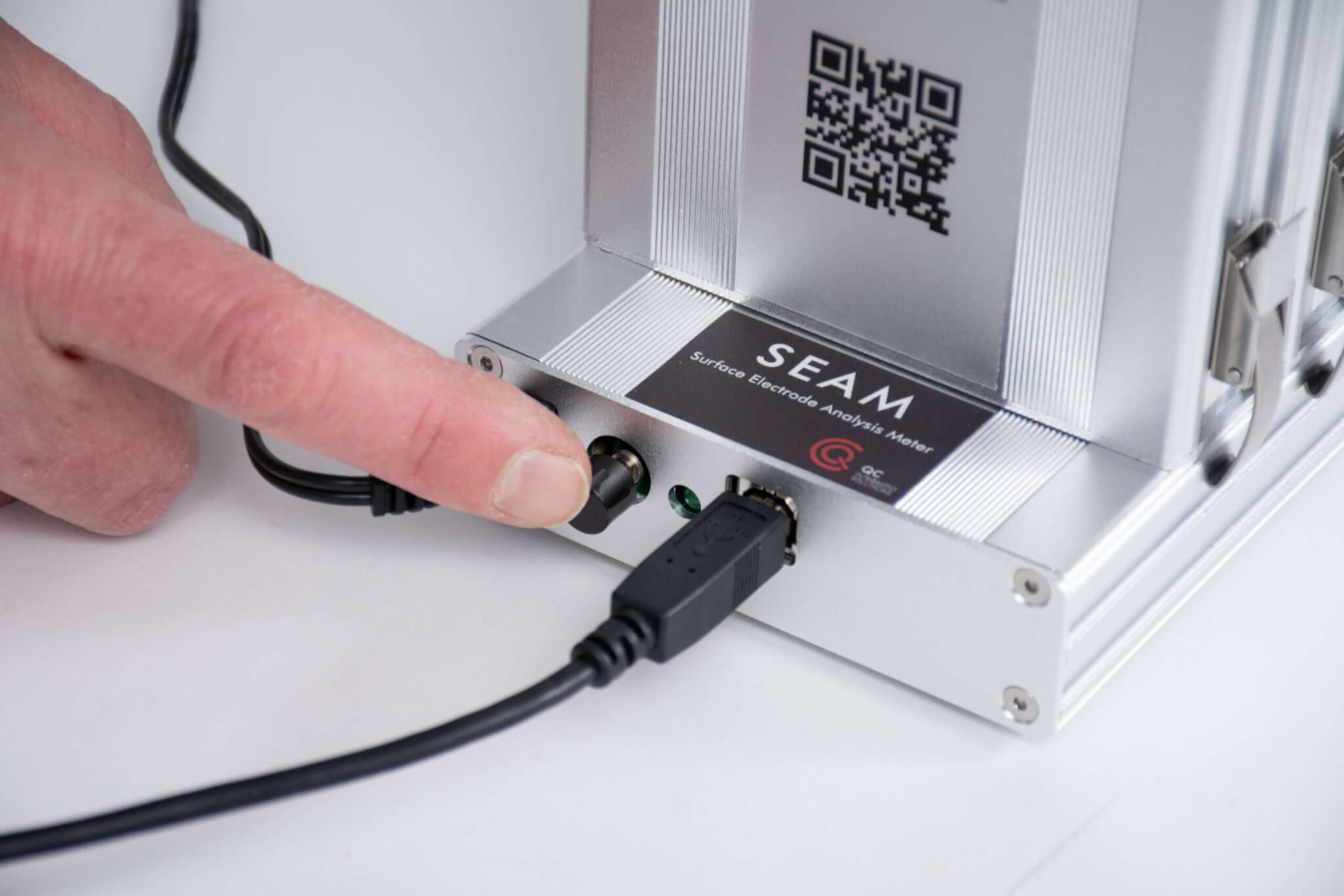 Step 2
Step 2Press the button on the SEAM Tester to turn the unit on.
When power is on:
- The light beside the button will be green.
- The fan on the Power Supply Module will be on.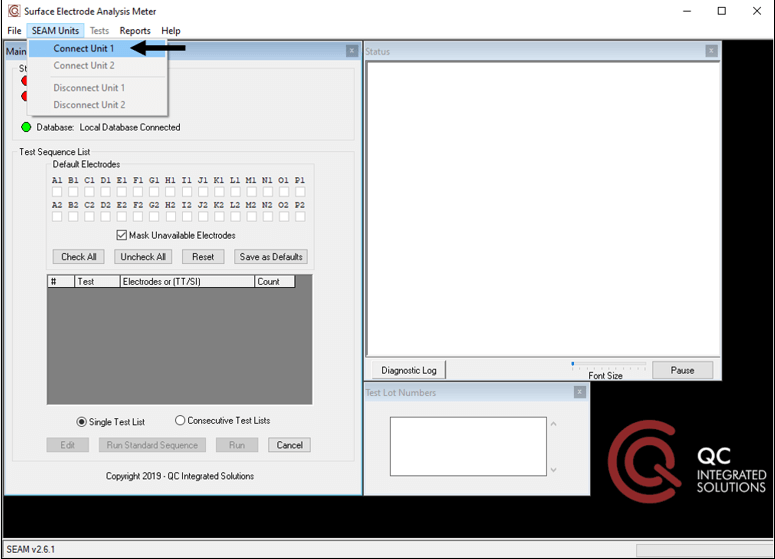 Step 3
Step 3Start the connection with the SEAM Tester.
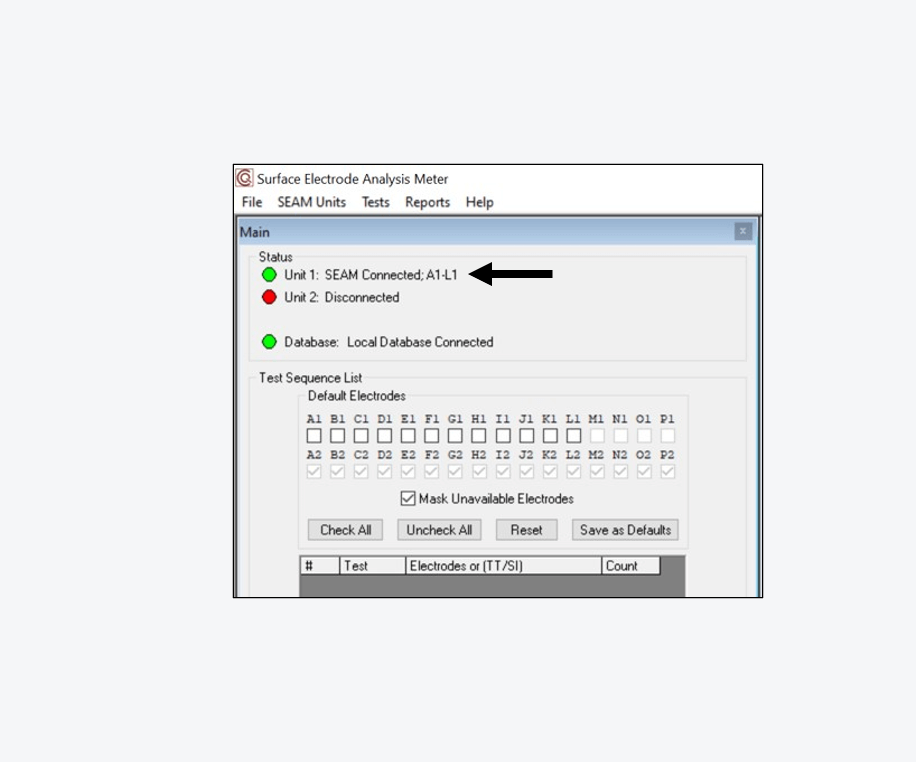 Step 4
Step 4Check that the connection was successful.
Step 5Wait for channel data to be read by application.
4 channels = wait 5 seconds
12 channels = wait 10 seconds
32 channels = wait 30 seconds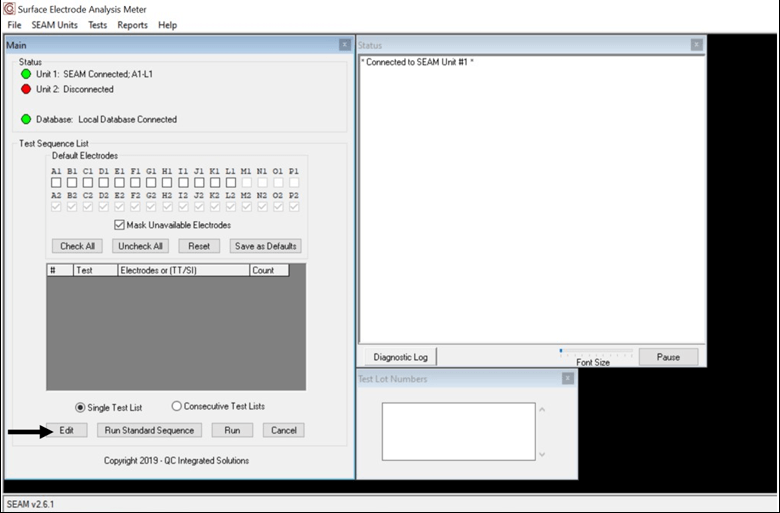 Step 6
Step 6Select the "Edit" button to open the Test Sequence Editor.
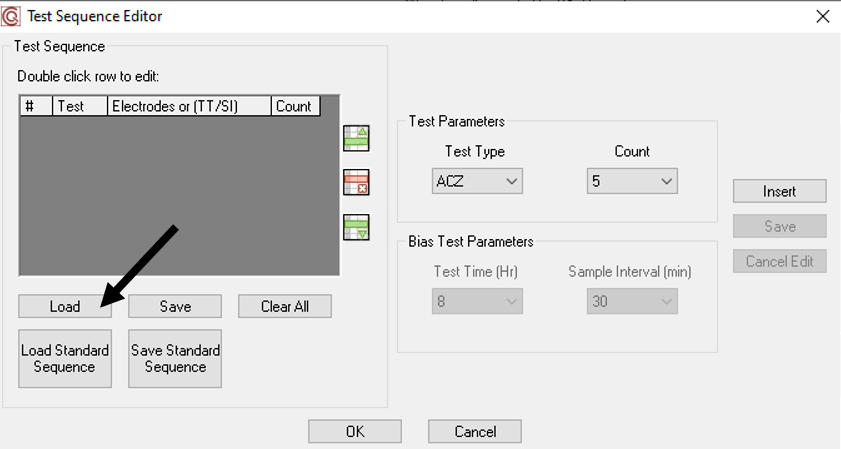 Step 7
Step 7You can load a saved test sequence using the "Load" button.
If this is your first time running the SEAM software, skip this step.
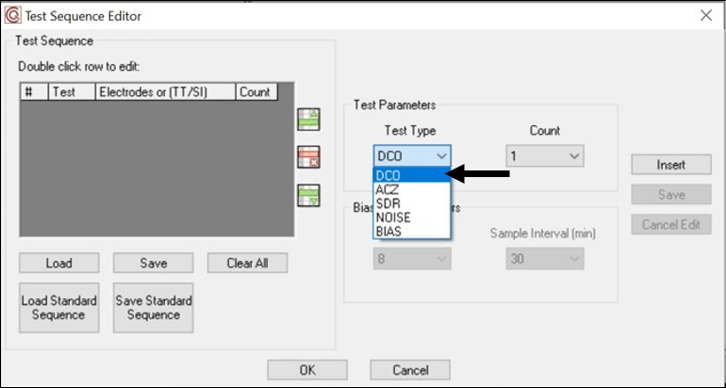 Step 8
Step 8To add a test, select the test type from the drop-down menu.
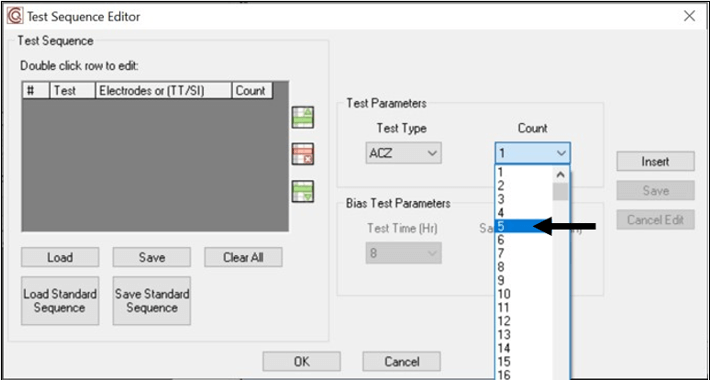 Step 9
Step 9Select the number of test repetitions from the drop-down menu.
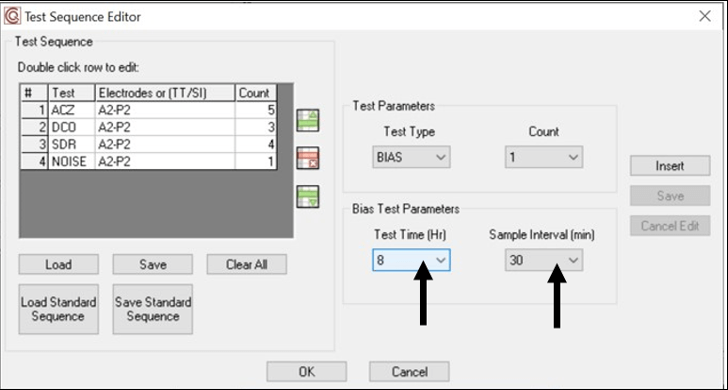 Step 10
Step 10When you choose a BIAS test, you will have to specify two additional parameters.
Test Time from 1 to 165 hours.
Sample Interval from 1 to 60 minutes.
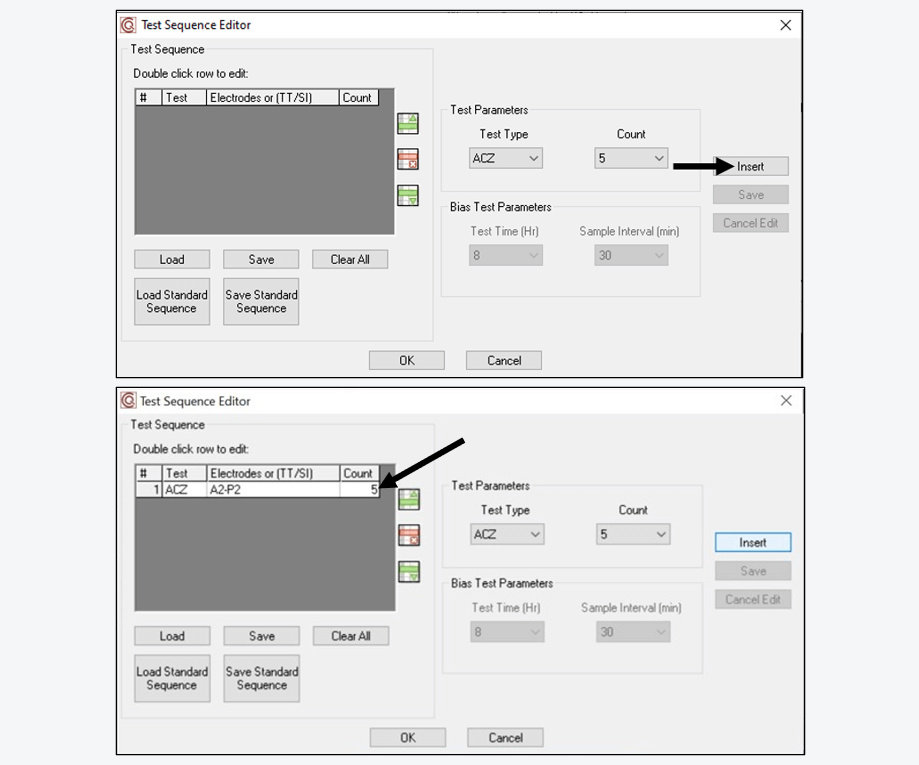 Step 11
Step 11Click "Insert" to add test to sequence.
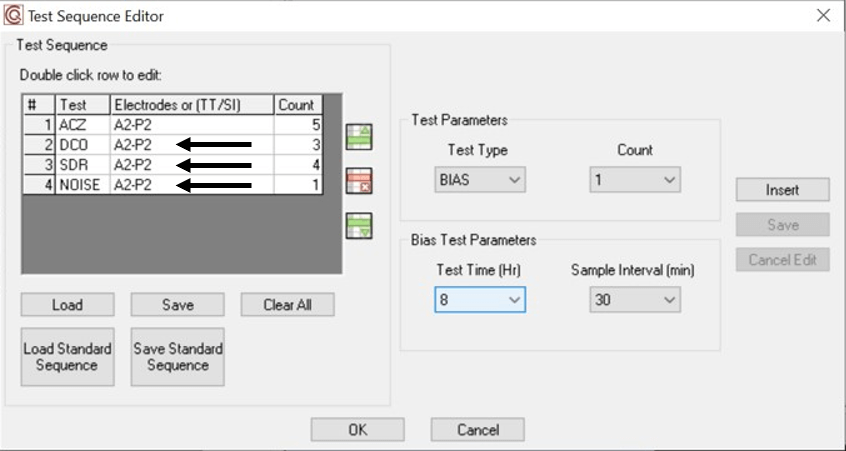 Step 12
Step 12Repeat this process to add more tests to the sequence.
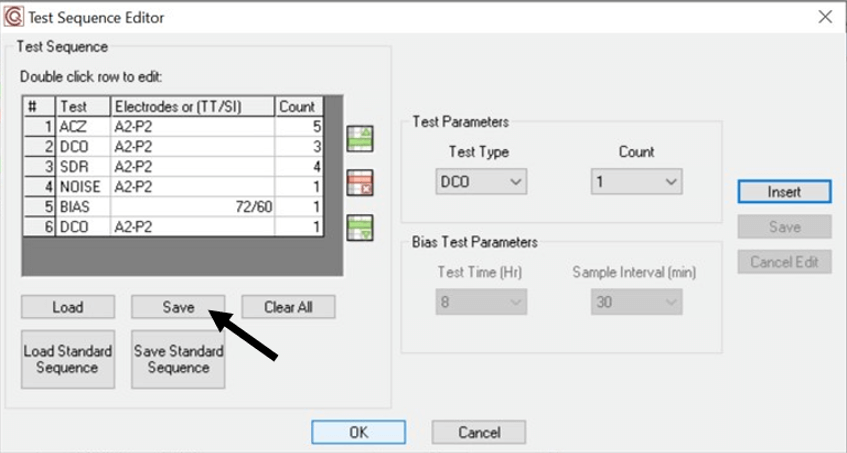 Step 13
Step 13Click the "Save" button if you would like to reuse your test sequence at a later time.
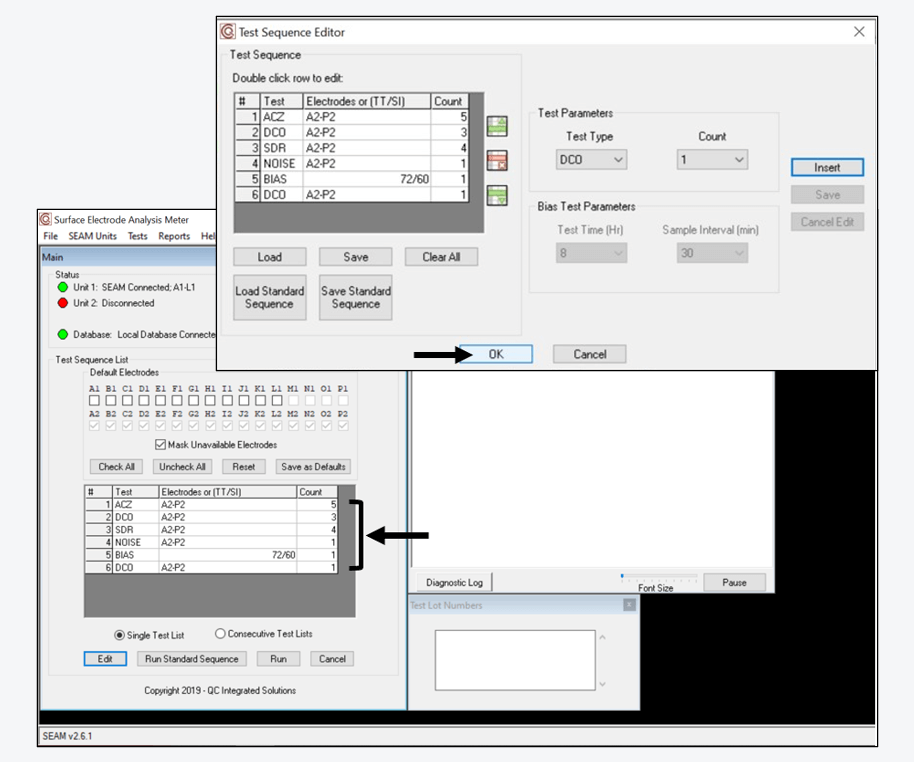 Step 14
Step 14Click "OK" and observe that the test sequence has been loaded into the main window.
 Step 15
Step 15Select the channels you wish to run and then click "Set as Defaults".
Make sure that the selected channels have electrode pairs installed. If not, the test report will record the unpopulated channels as failures.
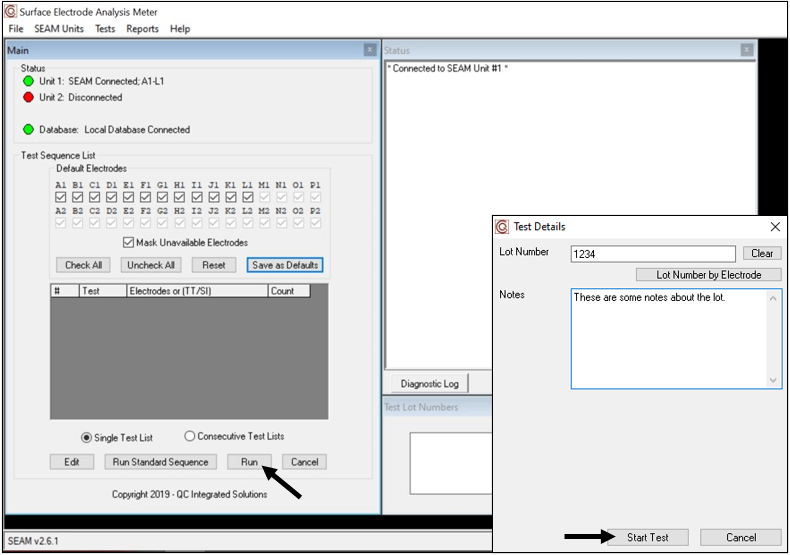 Step 16
Step 16Click "Run" in the main window and then "Start Test" in the Test Details window.
You can add a lot number and notes for the lot. This information will be included in the test report.
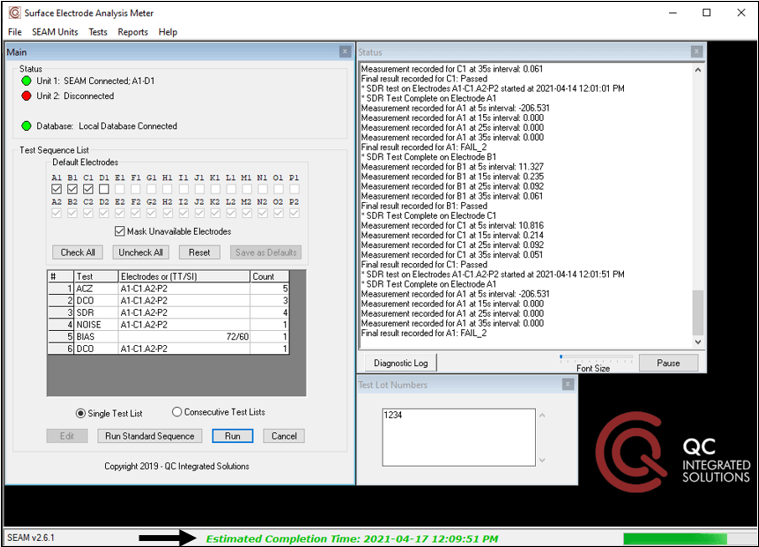 Step 17
Step 17Wait for the test to complete.
The expected completion time is displayed at the bottom of the window.
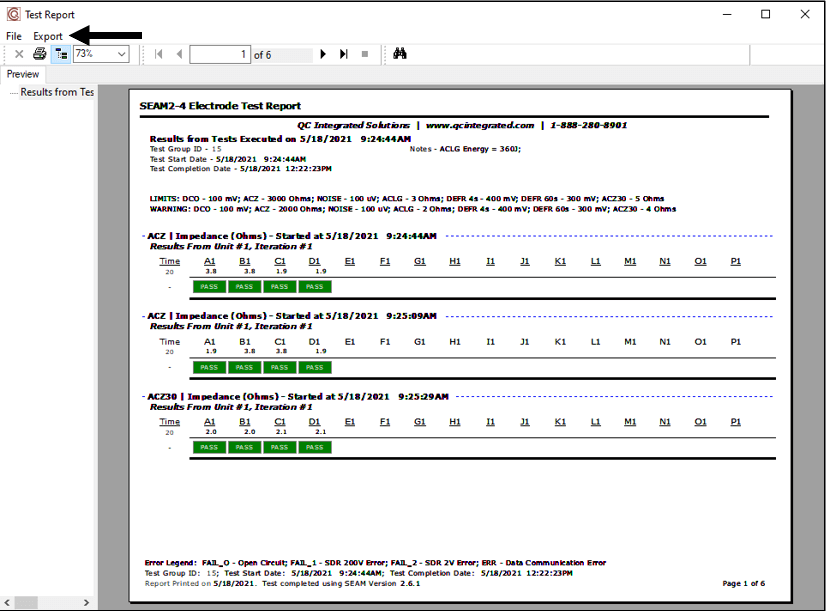 Step 18
Step 18Once complete, the test report will be displayed.
You can use the Export tab to save the data in the format of your choosing.
Step 19End of Procedure
SEAM ECG Channel Calibration
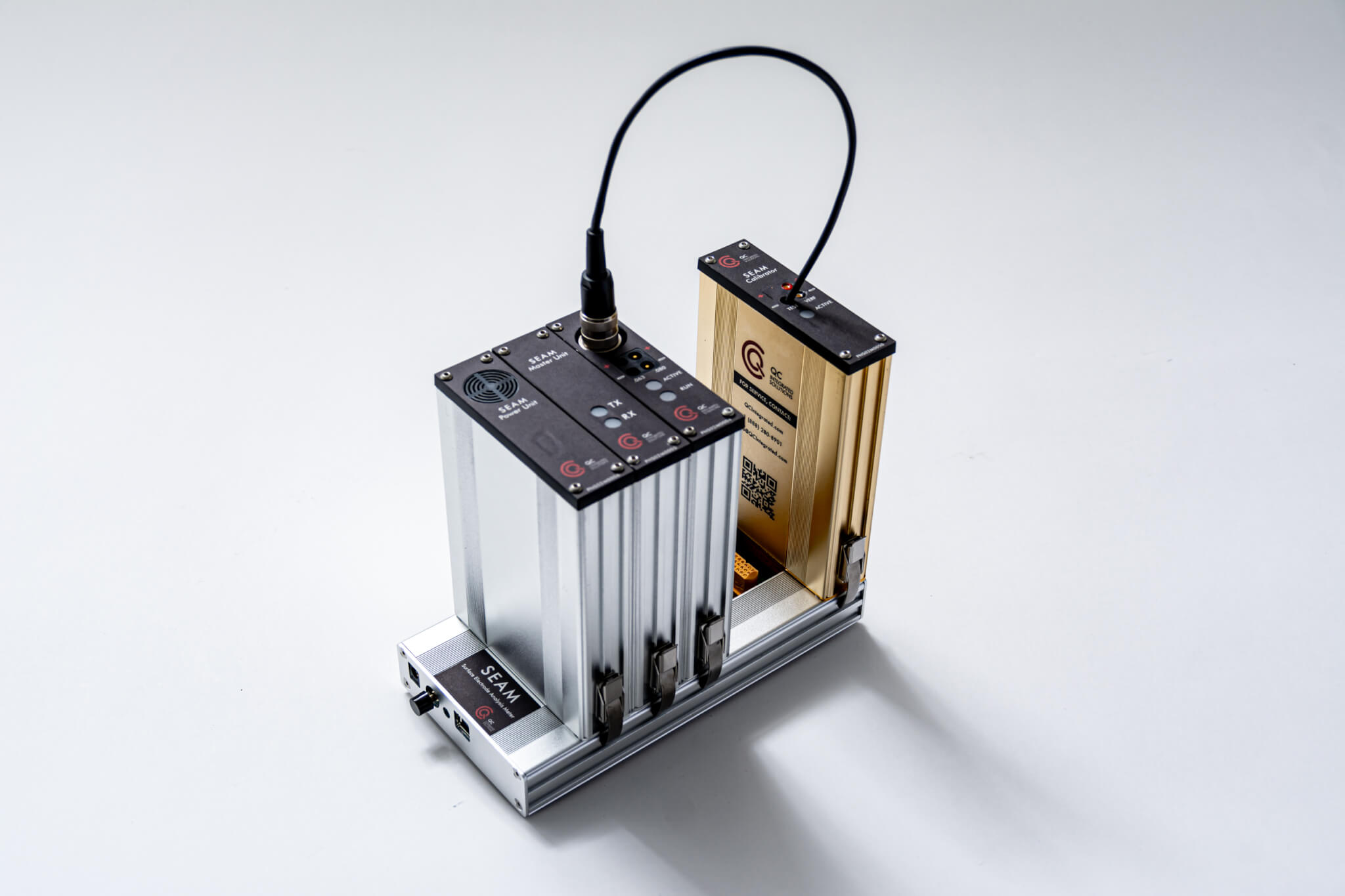
Resources
- SEAM Calibrator Client - v1.4.3
-
Software Installation
Software Installation for the SEAM-AC(P) Calibrator
 Step 1
Step 1Obtain a Windows PC with administrator rights.
 Step 2
Step 2Install USB drive included with SEAM-AC(P) hardware.
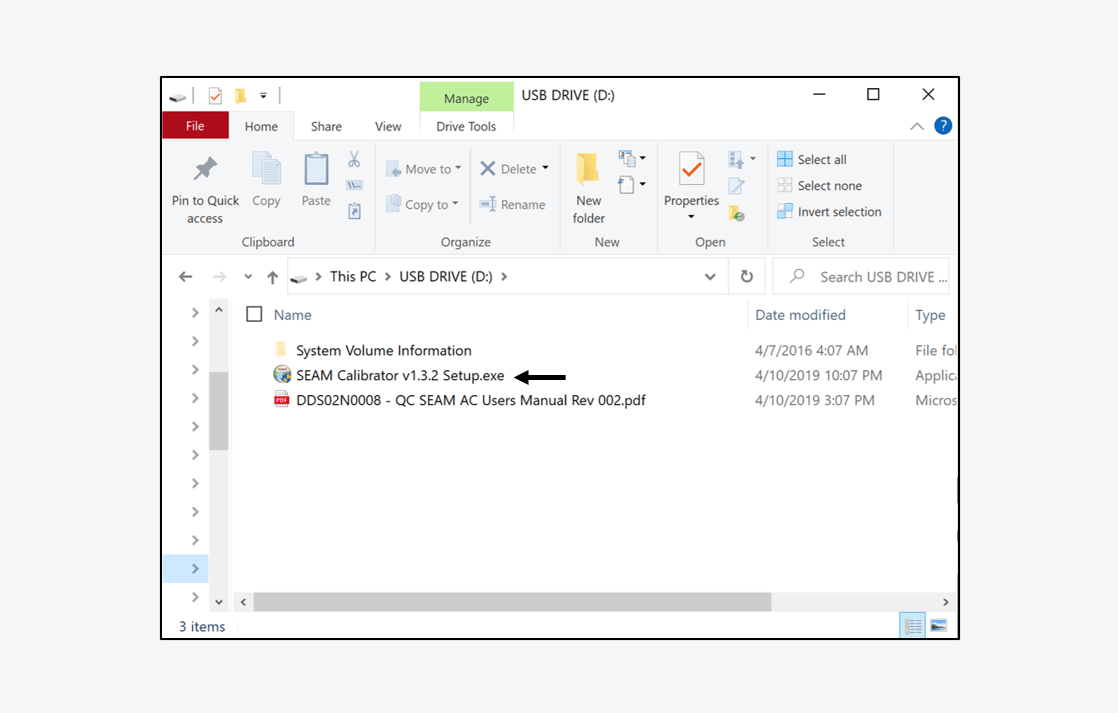 Step 3
Step 3Navigate to "SEAM Calibrator v* Setup" on the USB drive and double-click on it.
 Step 4
Step 4Click "Next" twice and then click "Install".
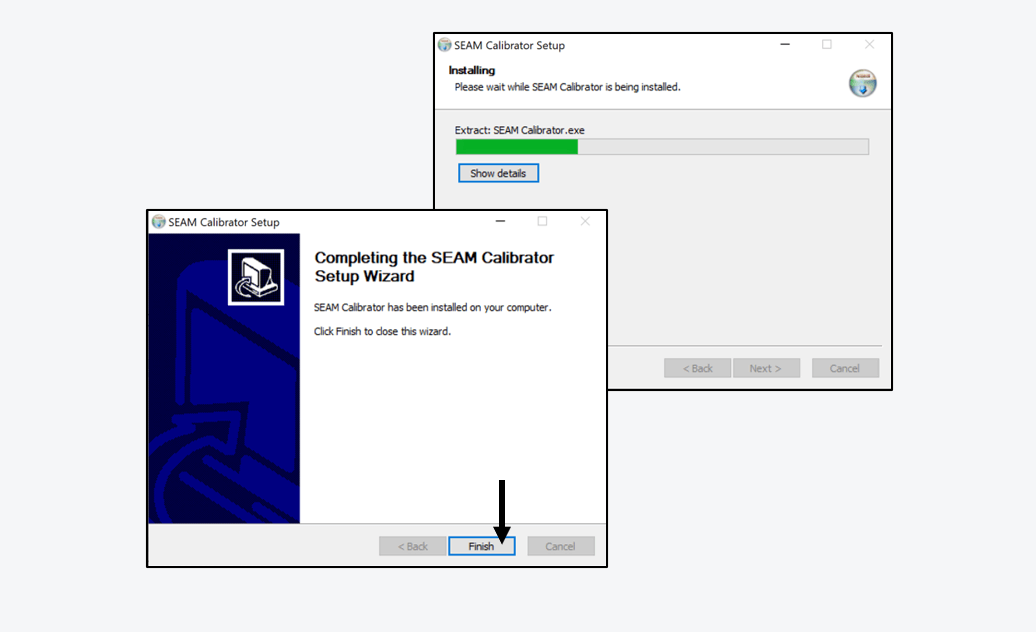 Step 5
Step 5Wait for the installation to complete and then click "Finish".
Step 6End of Procedure
-
Logging on to the Calibration Server
Logging on to the SEAM Calibration Server
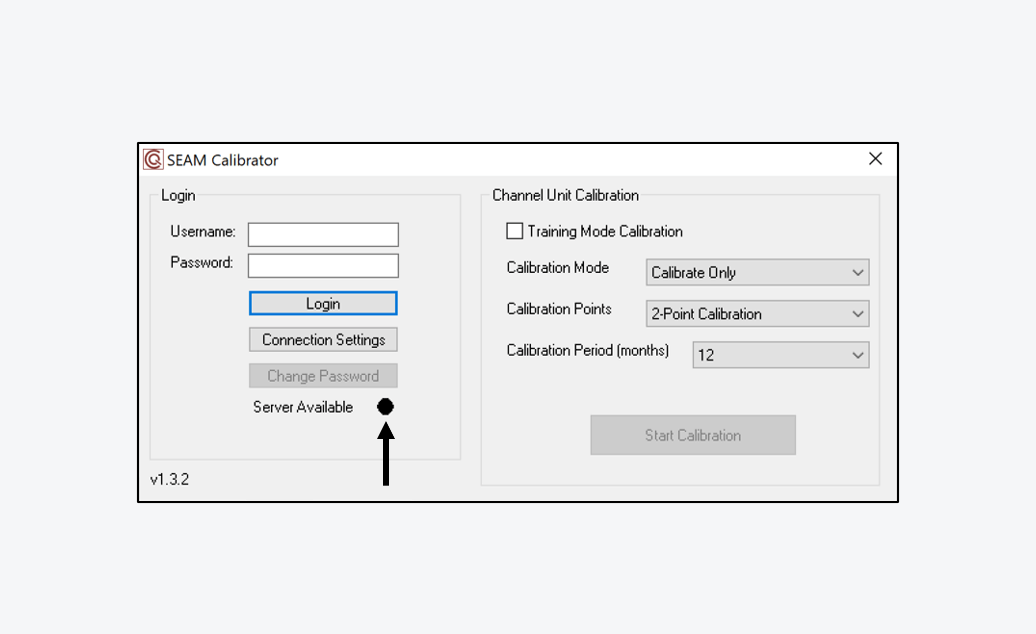 Step 1
Step 1Open the SEAM Calibrator application.
The black "Server Available" indicator shows that there is no connection with the calibration server.
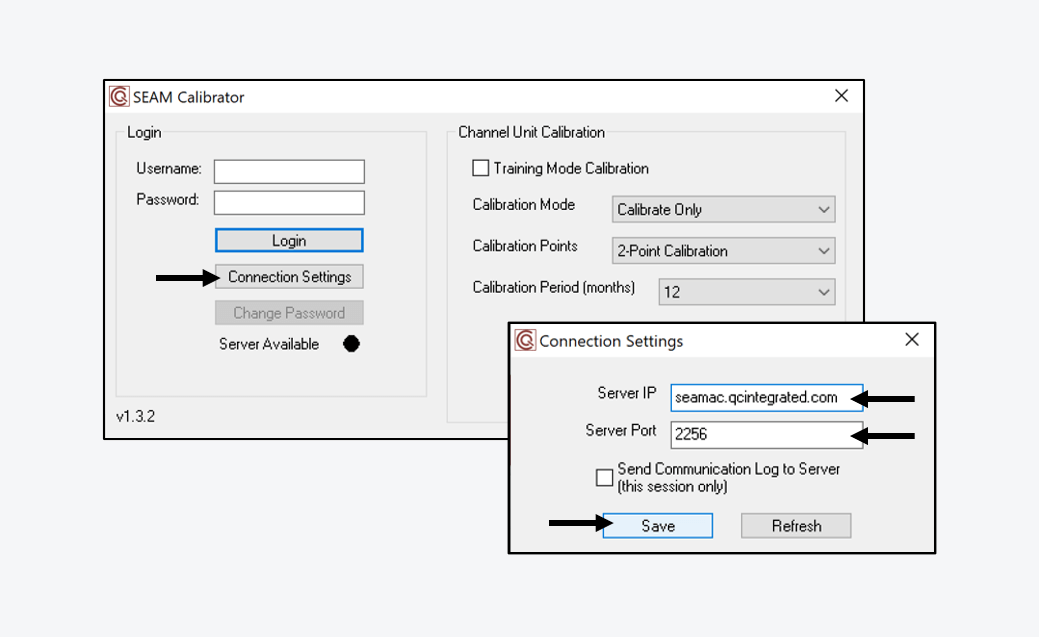 Step 2
Step 2Select "Connection Settings" and update the IP and Port fields.
Server IP = seamac.qcintegrated.com
Server Port = 2256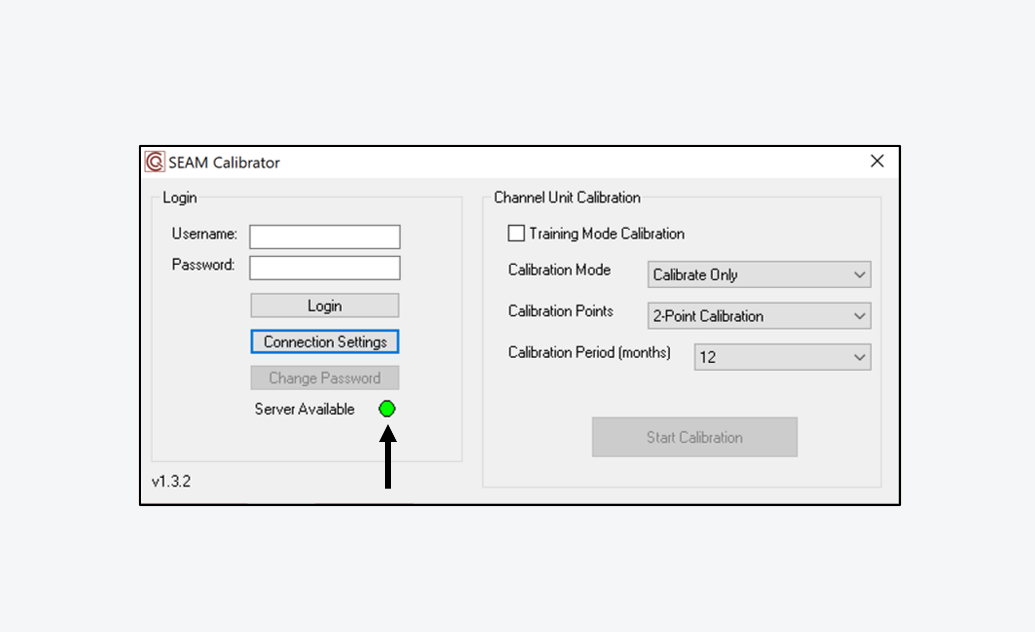 Step 3
Step 3If the connection was successful, then the "Server Available" indicator will turn green.
If the connection was unsuccessful, the "Server Available" indicator will remain black.
The firewall for either the computer or network is often the source of this issue.
Contact your IT department.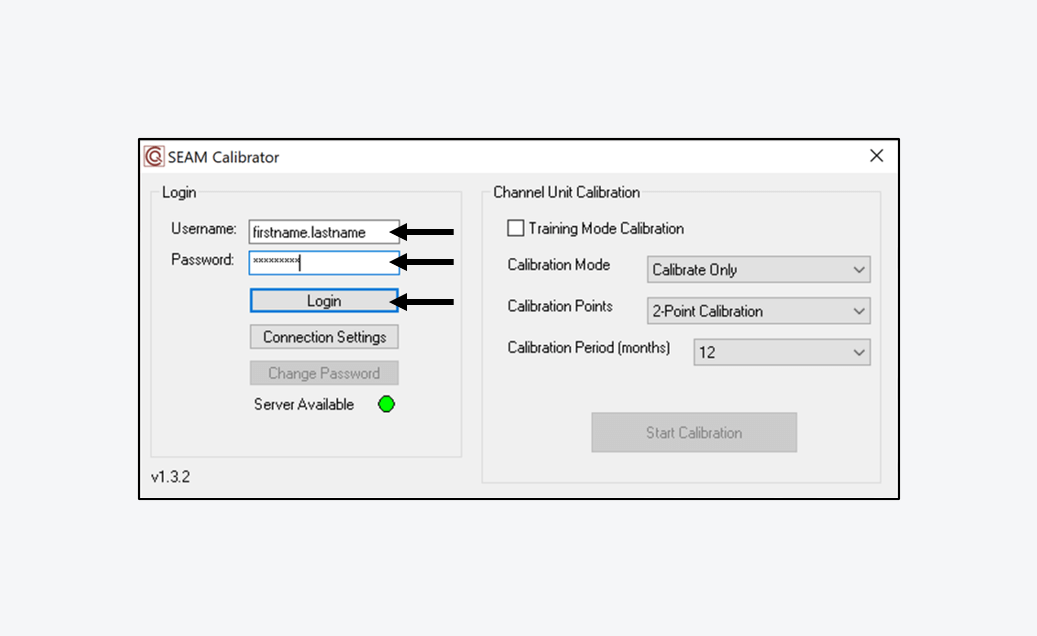 Step 4
Step 4Input the username and password and click "Login".
If you do not have a username and password, please contact info@qcintegrated.com.
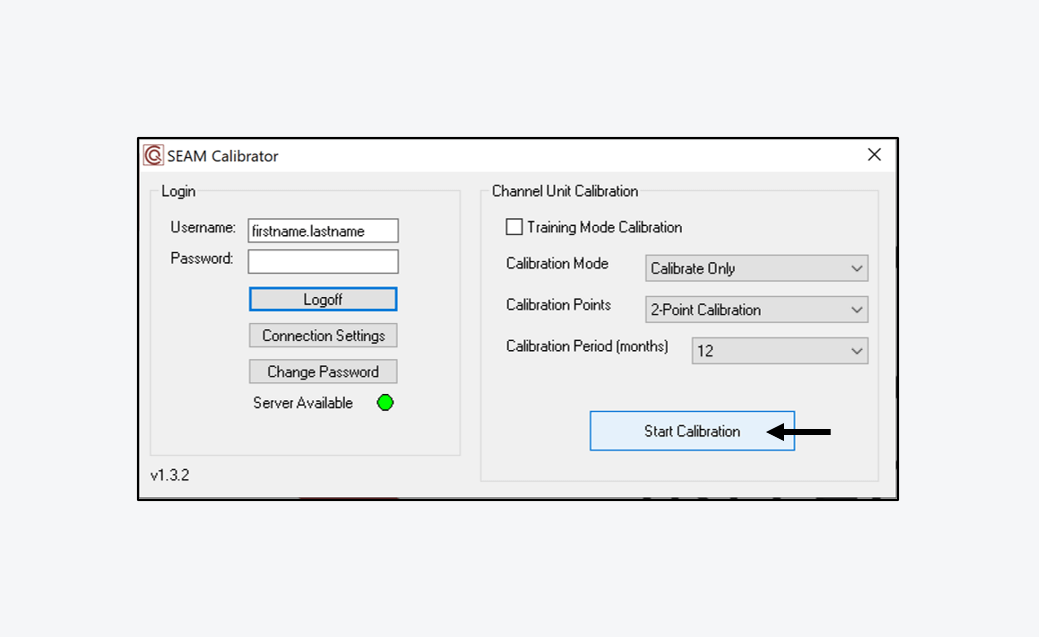 Step 5
Step 5You have successfully logged in to the Calibration Server when the "Start Calibration" button is enabled.
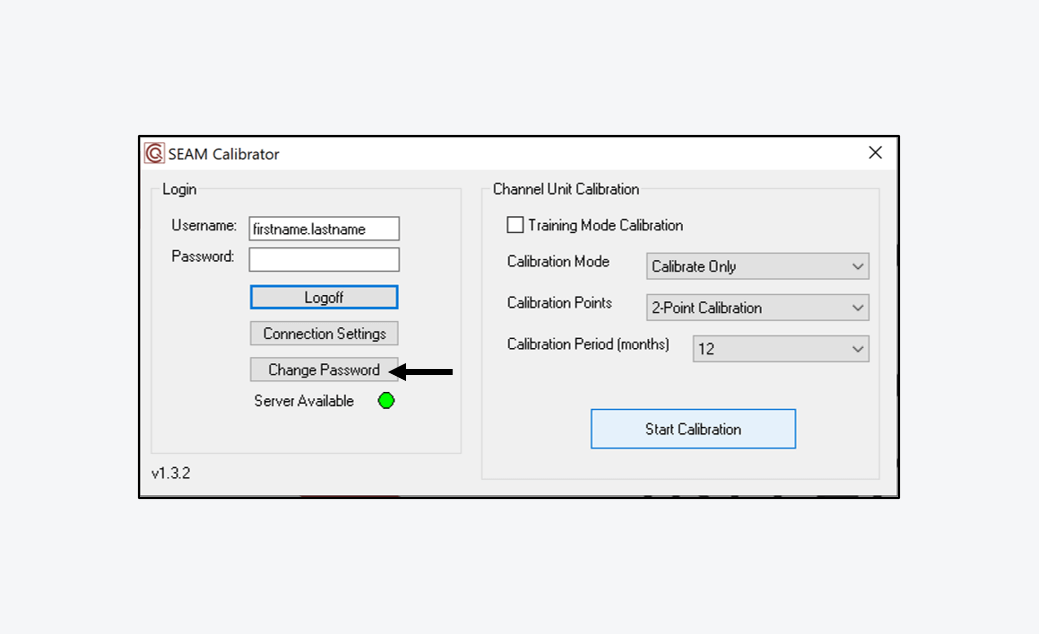 Step 6
Step 6You have the option to update your password once logged in.
Step 7End of Procedure
-
Calibration with the SEAM-ACP (gold)
Channel Calibration with the SEAM-ACP (gold)
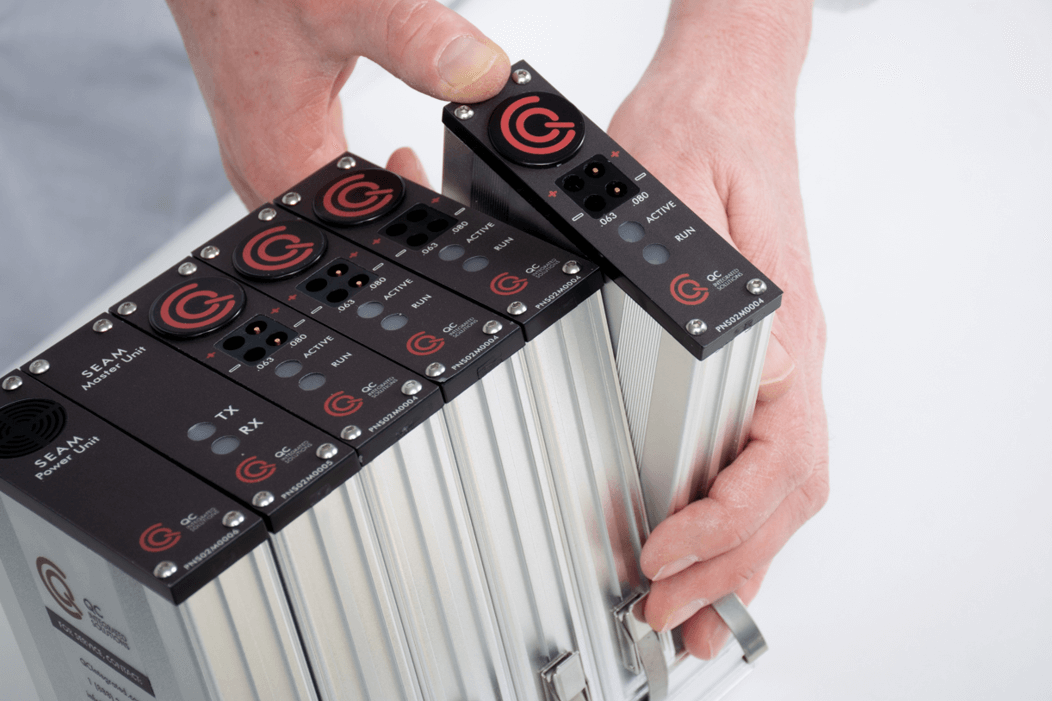 Step 1
Step 1Remove all Channels from the Bus.
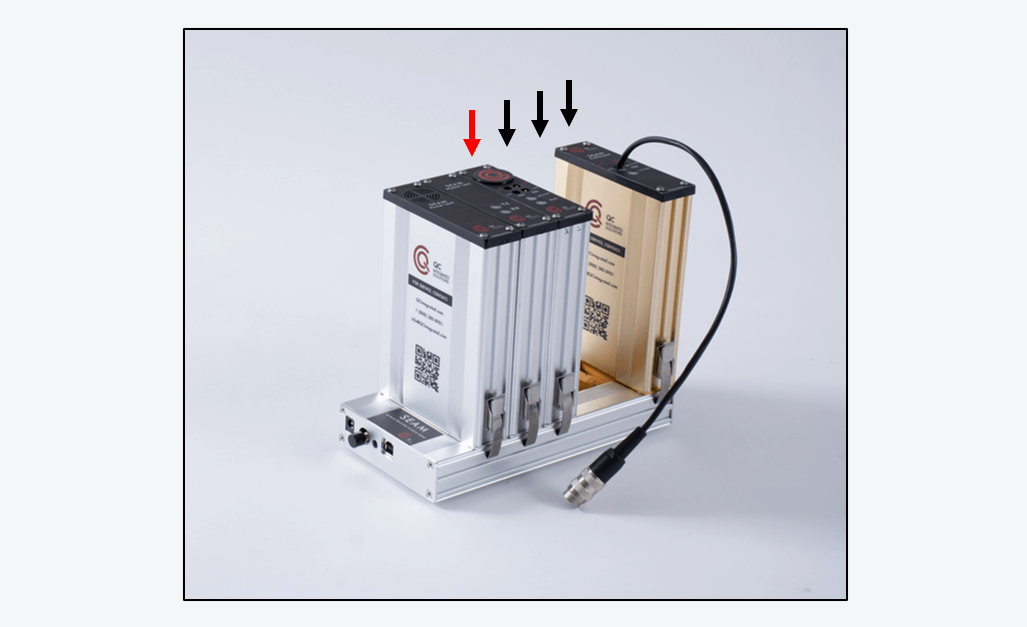 Step 2
Step 2Install the Channel you wish to calibrate into Slot 1.
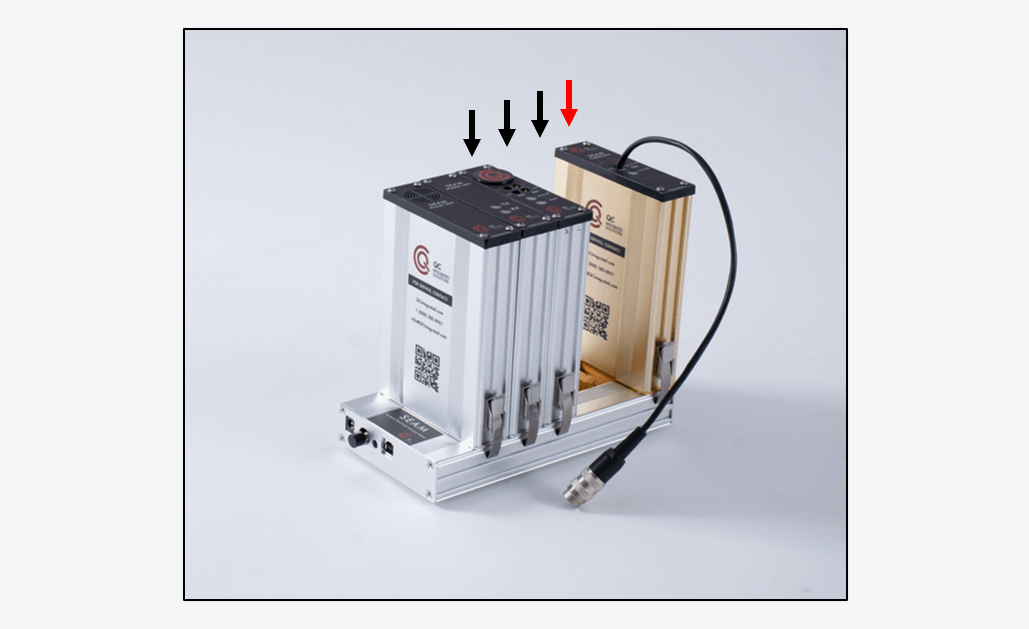 Step 3
Step 3Install the SEAM-ACP into Slot 4.
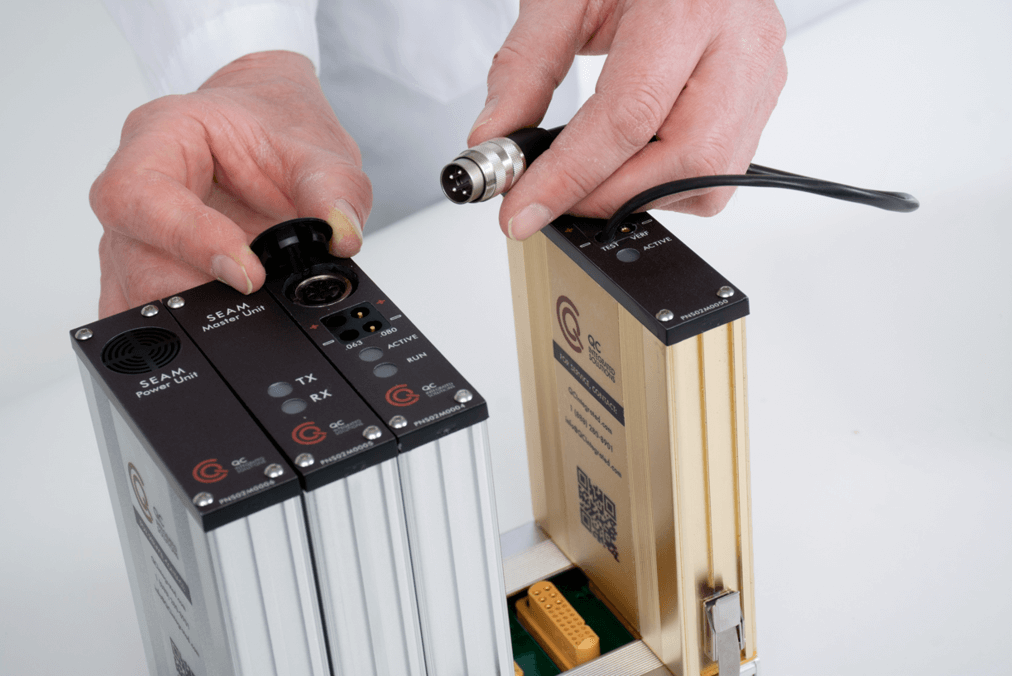 Step 4
Step 4Remove the cap from the Channel.
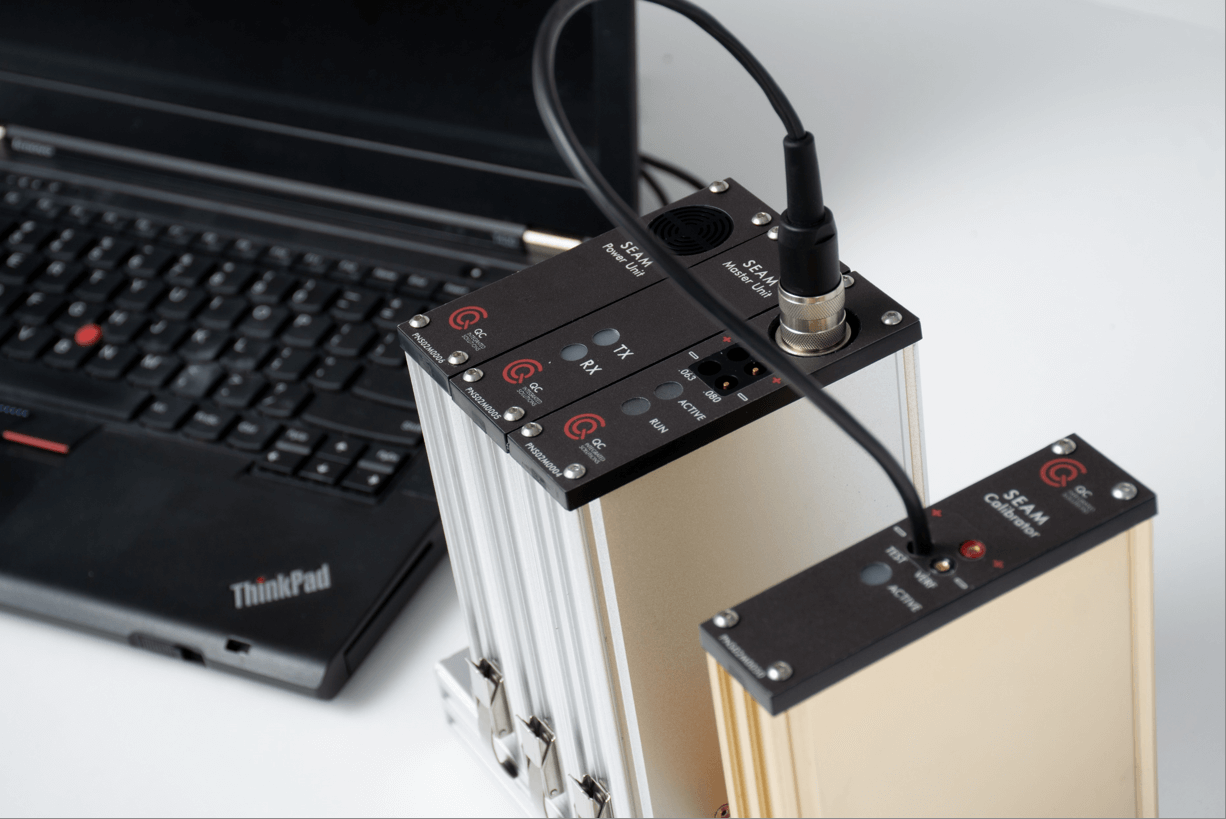 Step 5
Step 5Screw the SEAM-ACP connector on to the Channel connector.
 Step 6
Step 6Power up the SEAM tester.
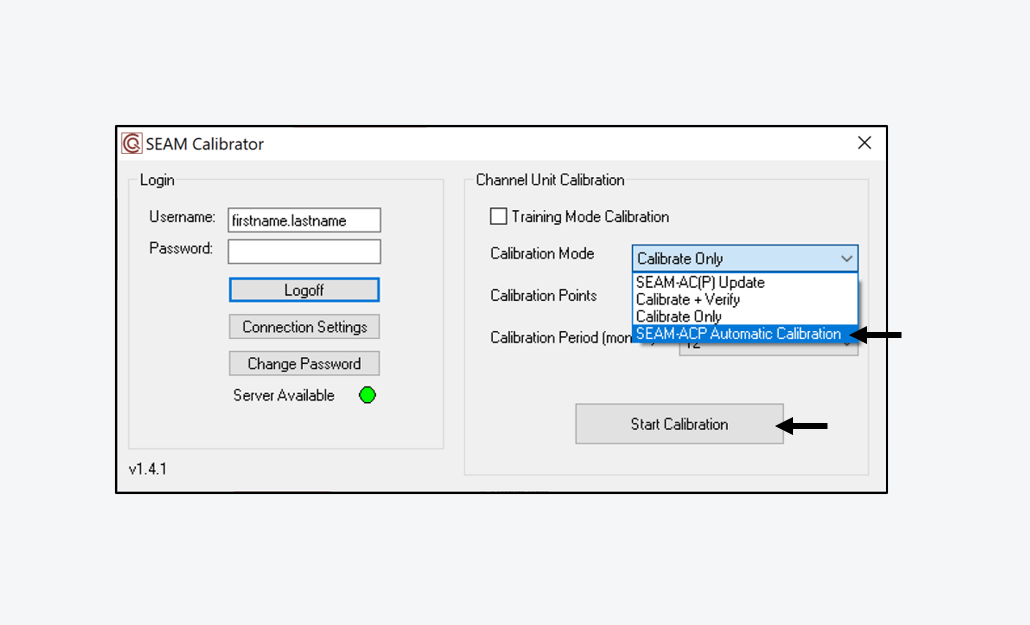 Step 7
Step 7Login to the Calibration Server. Set the "Calibration Mode" to "SEAM-ACP Automatic Calibration" and then click "Start Calibration".
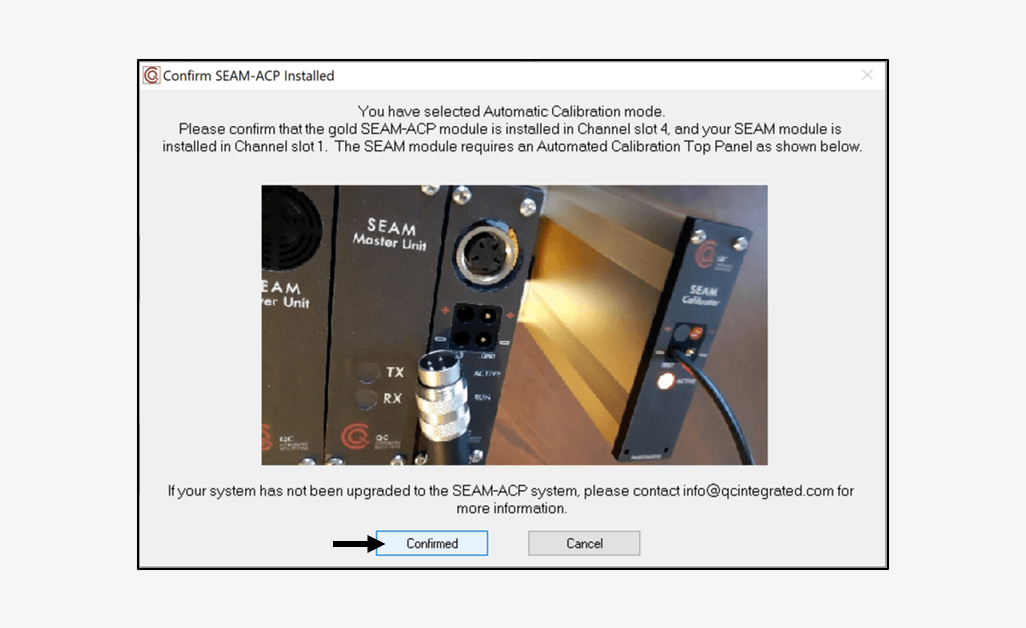 Step 8
Step 8Confirm that you are using the SEAM-ACP for calibration.
This process will not work for a SEAM-AC (red) calibrator.
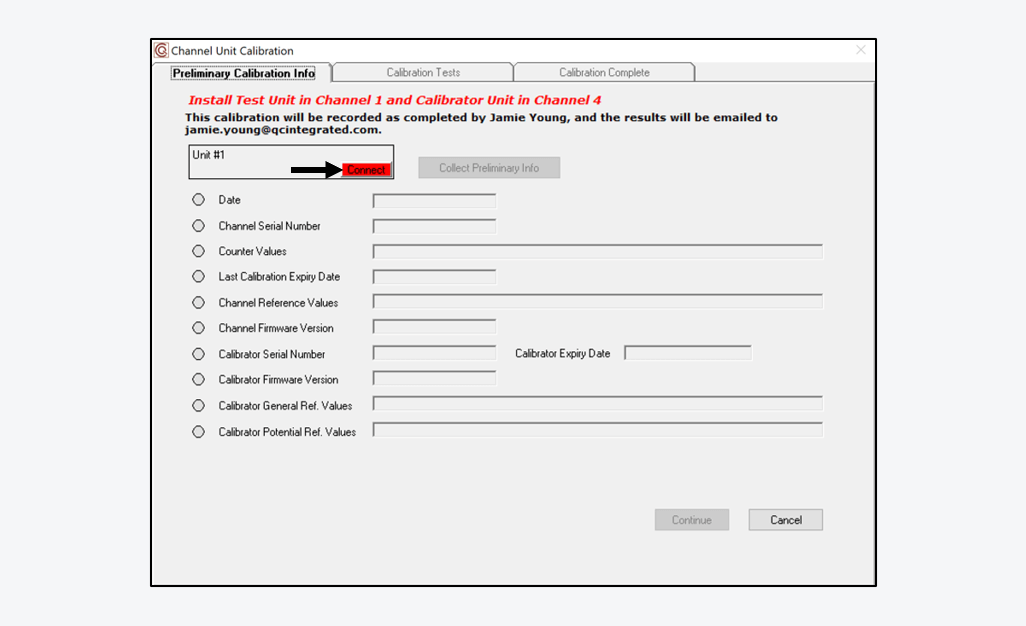 Step 9
Step 9Click "Connect" to initiate the connection with the tester.
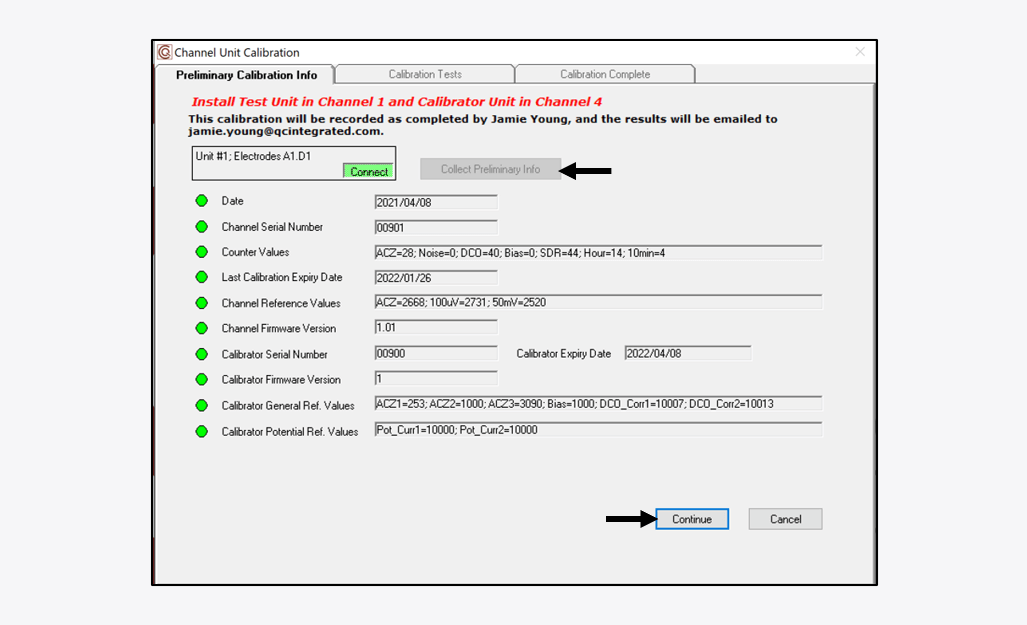 Step 10
Step 10Click "Collect Preliminary Info", wait for the data to load and then click "Continue".
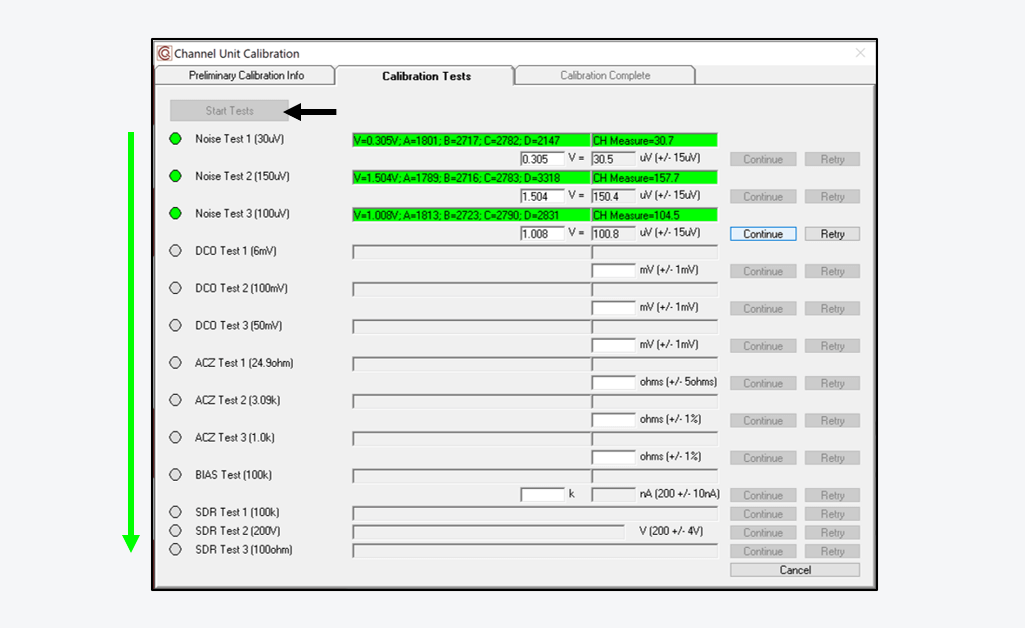 Step 11
Step 11Click "Start Test". All tests will execute automatically.
Cycle time is approximately 5 minutes.
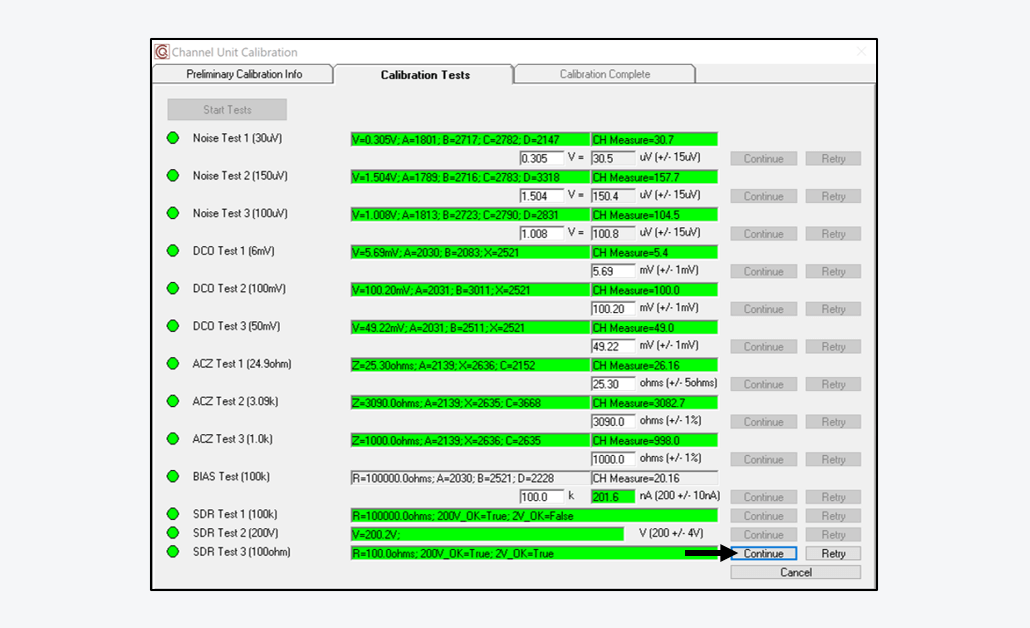 Step 12
Step 12Verify the results. Click "Continue" to apply the new calibration.
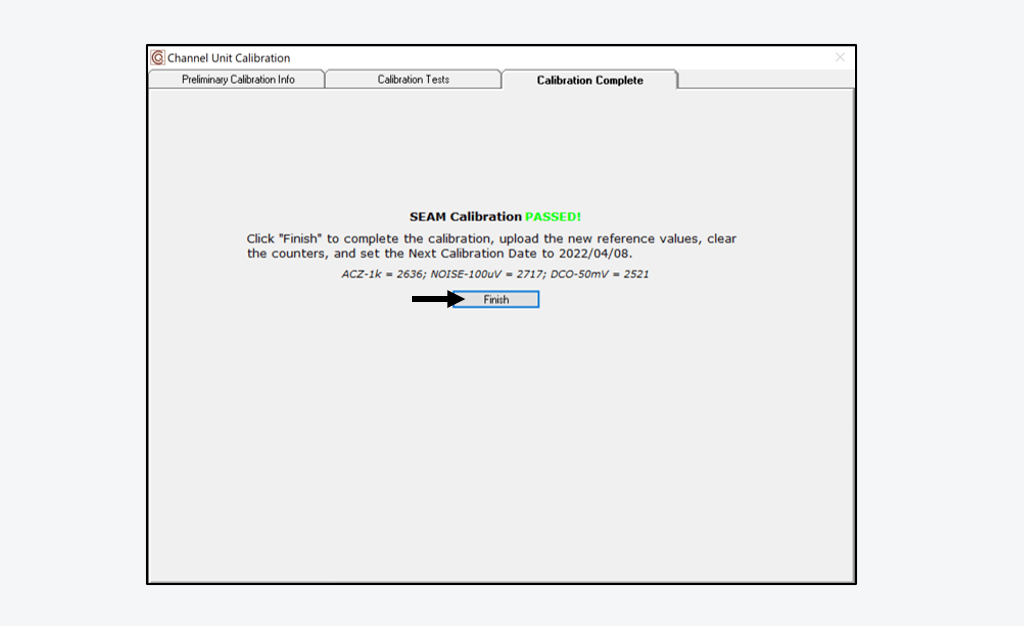 Step 13
Step 13Click "Finish" to complete the calibration. The calibration certificate will be sent to you in an email.
If you do not receive the calibration certificate with in 5 minutes of clicking "Finish", check your Junk Mail.
If you still cannot find the calibration certificate, please contact info@qcintegrated.com.
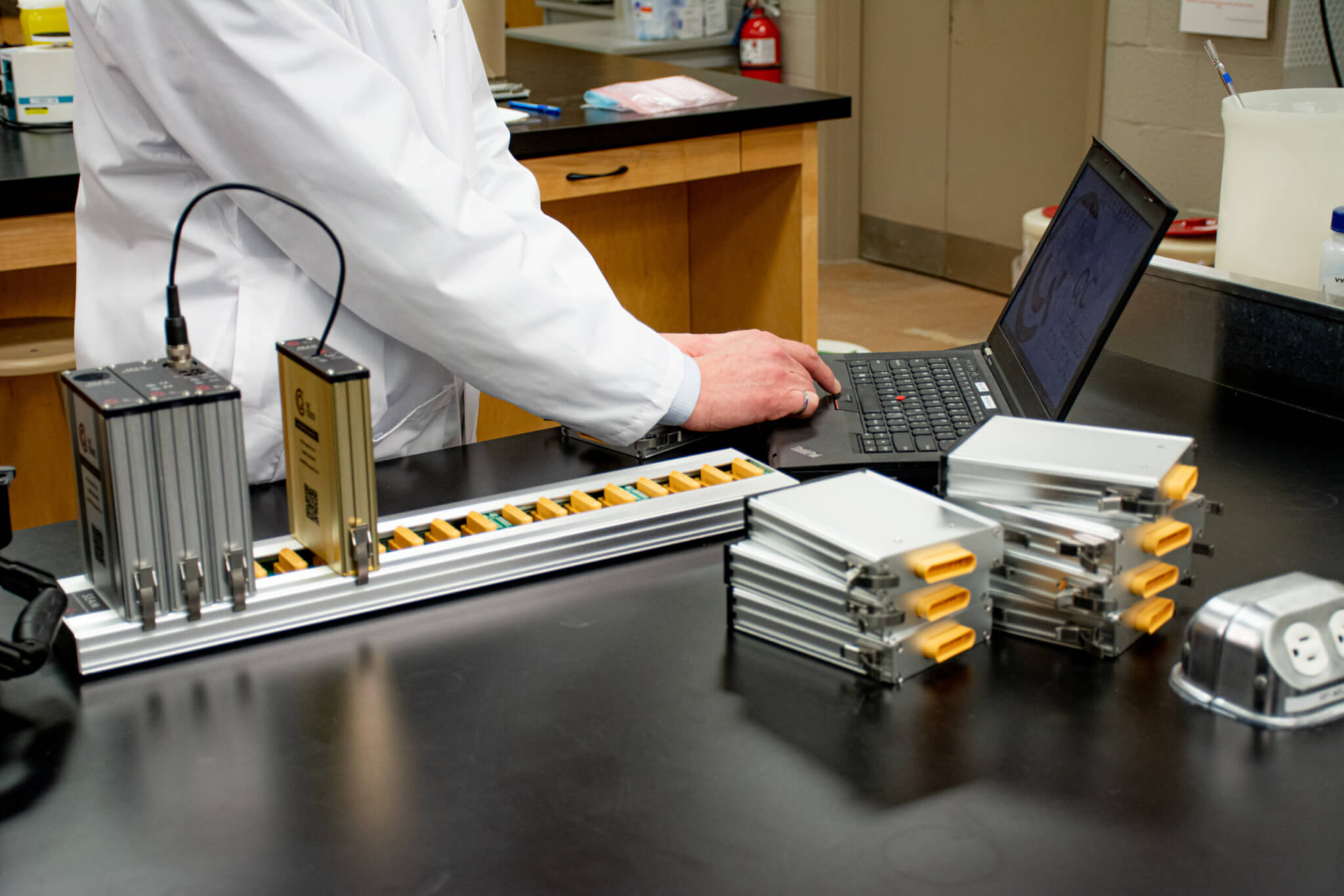 Step 14
Step 14Repeat this process with your remaining Channels.
Step 15End of Procedure
-
Calibration with the SEAM-AC (red)
Not available for purchase but still supported.Channel Calibration with the SEAM-AC (red)
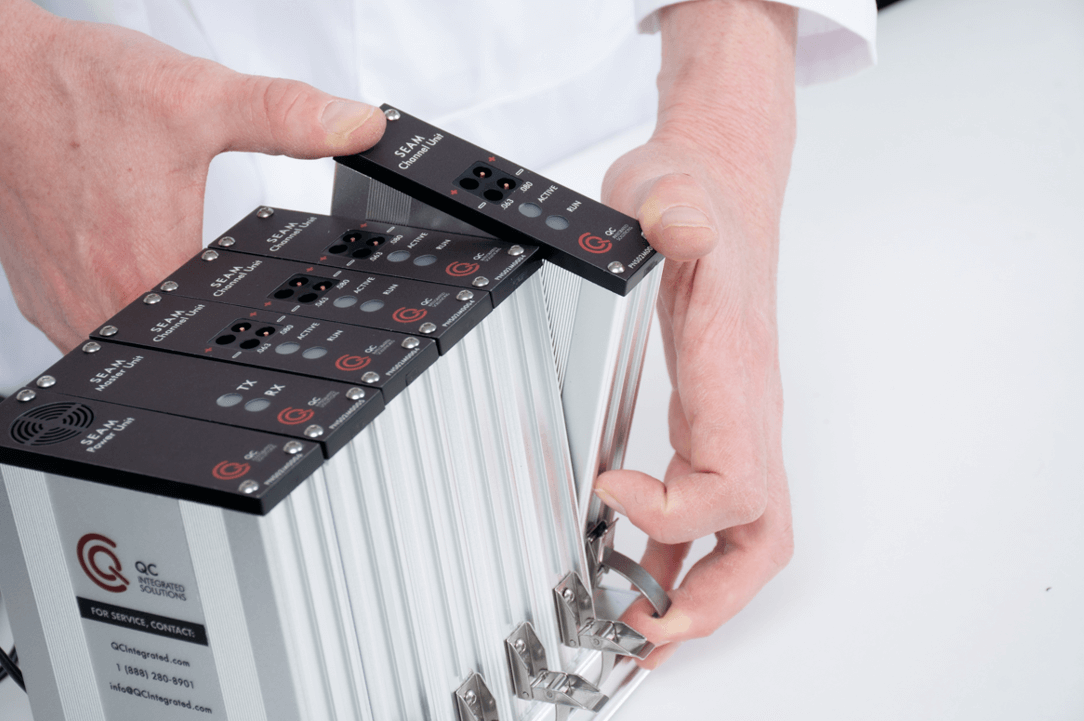 Step 1
Step 1Remove all Channels from the Bus.
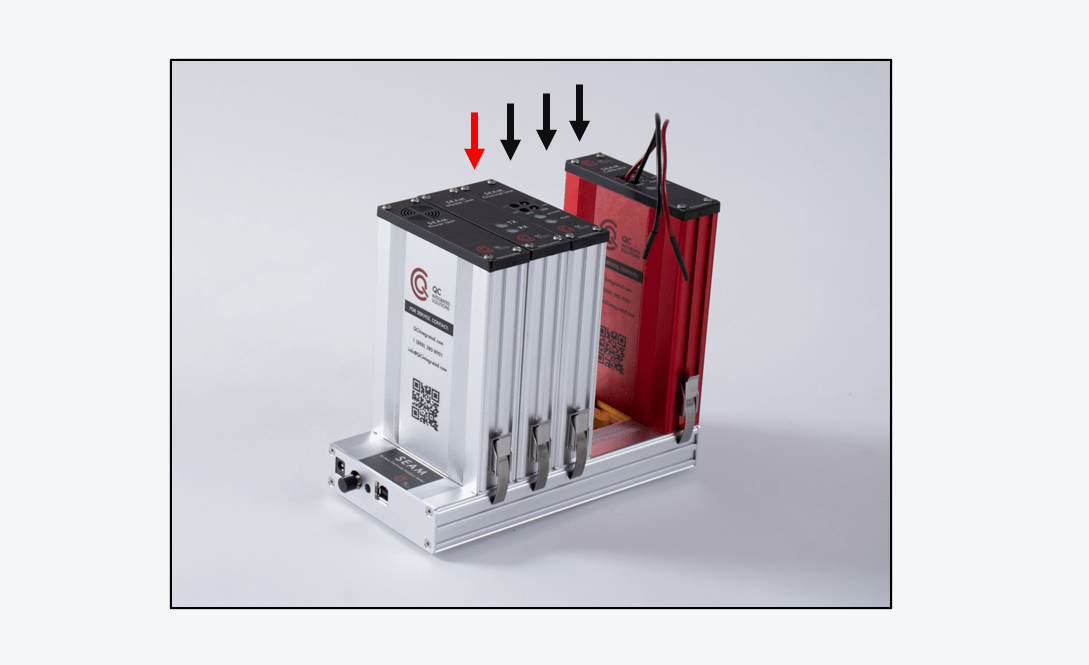 Step 2
Step 2Install the Channel you wish to calibrate into Slot 1.
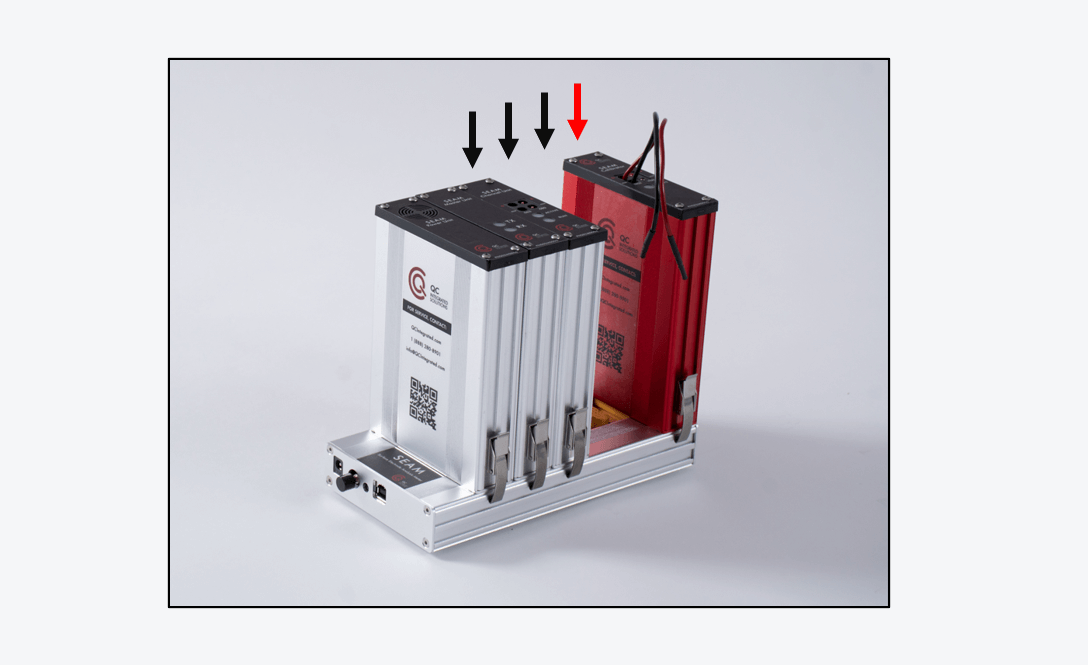 Step 3
Step 3Install the SEAM-AC into Slot 4.
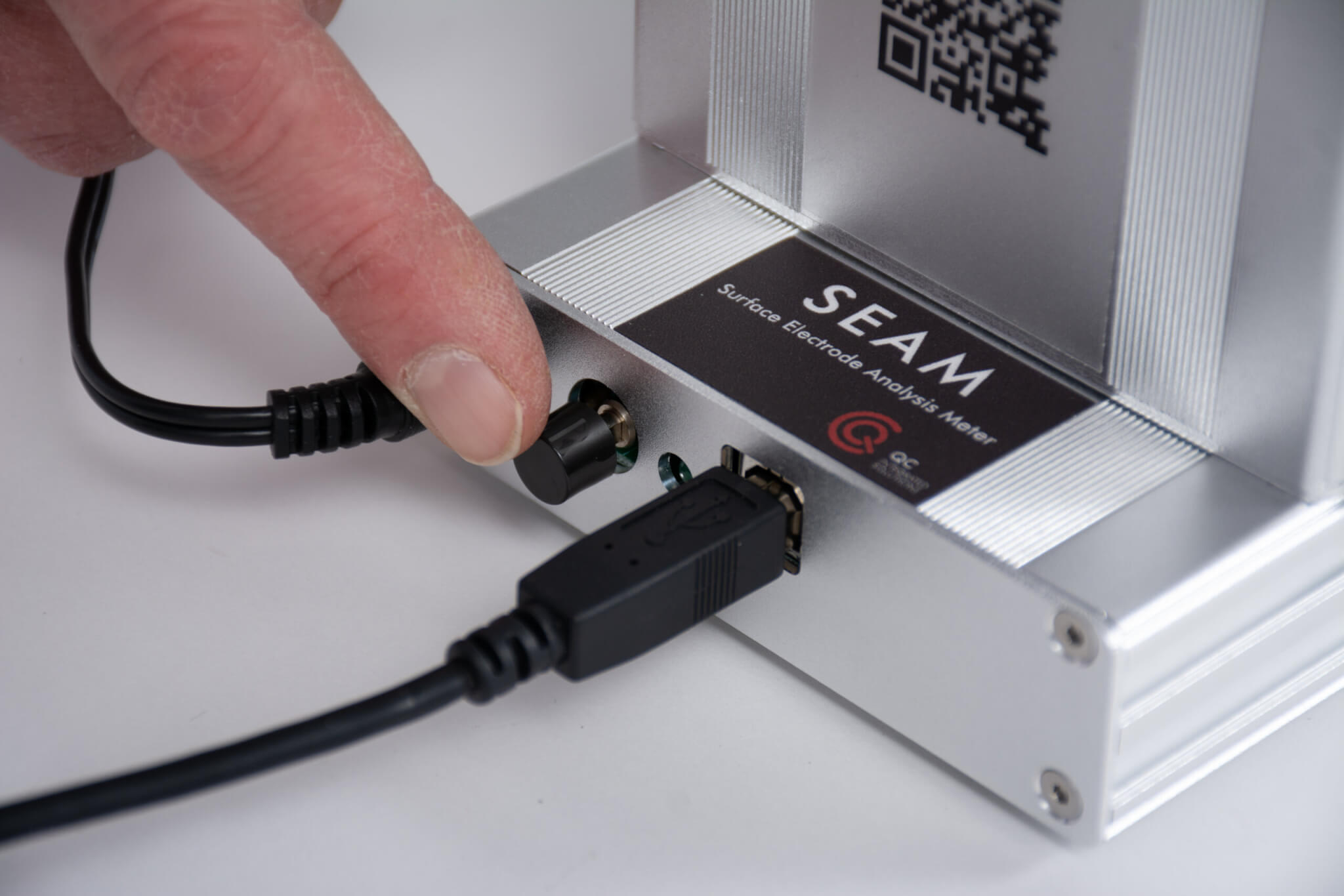 Step 4
Step 4Power up the SEAM tester.
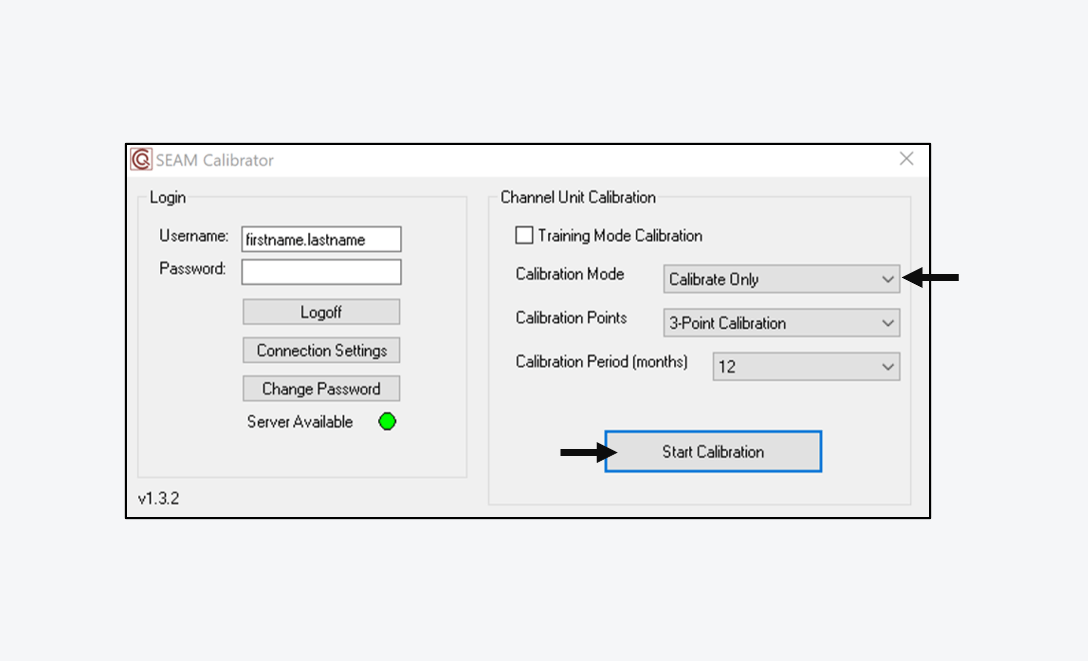 Step 5
Step 5Login to the Calibration Server, select "Calibrate Only" and click "Start Calibration".
Alternatively, you can also select "Calibrate + Verify" as a Calibration Mode. The user will be prompted to verify each measurement with an external multimeter when this option is chosen.
You can also specify the number of calibration points and calibration period at this time.
 Step 6
Step 6Click "Connect" to initiate the connection with the tester.
 Step 7
Step 7Click "Collect Preliminary Info", wait for the data to load and then click "Continue".
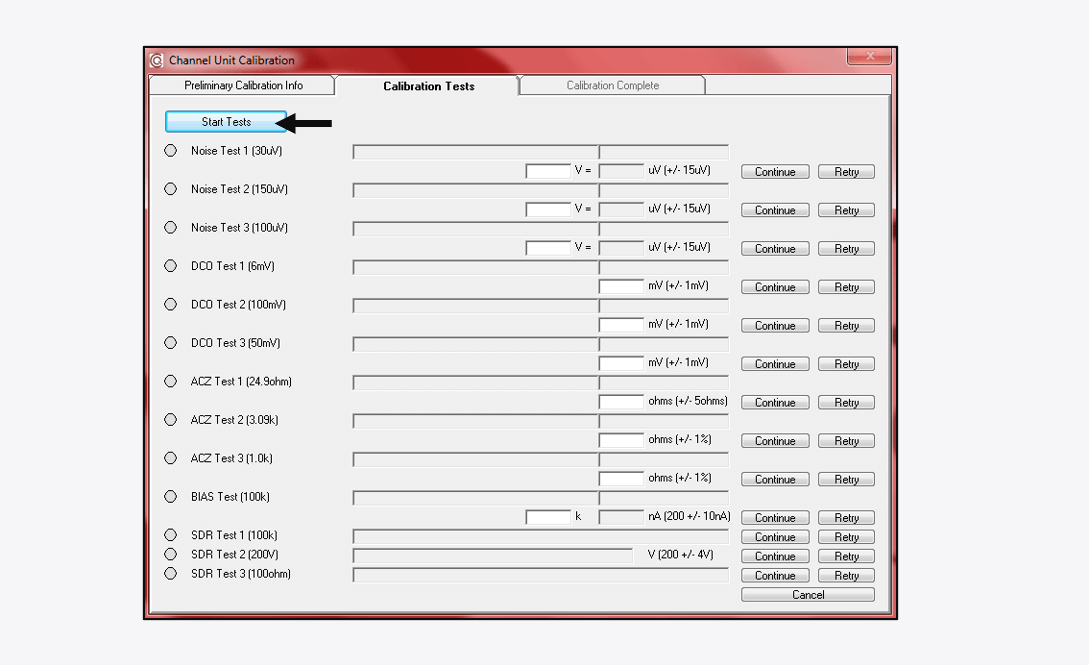 Step 8
Step 8Click "Start Tests".
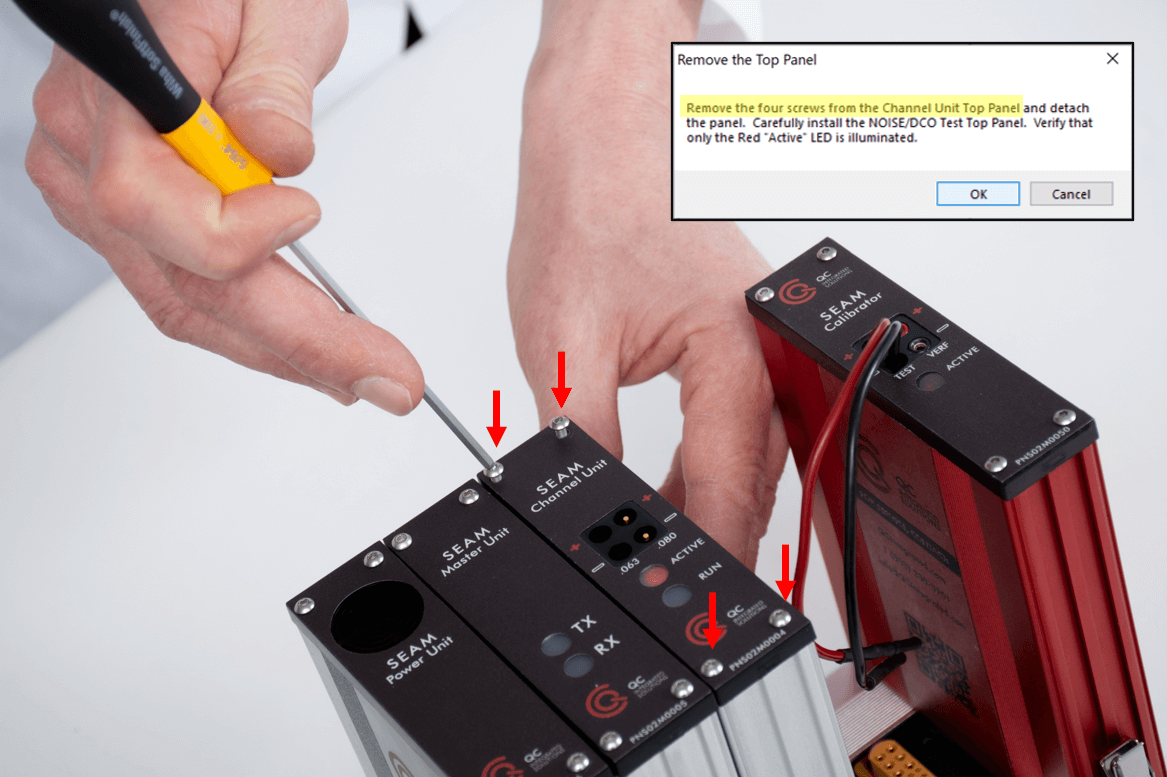 Step 9
Step 9Remove the fasteners holding down the Channel Top.
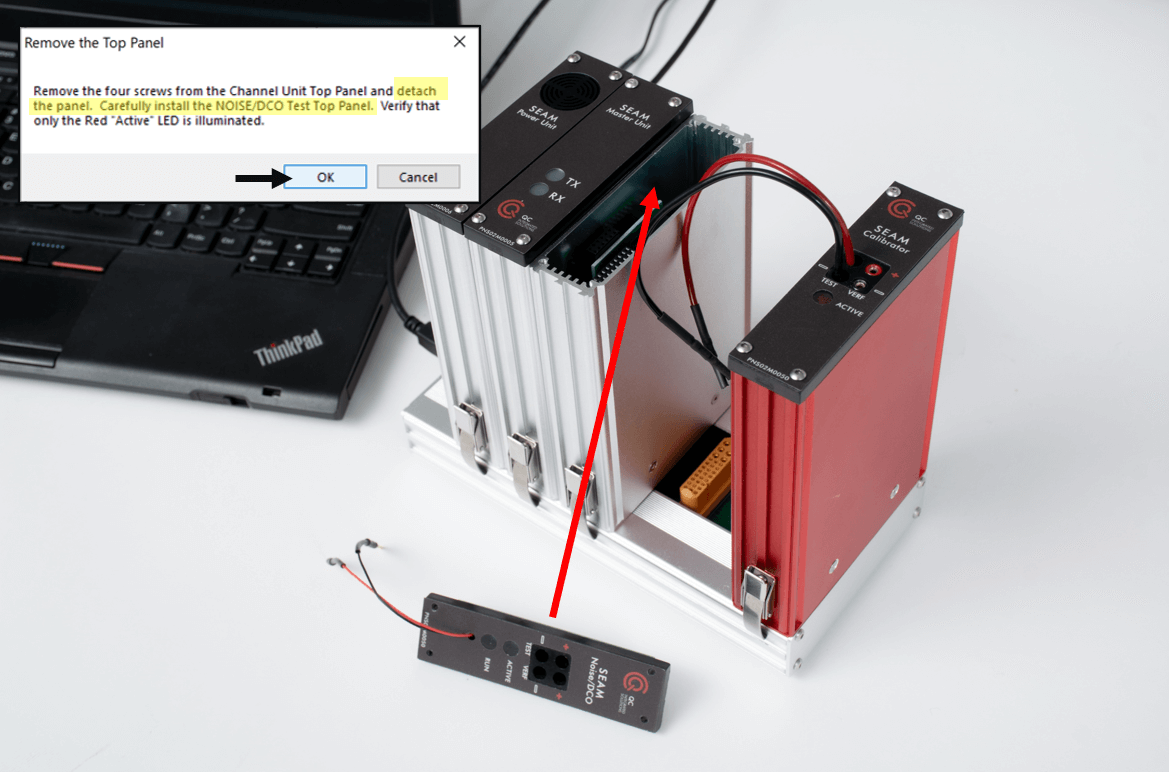 Step 10
Step 10Install the Noise/DCO Channel Top and click "OK".
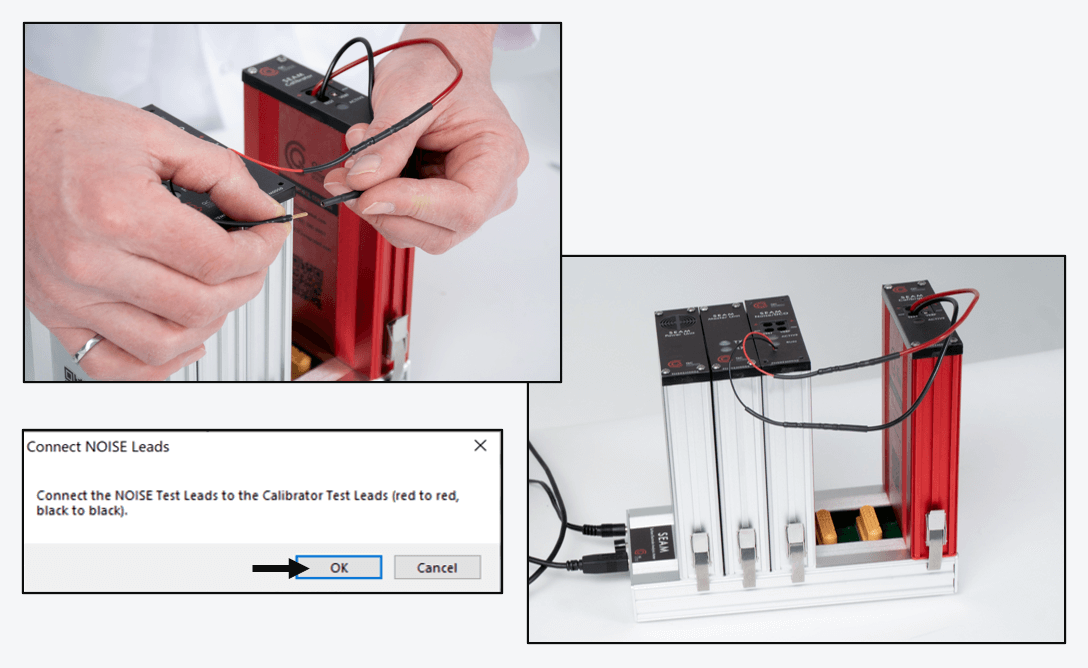 Step 11
Step 11Connect the SEAM-AC to the Noise Test Leads and click "OK".
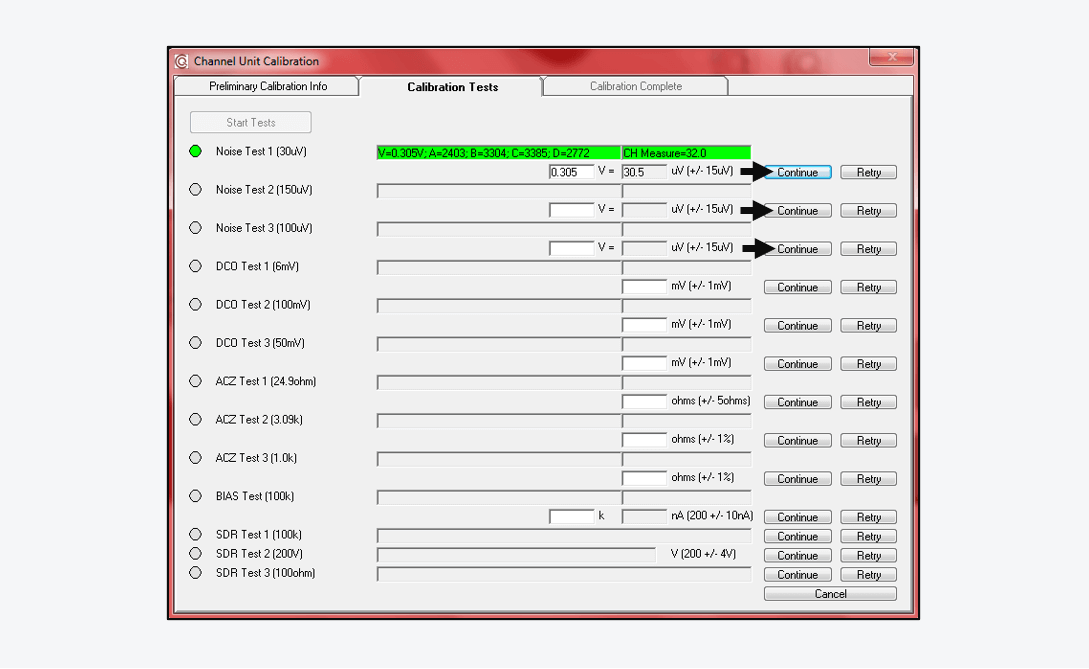 Step 12
Step 12Wait for the first Noise test to complete and then click "Continue". Repeat this process two more times.
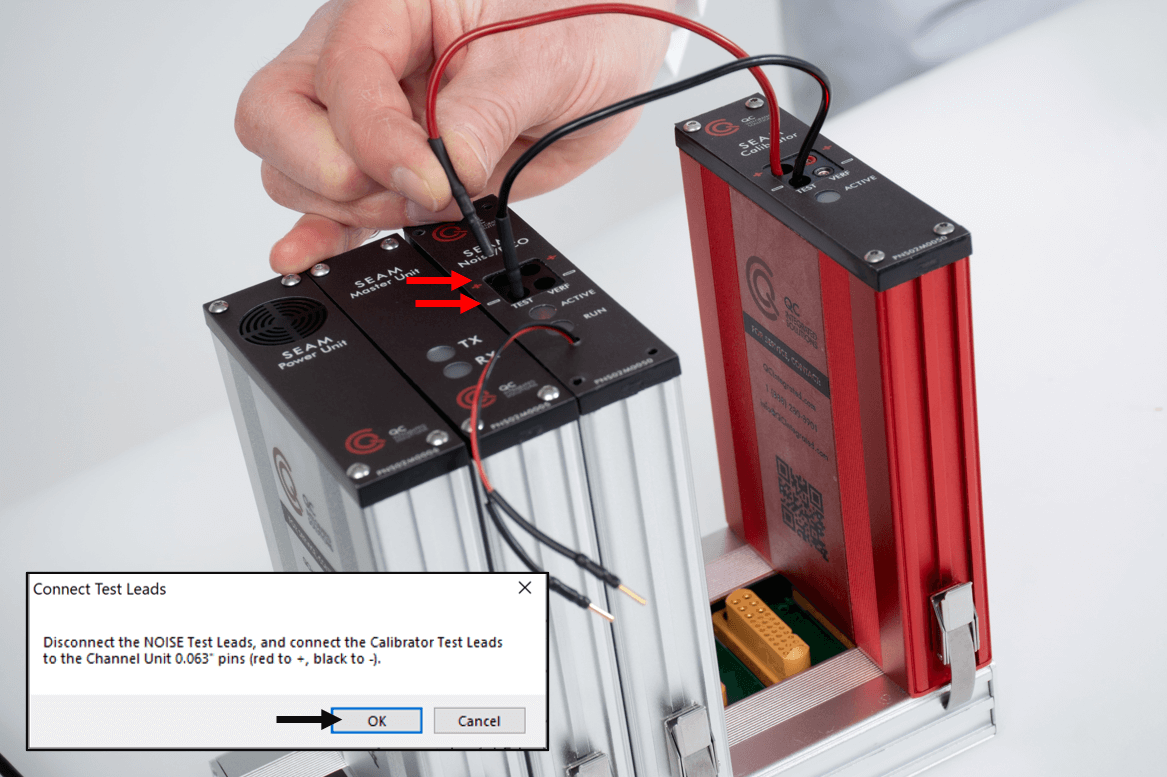 Step 13
Step 13Connect the SEAM-AC to the TEST pins on the Noise/DCO Channel Top. Click "OK".
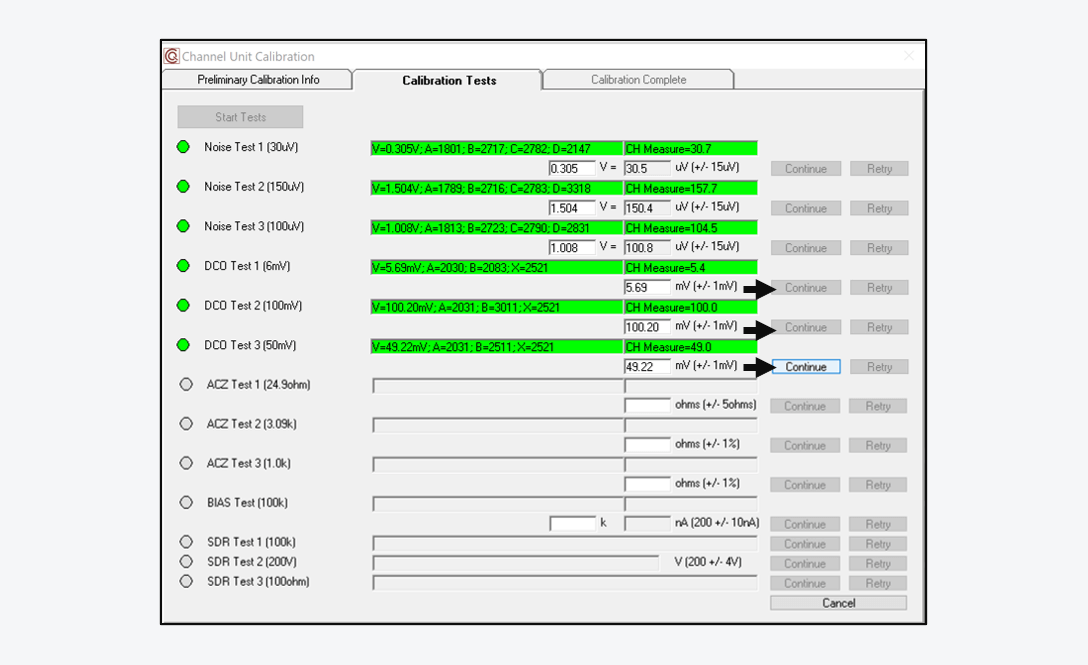 Step 14
Step 14Wait for the test to be completed and then click "Continue". Repeat this process two more times.
 Step 15
Step 15Reinstall the original Channel Top and click "OK".
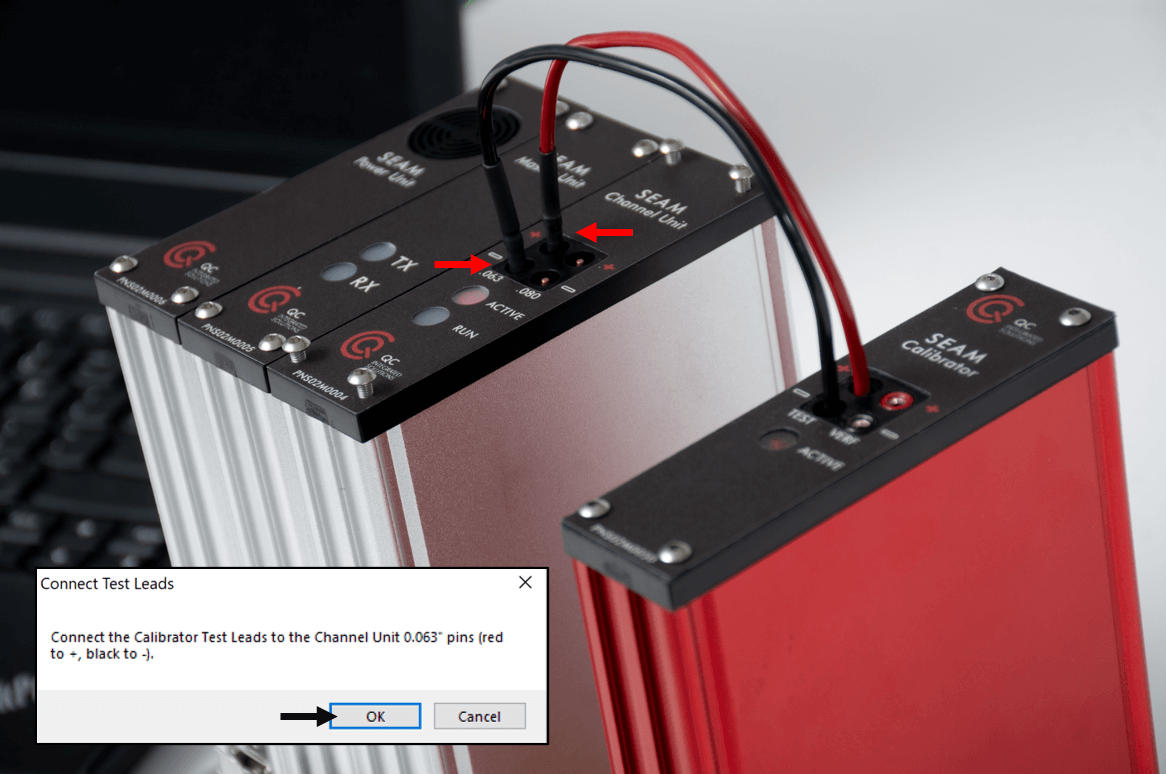 Step 16
Step 16Connect the SEAM-AC to the 0.063" pins on the Channel and click "OK".
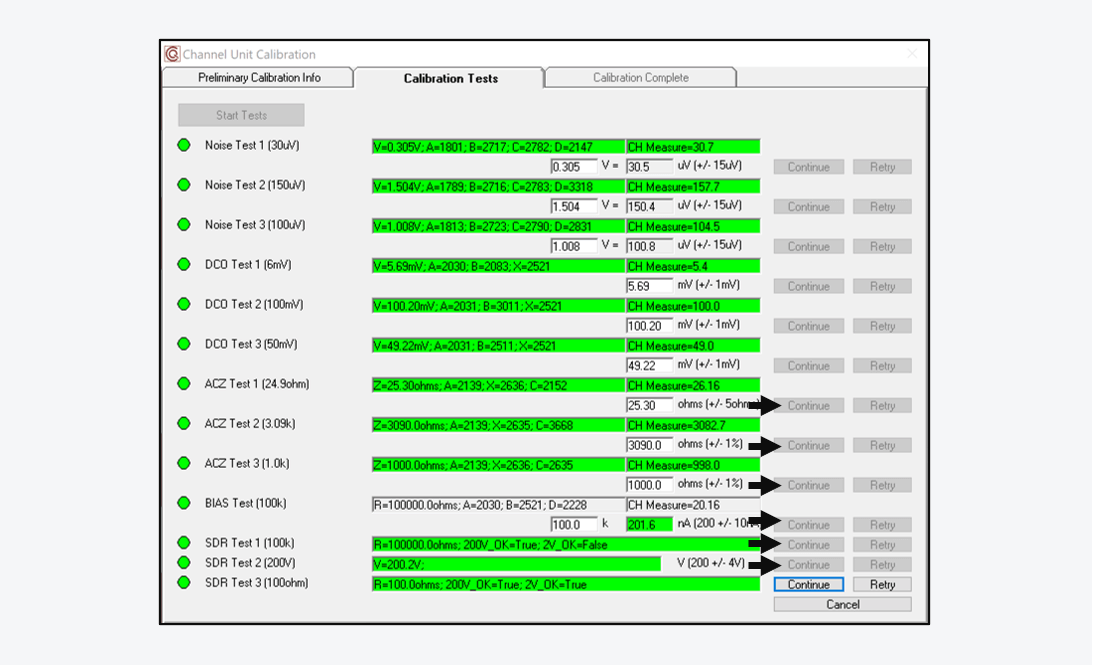 Step 17
Step 17Wait for the test to be completed and then click "Continue". Repeat this process six more times.
 Step 18
Step 18Verify the results. Click "Continue" to apply the new calibration.
 Step 19
Step 19Click "Finish" to complete the calibration. The calibration certificate will be sent to you in an email.
If you do not receive the calibration certificate with in 5 minutes of clicking "Finish", check your Junk Mail.
If you still cannot find the calibration certificate, please contact info@qcintegrated.com.
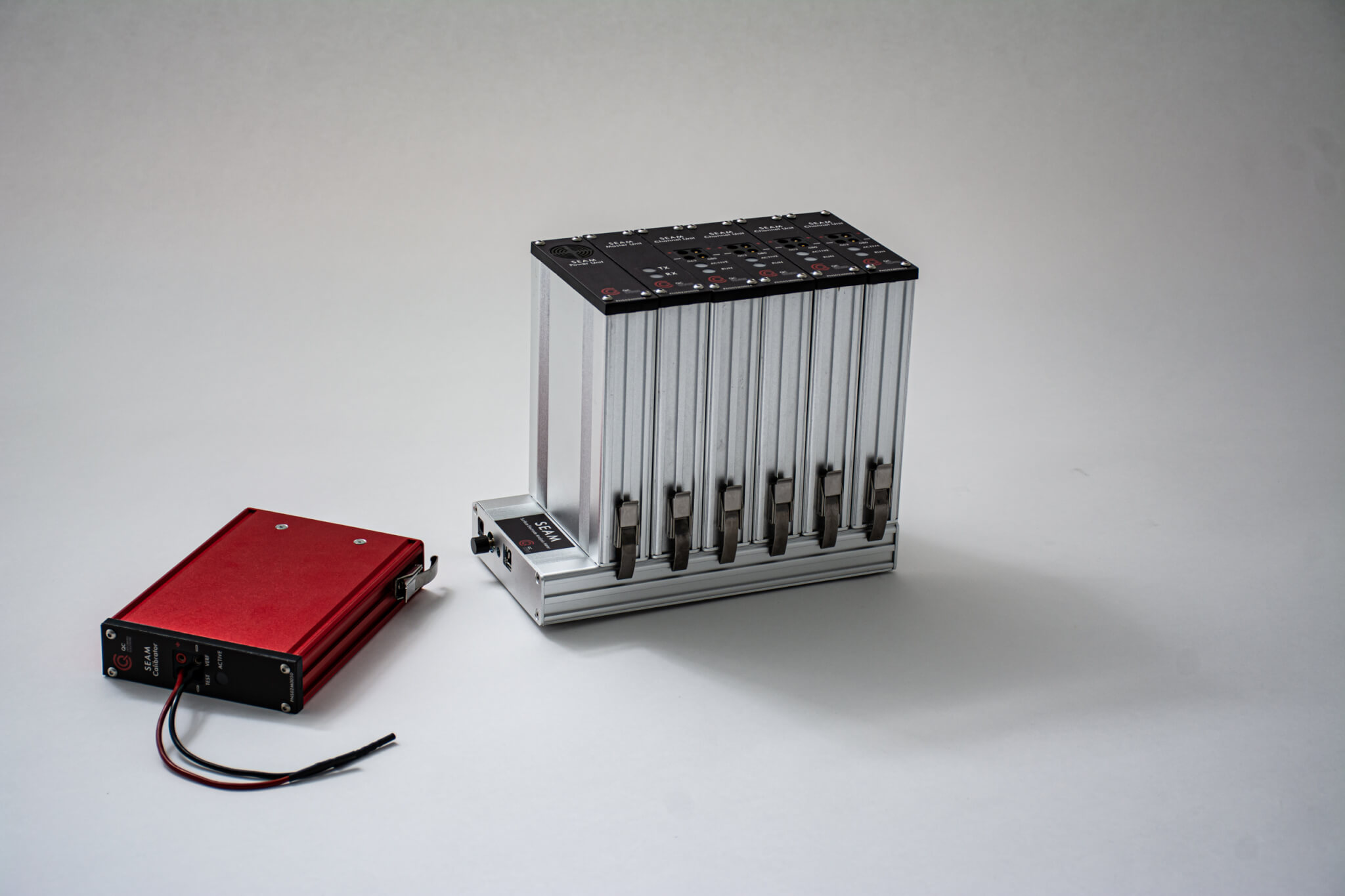 Step 20
Step 20Repeat this process with your remaining Channels.
Step 21End of Procedure
-
Updating the SEAM-AC(P)
Updating the SEAM-AC(P)
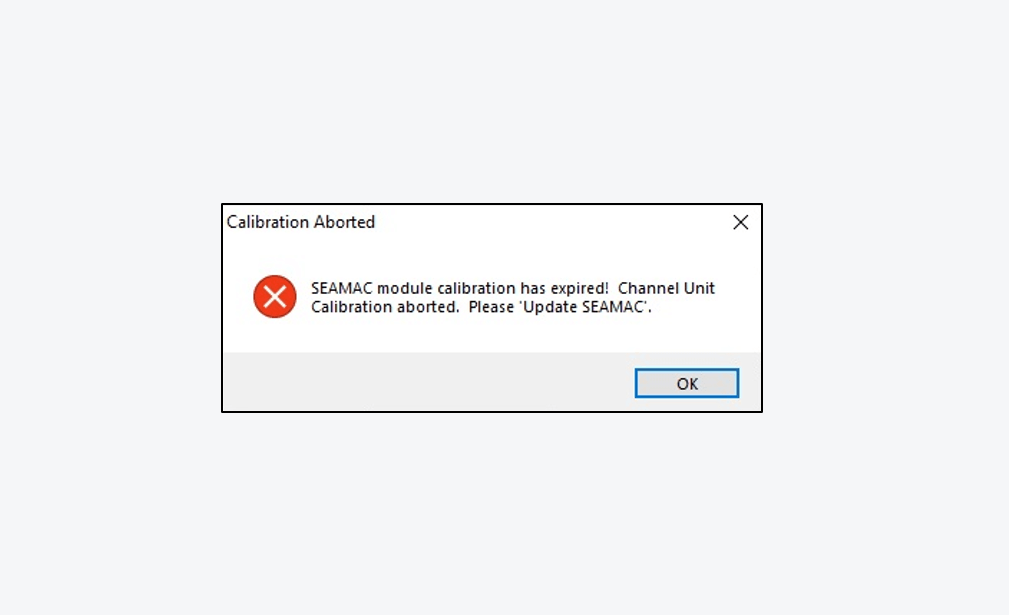 Step 1
Step 1When performing a channel calibration, you may encounter this error message indicating that the SEAM-AC(P) must be updated.
It is necessary to verify that the SEAM-AC(P) is within tolerance on an annual basis.
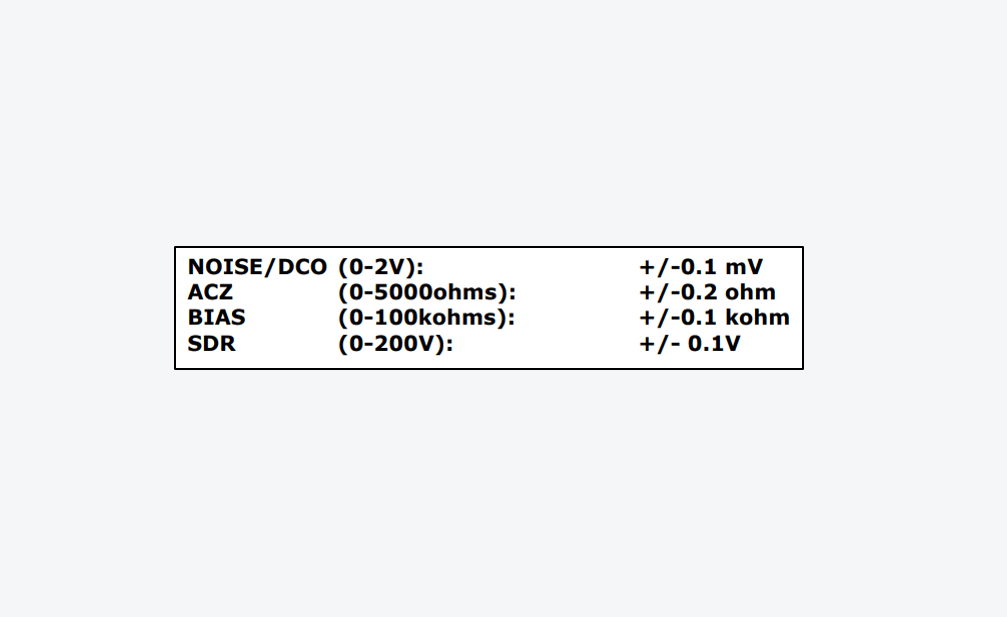 Step 2
Step 2Obtain a NIST traceable multimeter which meets the following specifications.
If you do not have access to a multimeter with these specifications, contact info@qcintegrated.com for assistance.
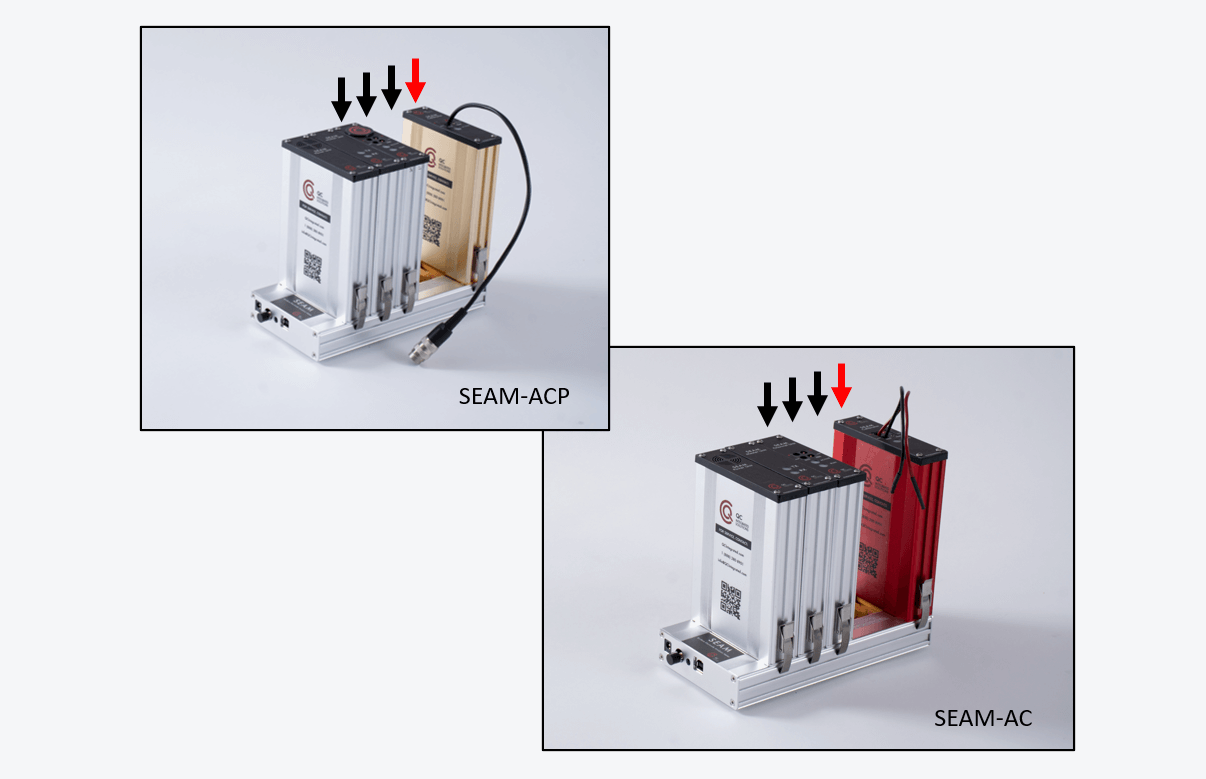 Step 3
Step 3Install the SEAM-AC(P) into Slot 4 of the Bus.
Slot 1 does not have to be populated for a SEAM-AC(P) update.
 Step 4
Step 4Power up the SEAM tester.
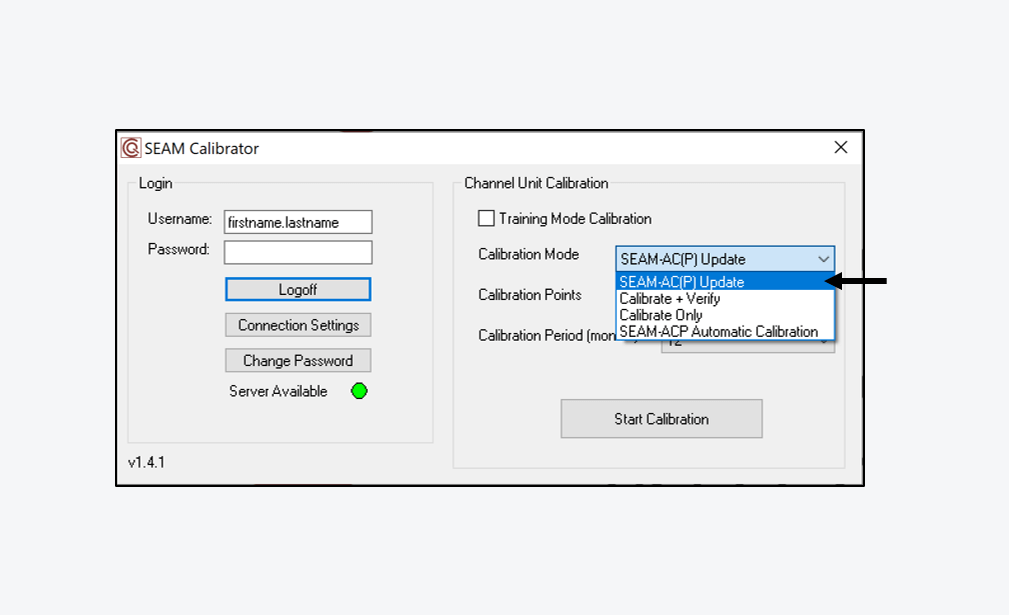 Step 5
Step 5Open the Calibrator application and login. Select "SEAM-AC(P) Update" from the "Calibration Mode" menu.
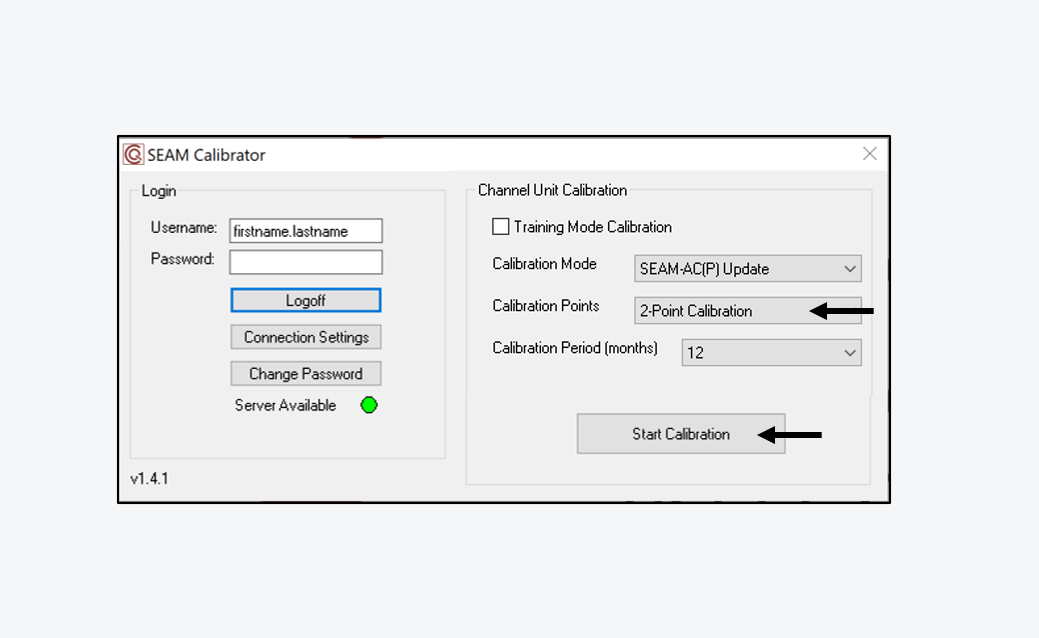 Step 6
Step 6Specify the number of calibration points and then select "Start Calibration".
 Step 7
Step 7Click "Connect" to initiate communication with the SEAM-AC(P).
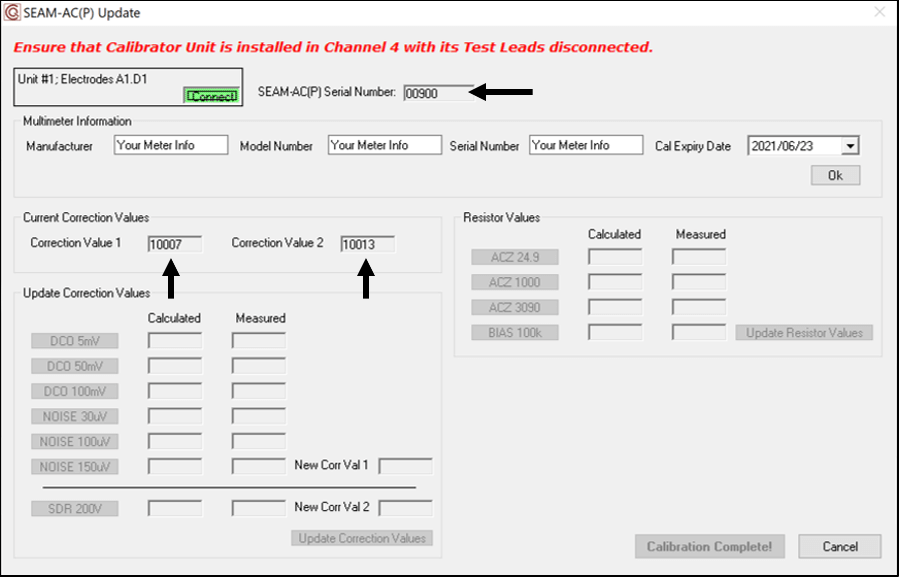 Step 8
Step 8When the connection is successful, the SEAM-AC(P) serial number and correction values are loaded.
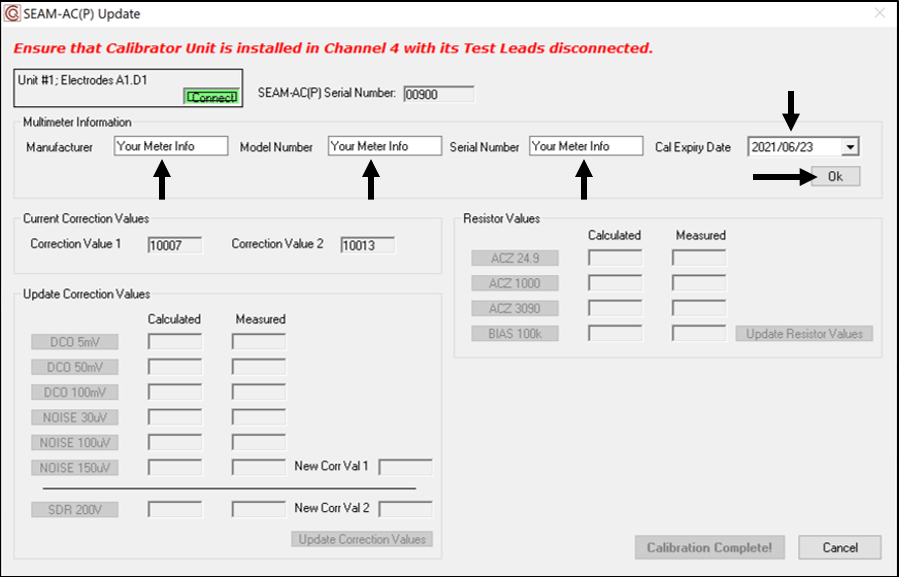 Step 9
Step 9Input the information for your NIST traceable multimeter and click "OK".
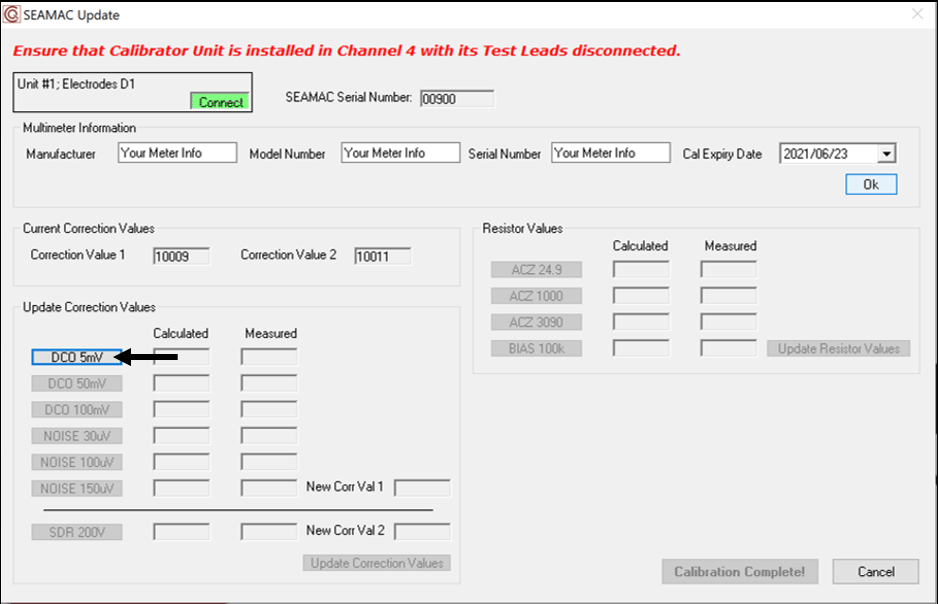 Step 10
Step 10Select the "DCO 5mV" button.
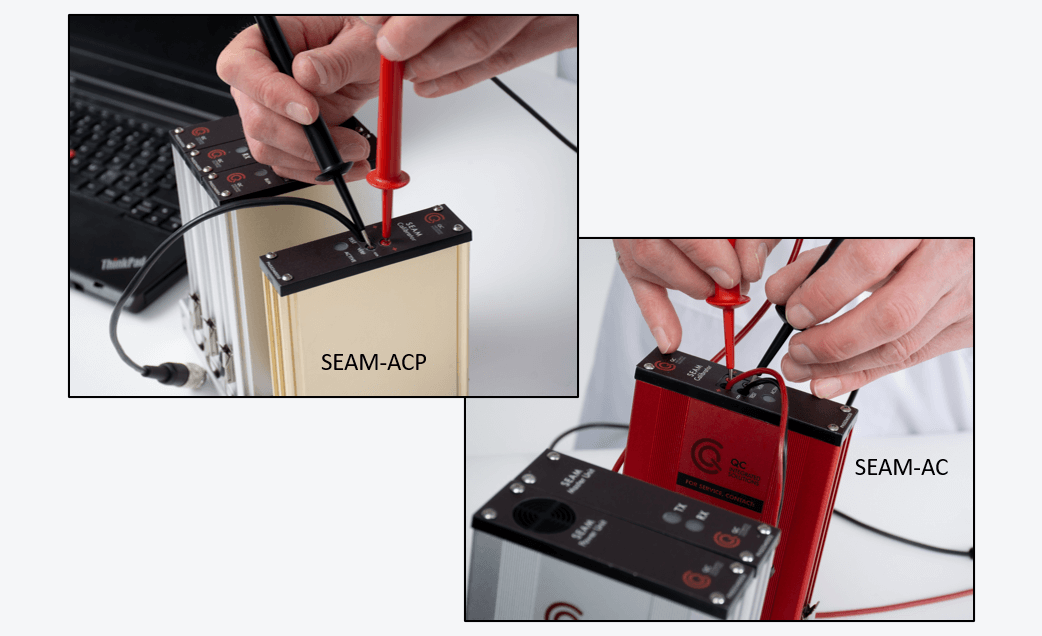 Step 11
Step 11Set the multimeter to measure DC voltage and probe the VERF sockets.
 Step 12
Step 12Record the measurement from the multimeter and click "Save".
5.832 mV has been used as an example here.
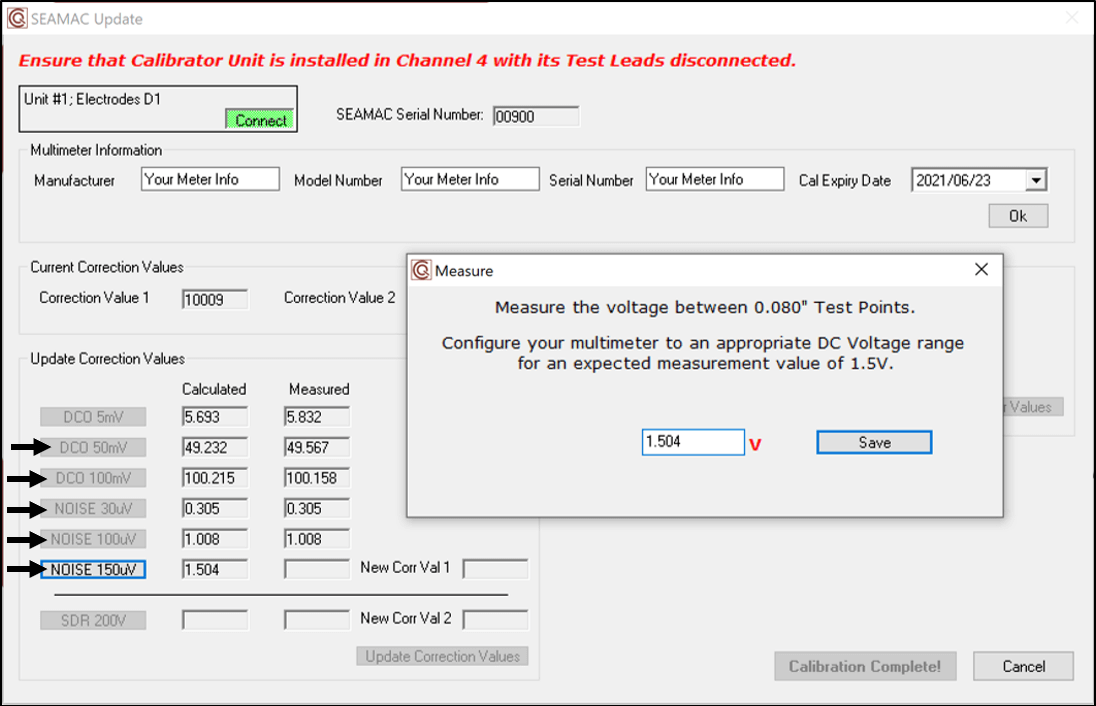 Step 13
Step 13Repeat Steps 10 to 12 for the remaining DCO and NOISE measurements.
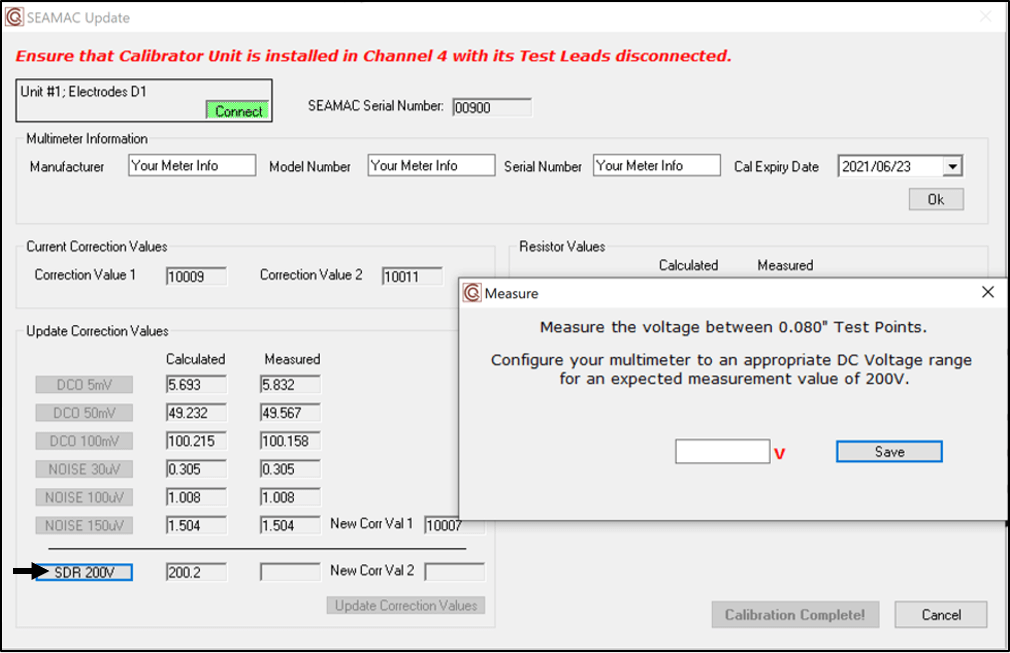 Step 14
Step 14Press the "SDR 200V" button.
 Step 15
Step 15Probe the VERF sockets.
This measurement must be made within 10 seconds of pressing "SDR 200V".
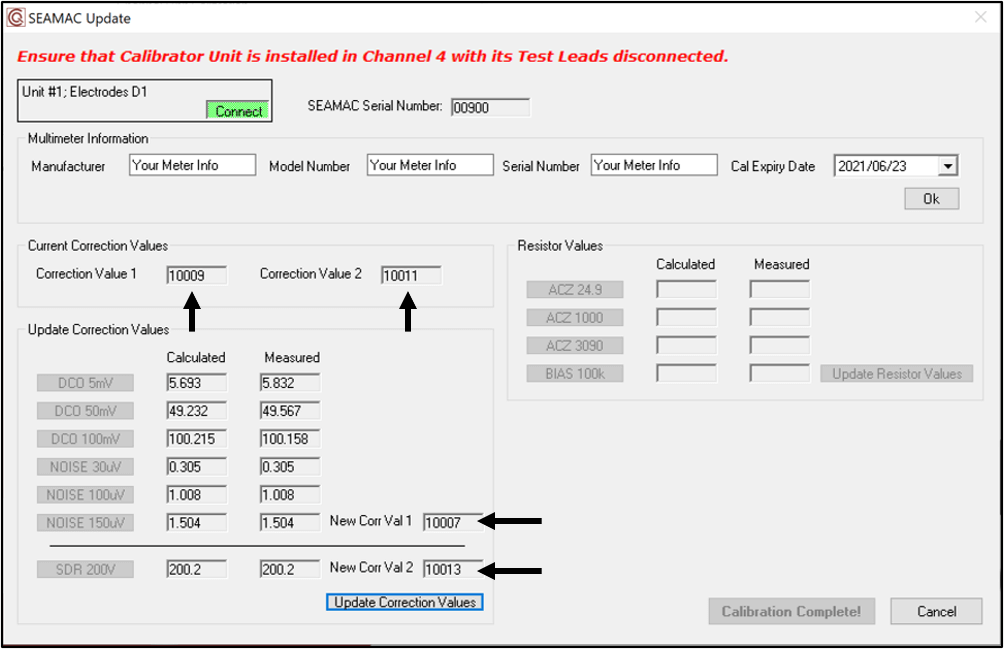 Step 16
Step 16Verify that your New Correction Values are within 10% of the Old Correction Values.
If a this is not the case, check that there have been no errors in typing in the measured values.
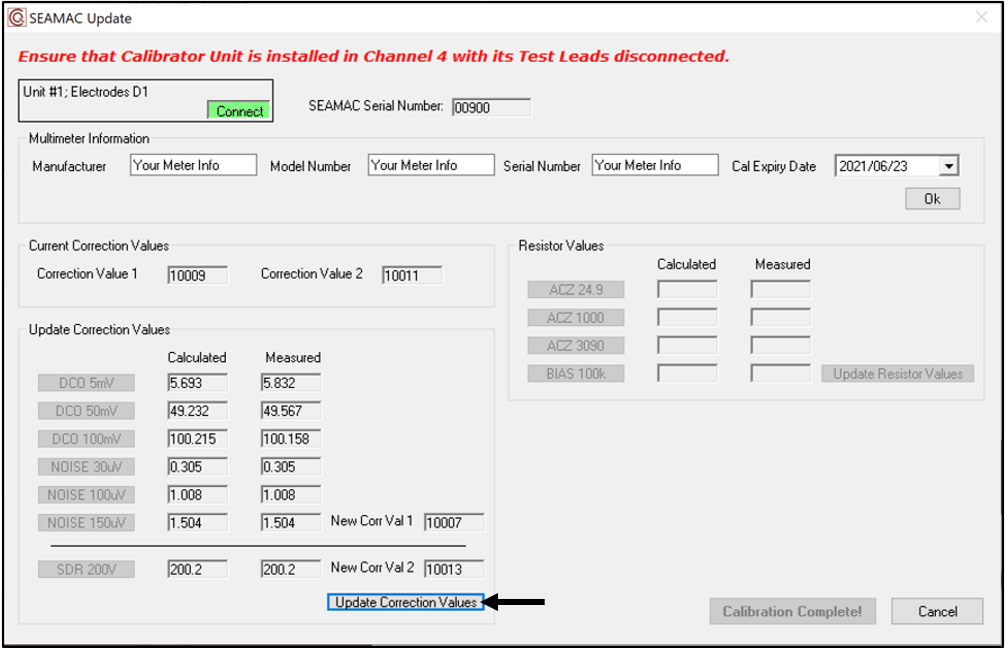 Step 17
Step 17Click "Update Correction Values".
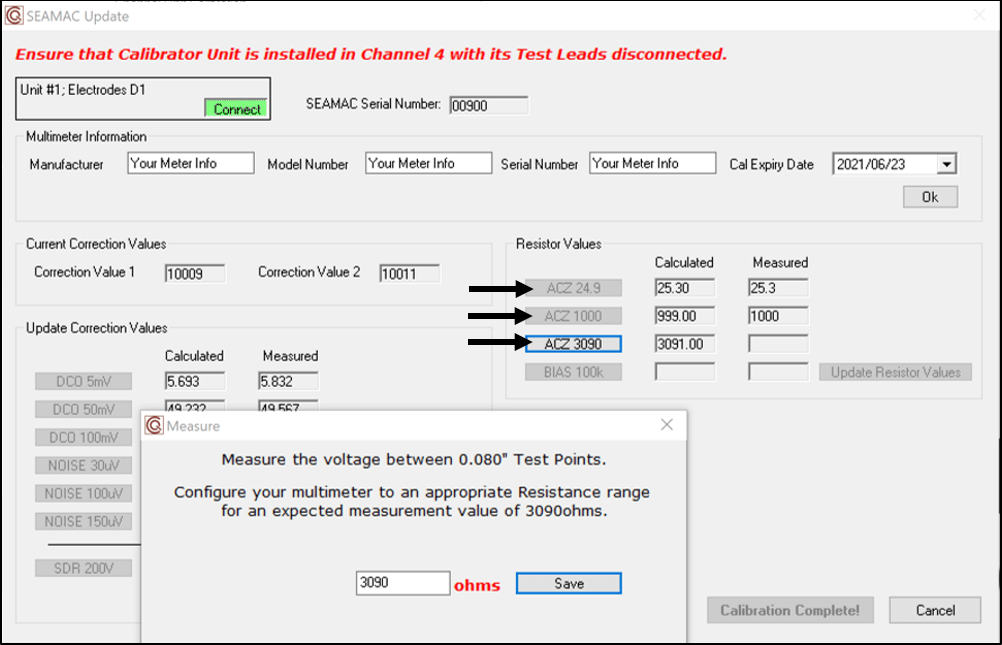 Step 18
Step 18Set your multimeter to measure resistance. Complete the ACZ measurements using Steps 10 to 12.
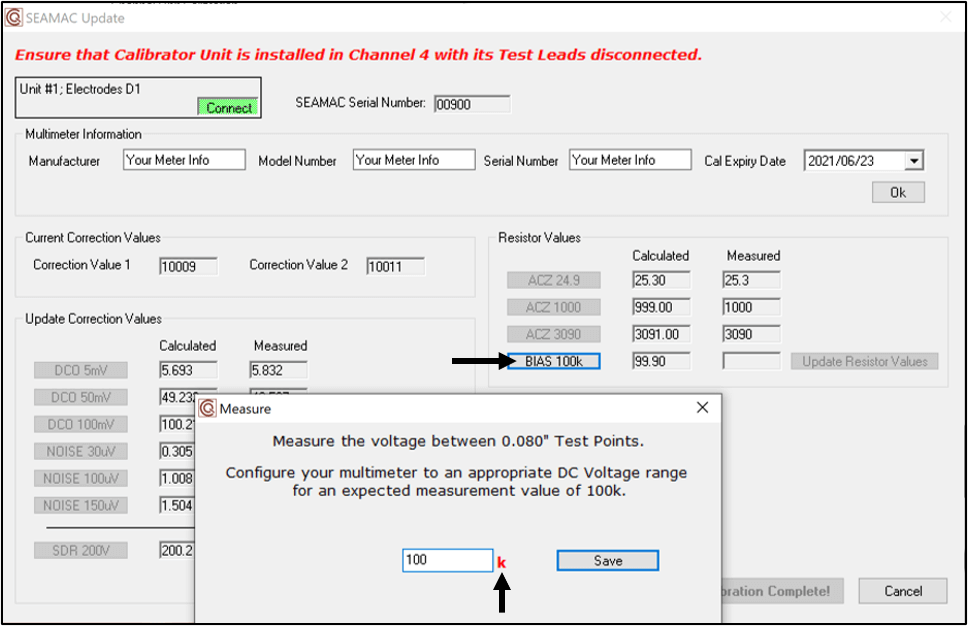 Step 19
Step 19Complete the BIAS measurement using Steps 10 to 12.
Note: The measurement must be inputted as kilo-ohms.
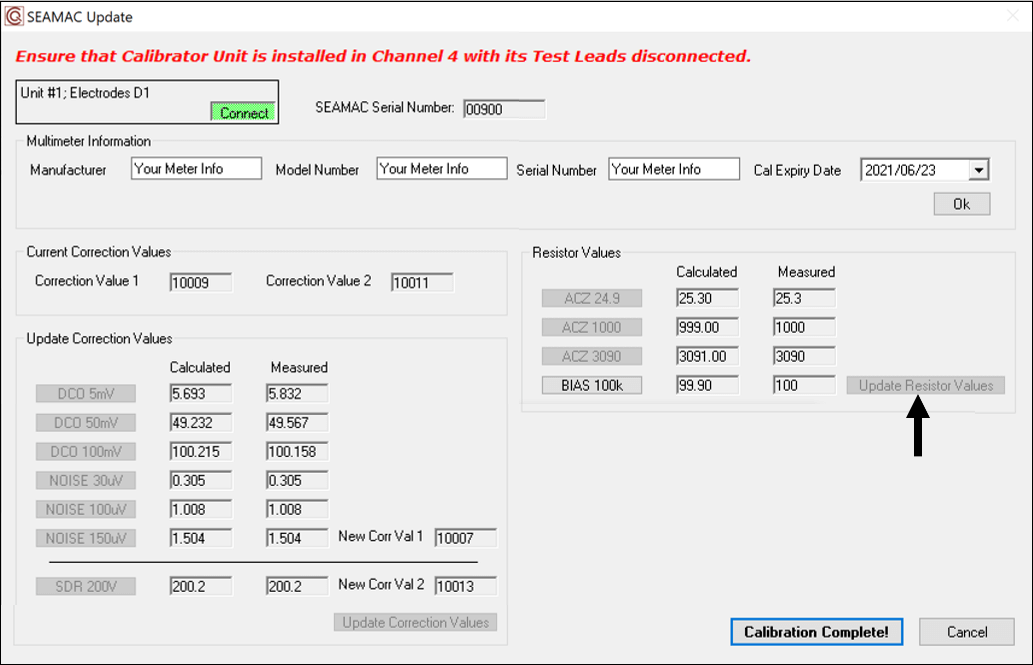 Step 20
Step 20Verify the results. Click "Updated Resistor Values" to apply the updates.
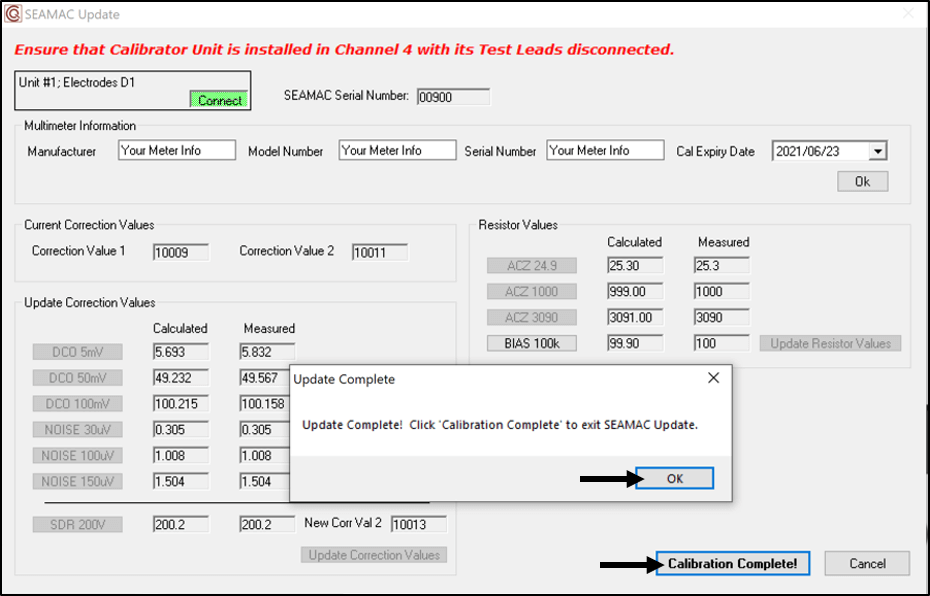 Step 21
Step 21Click "OK" and then "Calibration Complete!". A SEAM-AC(P) update report is then emailed to the operator
If you do not receive the report with in 5 minutes of clicking "Finish", check your Junk Mail.
If you still cannot find the report, please contact info@qcintegrated.com.
Step 22End of Procedure
SEAM TENS Electrode Tester
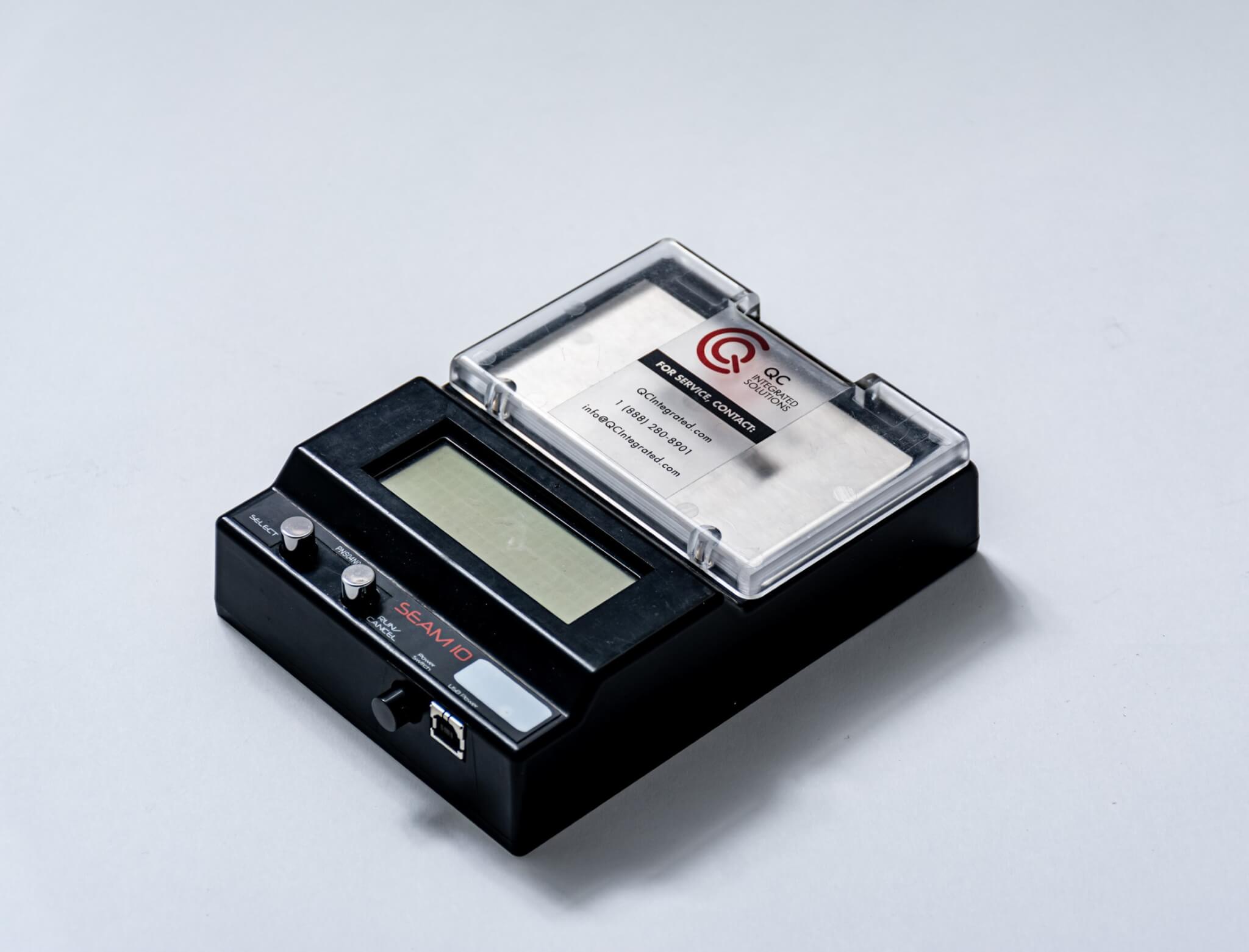
Resources
- SEAM TENS Application - v1.1
-
Software Installation
Software Installation for the SEAM TENS Electrode Tester
 Step 1
Step 1Obtain a Windows PC with administrator rights.
 Step 2
Step 2Install USB drive included with SEAM hardware.
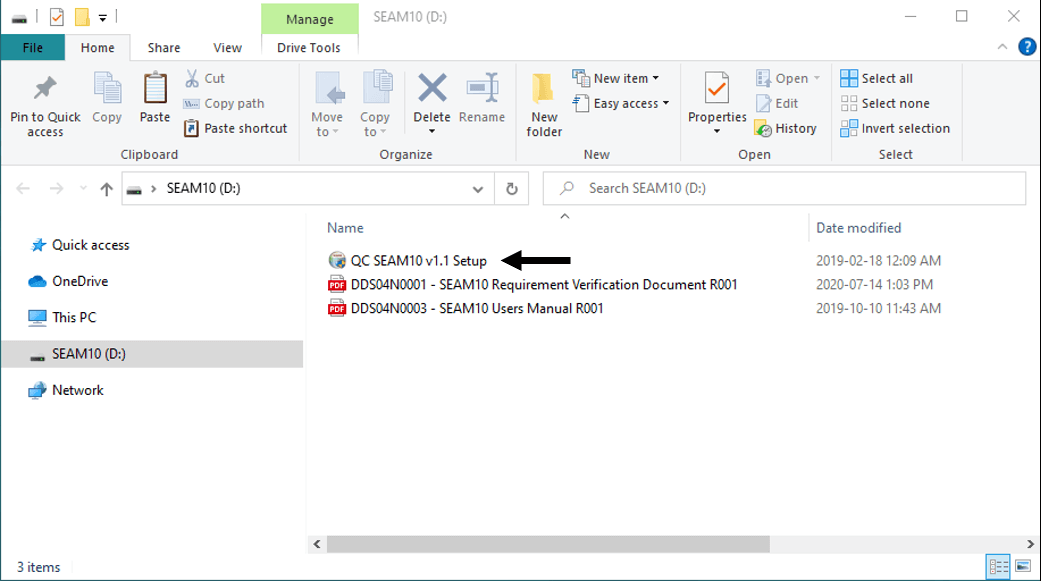 Step 3
Step 3Navigate to "QC SEAM10 v* Setup" on the USB drive and double-click on it.
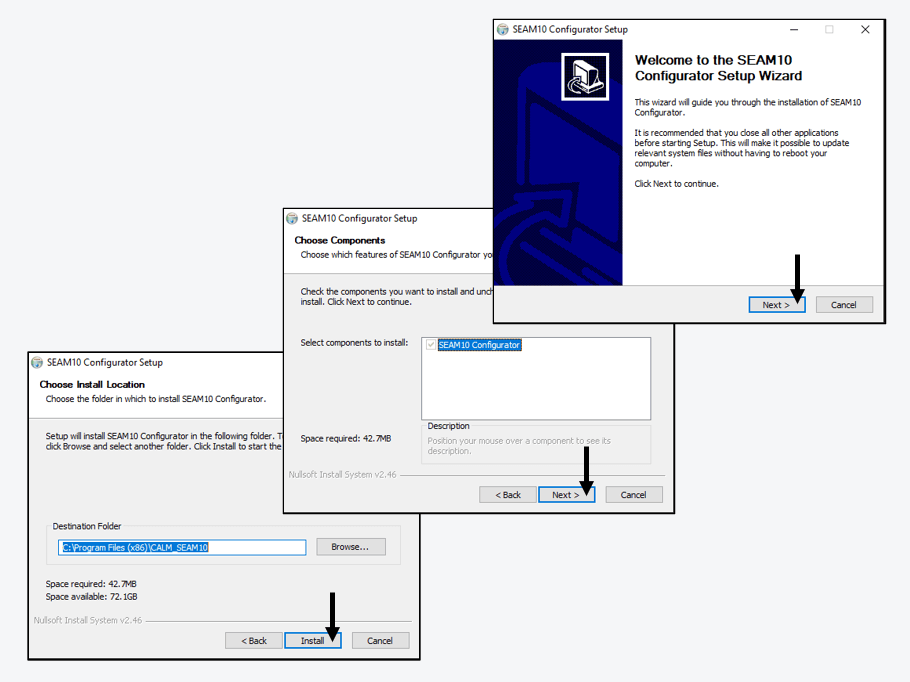 Step 4
Step 4Click "Next" twice and then click "Install"
 Step 5
Step 5Wait for the installation to complete and then click "Finish".
Step 6End of Procedure
-
Test Configuration
Test Configuration for the SEAM TENS Electrode Tester
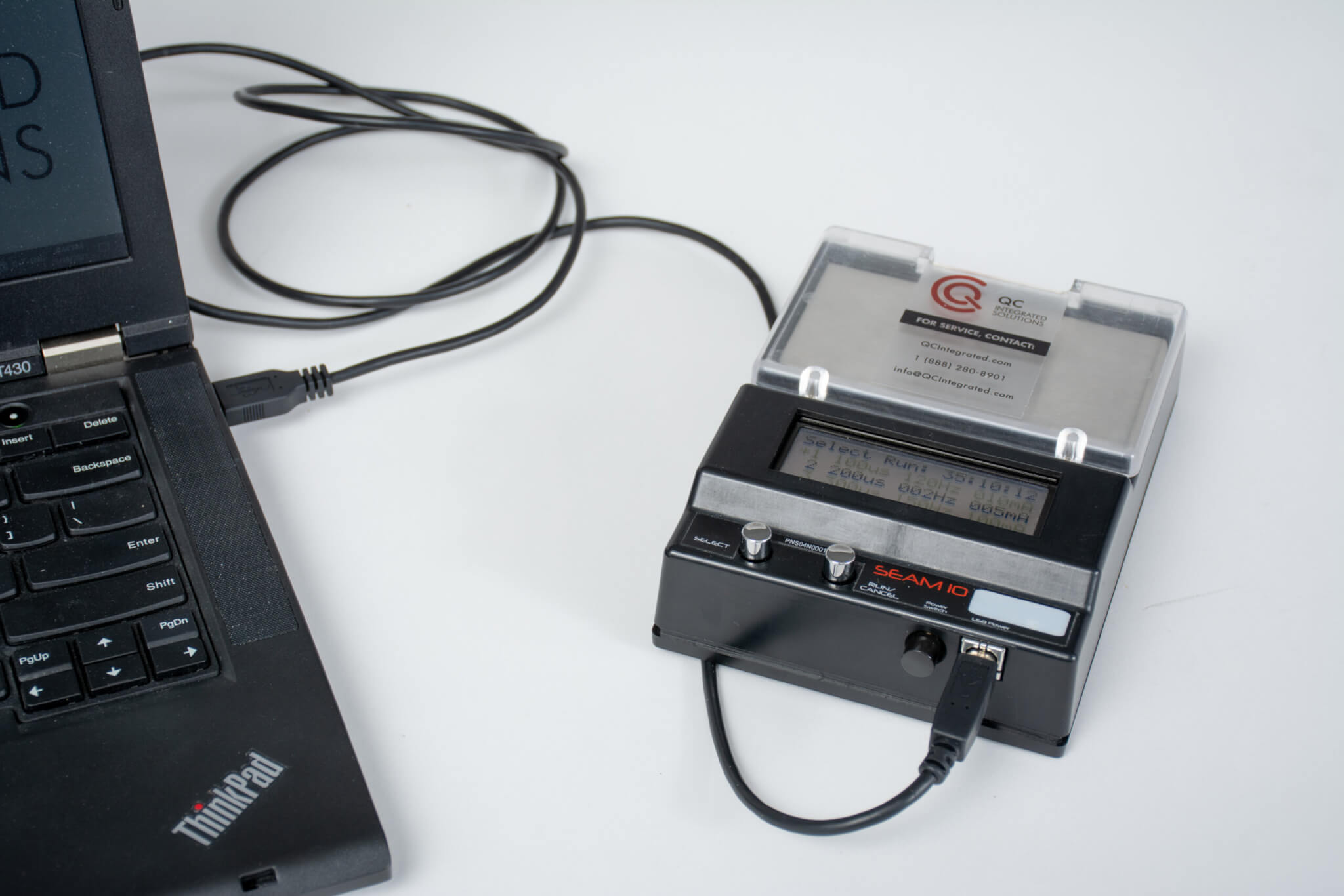 Step 1
Step 1Connect the SEAM10 Tester to the computer.
 Step 2
Step 2Open the SEAM10 Configurator on the computer and click "Connect".
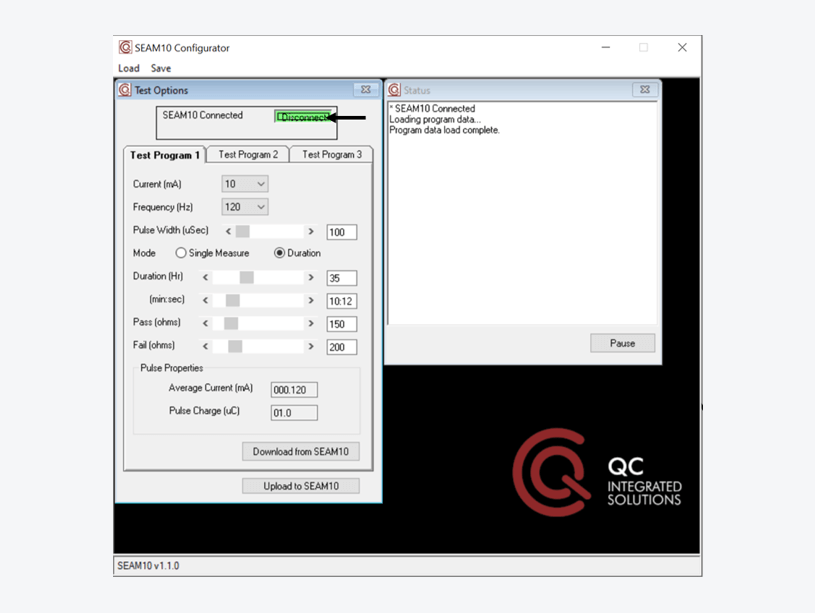 Step 3
Step 3Verify that the connection was successful.
The "Connect" button will turn GREEN.
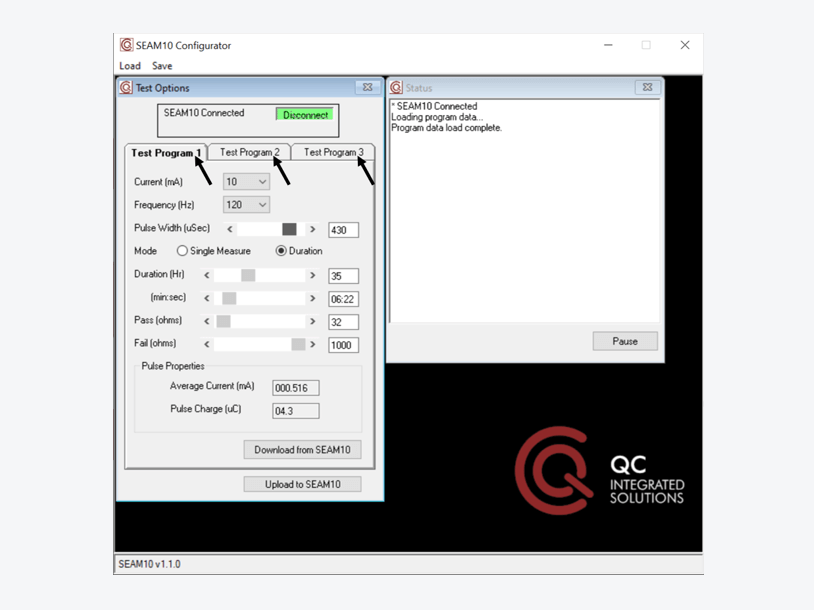 Step 4
Step 4The SEAM10 Tester holds 3 test programs. You can view each test program by clicking on its tab.
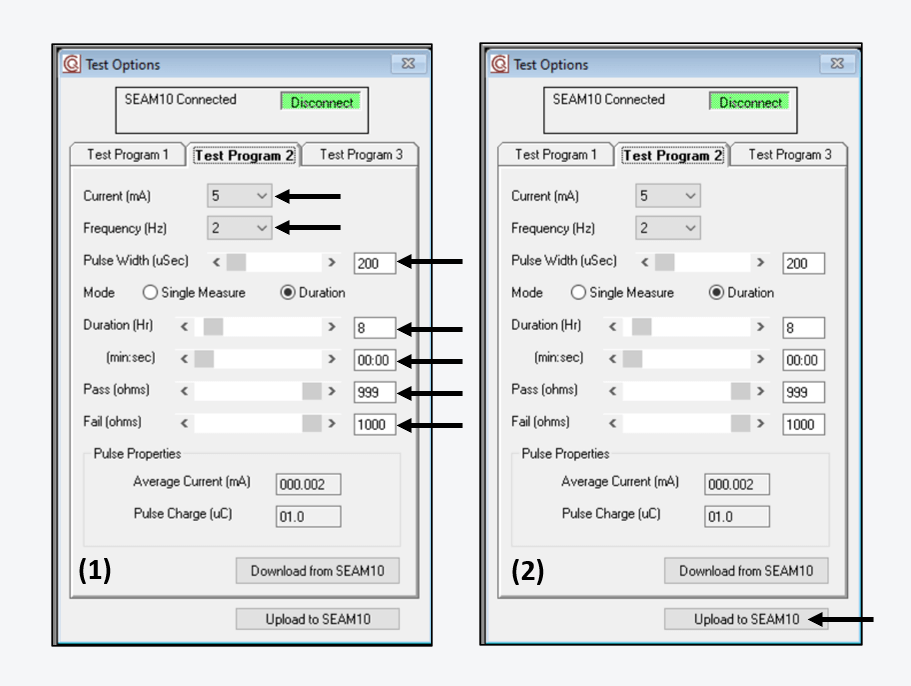 Step 5
Step 5A test program can be updated by changing the parameters in a tab and clicking on "Upload to SEAM10".
Step 6End of Procedure
-
Running a Gel-to-Plate Test
Running a Gel-to-Plate Test with the SEAM TENS Electrode Tester
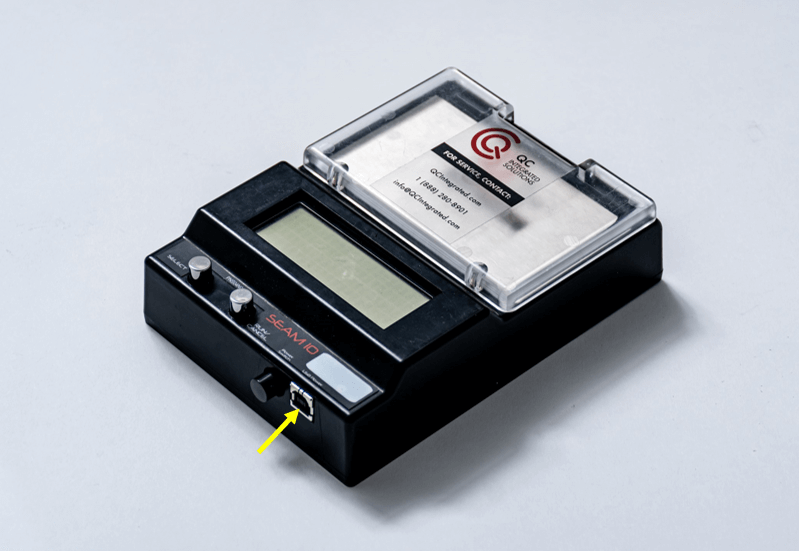 Step 1
Step 1Connect the tester to the 5 VDC power adapter.
A computer can be used as a power supply, however, extended use can cause additional wear to the USB port.
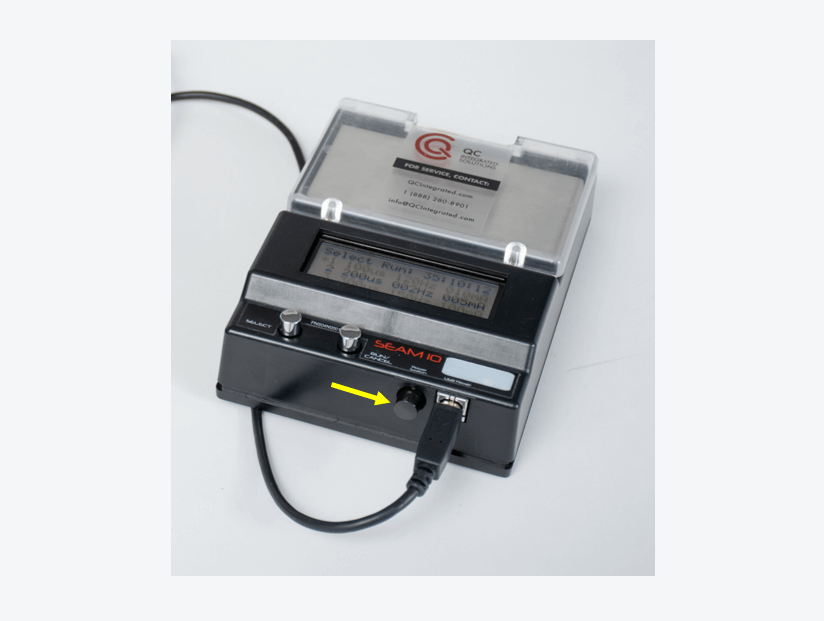 Step 2
Step 2Turn the tester on by pressing the power button.
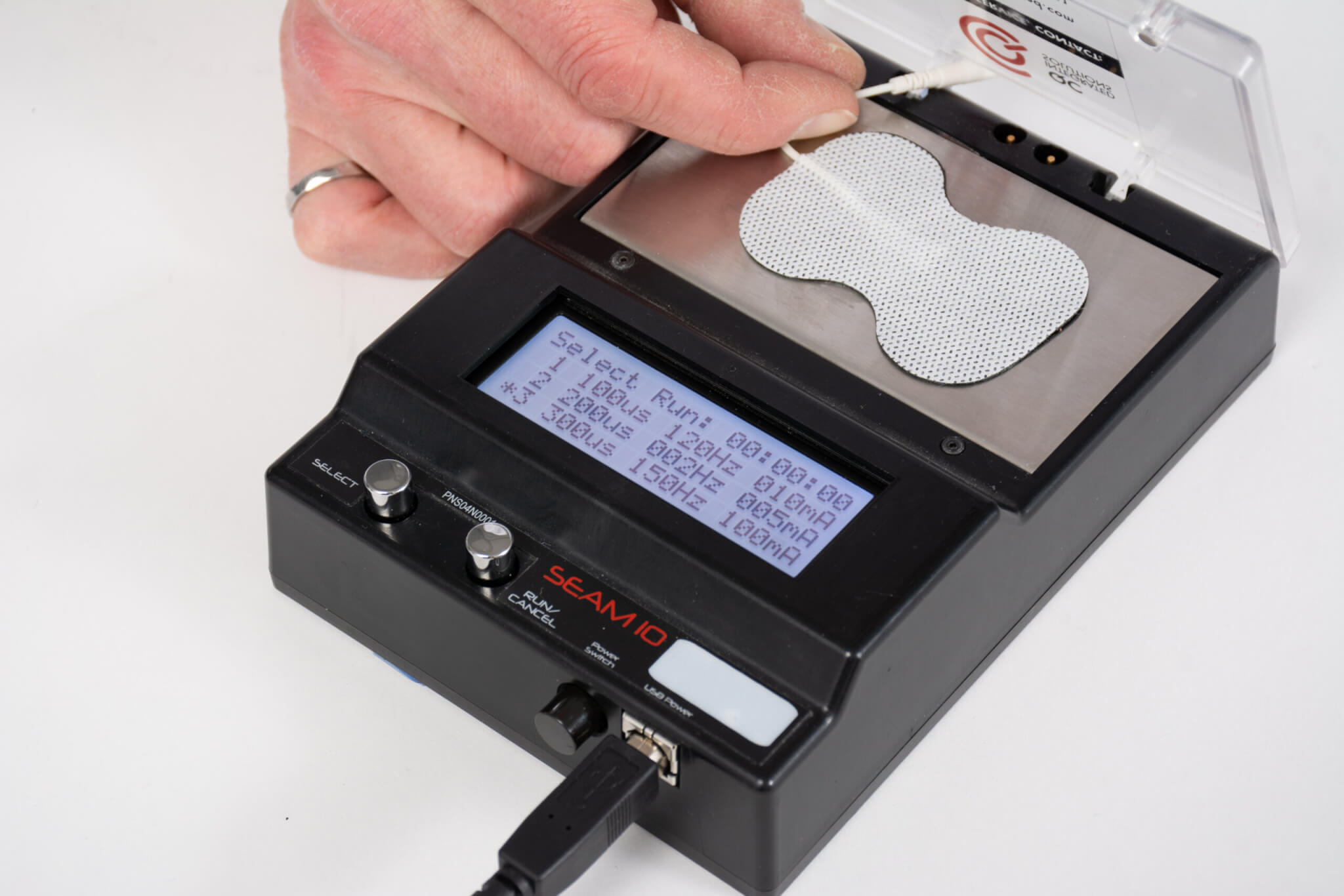 Step 3
Step 3Open the lid and apply the TENS electrode to the plate.
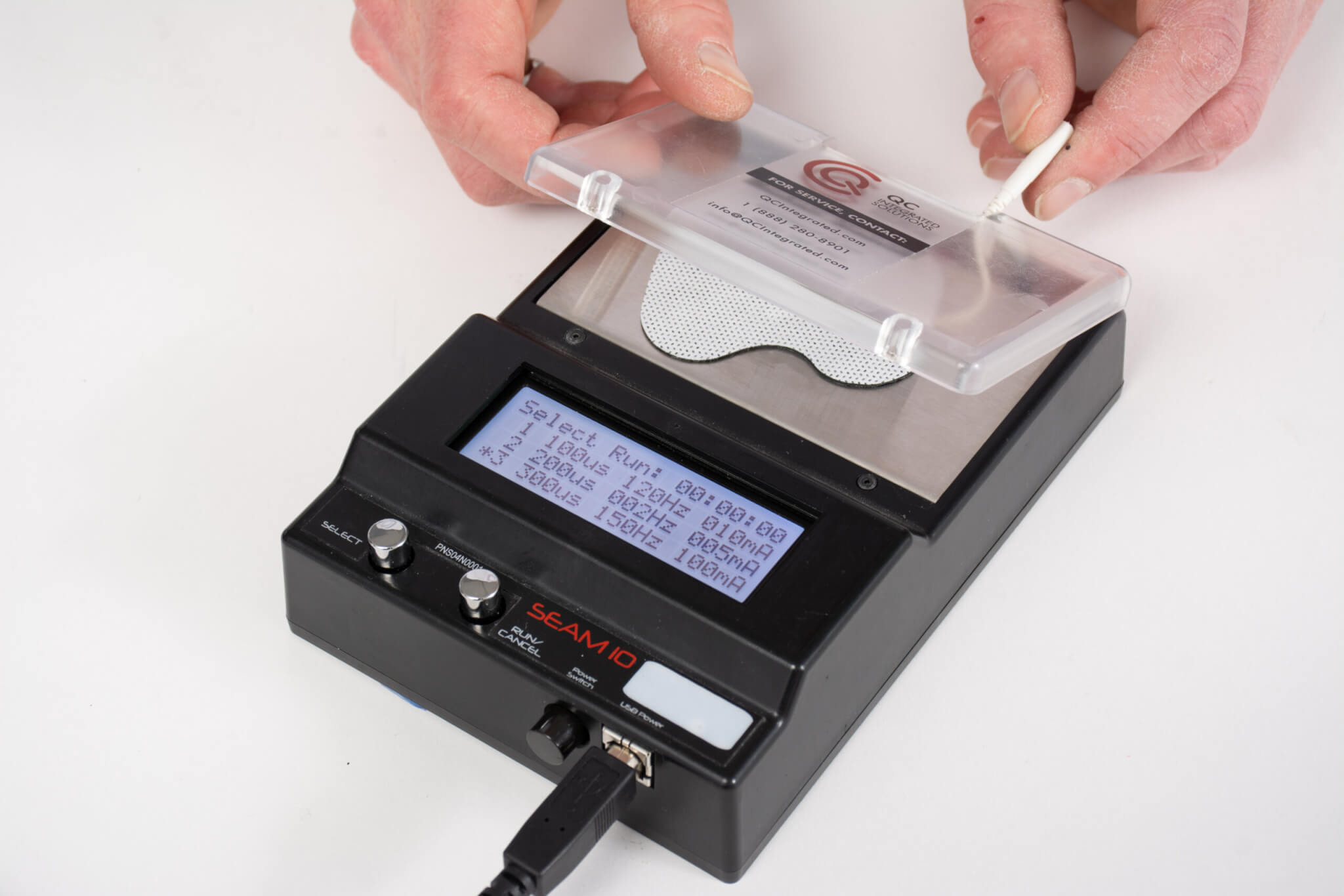 Step 4
Step 4Feed the leadwire through the space between the tester and lid.
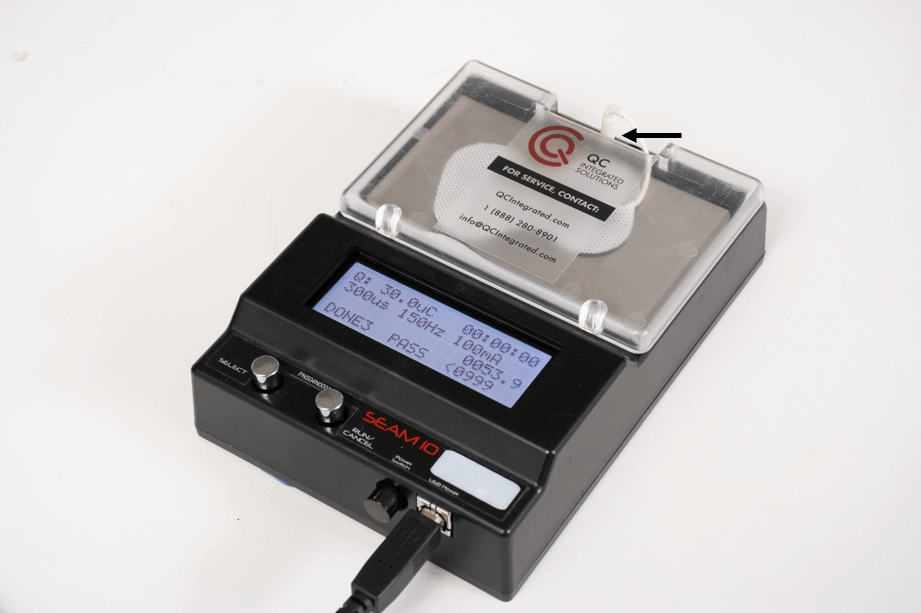 Step 5
Step 5Install the leadwire into the tester.
Make sure that the lid closes completely. If not, the test will not run.
 Step 6
Step 6Use the "Select" button to choose the test program you wish to run.
 Step 7
Step 7Start the test using the "Run" button.
 Step 8
Step 8Wait for the test complete.
The impedance measured will be approximately half the impedance measured by a gel-to-gel sample.
Step 9End of Procedure
-
Running a Gel-to-Gel Test
Running a Gel-to-Gel Test with the SEAM TENS Electrode Tester
 Step 1
Step 1Connect the tester to the 5 VDC power adapter.
A computer can be used as a power supply, however, extended use can cause additional wear to the USB port.
 Step 2
Step 2Turn the tester on by pressing the power button.
 Step 3
Step 3Prepare your sample by connecting the electrodes gel to gel.
 Step 4
Step 4Remove the plug to expose "Dual/Cal" pin.
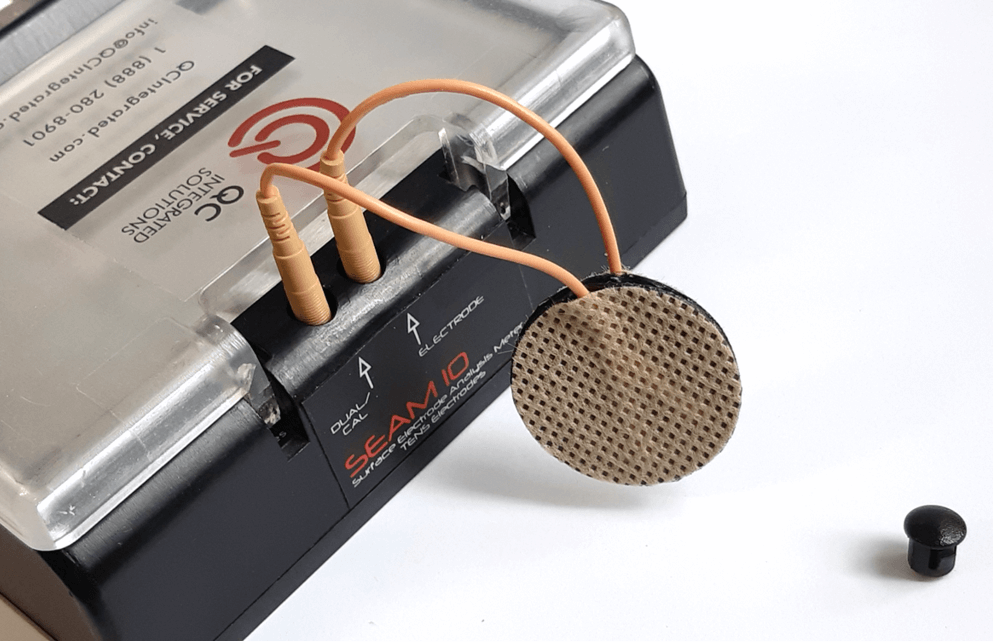 Step 5
Step 5Connect the sample to the tester.
 Step 6
Step 6Use the "Select" button to choose the test program you wish to run.
 Step 7
Step 7Start the test using the "Run" button.
 Step 8
Step 8Wait for the test complete.
The impedance measured will be approximately twice the impedance measured by a gel-to-plate sample.
Step 9End of Procedure
SEAM AED Electrode Test Platform

Resources
- SEAM AED Application - v2.7.7
-
Software Installation
Coming soon...
For help please contact info@qcintegrated.com
-
Hardware Setup
Coming soon...
For help please contact info@qcintegrated.com
-
Creating and Running a Test Sequence
Coming soon...
For help please contact info@qcintegrated.com
We rely on QC Integrated Solutions and their SEAM ECG Electrode Platform systems to provide us with the electrical data that is required to meet our customer's stringent electrical requirements.
—Select Engineering Inc.